- Explore the Sea
- Explore the Sky
1981 - 1990
April 12, 1981
First Space Shuttle Launch First Reusable Spacecraft
The first manned mission of the Space Transportation System (STS-1), Columbia, is launched. This first flight carries a crew of two. They are mission commander John W. Young and pilot Robert L. Crippen. This mission, as well as the next three, will be a test flight to try out the spacecraft's systems. Columbia successfully orbits the Earth 36 times and returns home as the world's first reusable spacecraft.
August 25, 1981
Voyager 2 Arrives at Saturn
The Voyager 2 spacecraft arrives at Saturn and begins sending back images of the planet and its moons. The probe passes within 63,000 miles (101,000 kilometers) of the ringed planet. In addition to the planet, Voyager 2 photographs the moons Hyperion, Enceladus, Tethys, and Phoebe as well as the more recently discovered Helene, Telesto and Calypso. It also discovers 10 new moons and two new rings.
March 1, 1982
First Venus Soil Samples
The Soviet Venera 13 spacecraft lands on the planet Venus and provides the first scientific analysis of the Venusian soil. The lander also captures a few images and functions for 127 minutes before shutting down due to the intense heat and pressure on the planet's surface.
May 13, 1982
New Space Endurance Record
Soviet cosmonauts Anatoli N. Berezovoi and Valentin V. Lebedev are launched in Soyuz T-5 to rendezvous with Salyut 7 and become the first team to inhabit the space station. They return to Earth in Soyuz T-7, setting a new duration record of 211 days.
November 11, 1982
First Operational Space Shuttle Mission
The Space Shuttle Columbia begins its fifth mission into space. This is the first fully operational Space Shuttle mission. STS-5 launches with a four-member crew on a five day mission that deploys two commercial communication satellites. It also performs a number of scientific experiments including three student-designed experiments.
April 4, 1983
Maiden Voyage of Challenger
America's second Space Shuttle, Challenger, embarks on its first mission into space. The STS-6 mission includes America's first space walk in nine years. The mission deploys the first Tracking and Data Relay Satellite, TDRS-1, into orbit before landing at Edwards Air Force Base in California.
June 19, 1983
First American Woman in Space
Astronaut Sally K. Ride becomes the first American woman to travel into space on Space Shuttle Challenger mission STS-7. She is the third woman in space overall, after USSR cosmonauts Valentina Tereshkova in 1963 and Svetlana Savitskaya in 1982.
February 3, 1984
First Untethered Spacewalk
Astronaut Bruce McCandless takes the first untethered space walk using the new Manned maneuvering Unit (MMU). Over the next few days, McCandless and fellow astronaut and Robert L. Stewart perform a number of tests with the MMU to practice for a future satellite capture mission. It is later used to capture the Solar Maximum satellite and to bring it into the shuttle's payload bay for repairs and servicing.
August 30, 1984
Maiden Voyage of Discovery
The third orbiter of the American Space Shuttle fleet, Discovery, lifts off for its maiden voyage into space. During mission STS-41D, the six-member crew lunches three communications satellites and tests a new solar panel array. Discovery will eventually launch the Hubble Space Telescope and conduct the second and third Hubble service missions.
October 3, 1985
Maiden Voyage of Atlantis
Shuttle Atlantis, the forth orbiter in America's Space Shuttle fleet, begins its first mission in space. During mission STS-51J, the five-member crew performs a number of classified missions of the U.S. Department of Defense. During its operational lifetime, Atlantis will orbit the earth a total of 4,848 times, traveling nearly 126,000,000 miles (203,000,000 kilometers) or more than 525 times the distance from the Earth to the Moon.
January 24, 1986
Voyager 2 Arrives at Uranus
Voyager 2 arrives at the planet Uranus, giving us our first closeup views of the giant ice planet. The spacecraft passes within 50,600 miles (81,500 kilometers) of the planet's cloud tops. The images reveal a mostly featureless blue-green sphere composed mainly of hydrogen and helium along with ices such as water, ammonia, and and methane. Voyager 2 also discovers 11 new moons and studies the planet's unique atmosphere, caused by its axial tilt of 97.8 degrees.
January 28, 1986
Space Shuttle Challenger Tragedy
The space shuttle Challenger explodes shortly after liftoff of mission STS-51L, resulting in the loss of the spacecraft and her seven-member crew. The accident seems especially tragic because of Christa McAuliffe, the first civilian to fly into space. She is part of the Teacher in Space program and was to hold a number of classes for school children while in orbit. The accident is caused by unusually cold temperatures and a faulty o-ring seal in one of the solid rocket boosters. NASA grounds the entire space shuttle fleet until safety updates can be made.
President Reagan's Challenger Speech
Following the tragic loss of seven American astronauts aboard the Space Shuttle Challenger, President Ronald W. Reagan delivers a solemn and heart-felt speech honoring the crew of mission 51-L. In his speech, the President acknowledges the great loss not only to the families of the brave astronauts but also to the nation and the thousands of school children who gathered to watch teacher Christa McAuliffe begin her historic mission as the first civilian in space.
February 20, 1986
Mir Station Launched
The first module of the Mir space station is successfully launched and placed into Earth orbit. Mir becomes the first modular space station in orbit. It hosts a number of successful Russian and American missions and remains in orbit until 2001 when it comes crashing down into the Pacific Ocean.
September 29, 1988
Space Shuttle Returns to Flight
The space shuttle Discovery launches from the Kennedy space center on mission STS-26, marking the shuttle's return to flight two and a half years after the Challenger accident. NASA redesigned the solid rocket boosters to make them safer. They also made a number of changes to operational procedures to prevent the communications breakdown that contributed to the Challenger tragedy.
August 25, 1989
Voyager 2 Arrives at Neptune
The Voyager 2 spacecraft arrives at Neptune, giving us our first close-up views of the blue planet and its moons. The spacecraft passes within 3,000 miles (4,950 kilometers) of Neptune's north pole. Scientists expect the planet to be a blue, featureless sphere much like Uranus. Instead, they are surprised to discover a curious dark spot and a number of dynamic, white cloud features. The Voyager spacecraft also discovers previously unknown Neptunian rings and confirms six new moons.
April 24, 1990
Launch of Hubble Space Telescope
Space Shuttle Discovery lifts off for mission STS-31, carrying the Edwin P. Hubble Space Telescope (HST). The telescope is successfully deployed, but is found to contain a seriously flawed primary mirror resulting in fuzzy images. A future Space Shuttle mission will install a corrective lens which will solve the problem and make Hubble the most powerful telescope ever created.
August 10, 1990
Magellan Arrives at Venus
U.S. spacecraft Magellan arrives at the planet Venus where is begins mapping the planet's cloud-covered surface using radar. Magellan uses synthetic aperture radar to penetrate the thick cloud layers and create a detailed map of nearly the entire surface of Venus. It also measures the planetary gravitational field. Magellan is the first planetary exploration spacecraft to be launched by a space shuttle when it is deployed by Atlantis on mission STS-30.
To search this site, type your search word(s) in the box below and click the search button:
Home Page | Explore the The Sea | Explore the The Sky
Space News | Astronomy Resources | Astronomy Events Calendar Messier Album | The Solar System | The Constellations | Celestial Objects Space Exploration | Space Games | Space Gallery | Space Links
Visit Us on Facebook | Follow Us on Twitter
All content on this site is Copyright © 1998 - 2016 by Sea and Sky. All rights reserved. Content from this Website may not be used in any form without written permission from the site owner.
Sea and Sky receives commissions for purchases made through links on this site.

SPACE SHUTTLE
By Cliff Lethbridge

SPACE SHUTTLE PROGRAM HISTORY
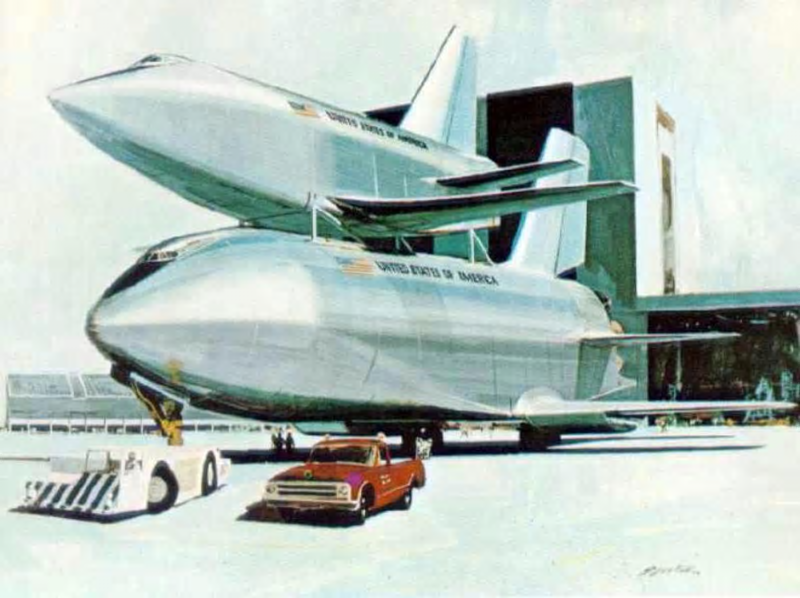
Space Shuttle Artist Conception, Photo Courtesy NASA
Born in 1968 at the height of the Apollo program, the Space Shuttle was designed to fulfill two basic roles in NASA post-Apollo manned flight objectives. The first goal of the Space Shuttle program was to provide NASA with an efficient, re-usable method of carrying astronauts to and from a permanently manned space station. At the time, NASA envisioned a space station which would be staffed by 12 to 24 people. The space station was intended to assure a permanent manned U.S. presence in space following the Apollo lunar landings. The space station would support a plethora of scientific research objectives, plus act as an engineering and support base for manned journeys to the planets. In addition, NASA believed that Space Shuttles could serve as multi-purpose satellite delivery vehicles with the potential to completely replace Atlas-Centaur, Delta and Titan rockets. The words “cheap” and “routine” were the words which most closely matched the objectives for Space Shuttles as expressed by NASA. Of course, history would prove otherwise.
On January 31, 1969, NASA issued feasibility design study contracts for their “Integrated Launch and Re-entry Vehicle” (ILRV). Invitations were given to four aerospace contractors to present design proposals on re-usable and partially re-usable manned spacecraft. These companies presented reports to NASA by November 1, 1969. They unanimously recommended a fully re-usable, two-stage vehicle. Early in 1970, NASA refined their technical requirements for the vehicle. The name “Space Shuttle” first appeared in the “purpose” section of an official invitation for production contract bids issued on February 18, 1970. The name “Space Shuttle” subsequently became a permanent fixture for the vehicle, which NASA agreed should incorporate a fully re-usable, two-stage design.
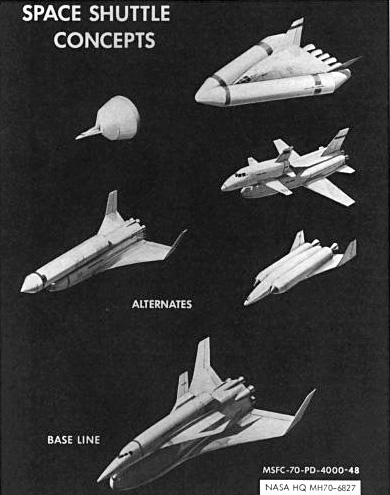
Space Shuttle Concepts, Photo Courtesy NASA
With great optimism, NASA initially expected that the first Space Shuttle would enter service by 1977. In 1971, North American Rockwell and McDonnell Douglas were granted production contracts. From that point on, development of the Space Shuttle became extremely complicated, with the future of the vehicle often in doubt from one year to the next. At first, doubts surfaced about the feasibility of developing a two-stage Space Shuttle. To analyze these concerns, NASA issued study contracts to Grumman/Boeing, Lockheed and Chrysler in June, 1971. In basic terms, the initial NASA concept for the two-stage Space Shuttle called for a smaller manned winged vehicle to sit atop a larger manned winged vehicle. These would be pad-launched from a vertical position. The larger winged vehicle would be called the “Booster”, while the smaller winged vehicle would be called the “Orbiter”. The Booster would carry the Orbiter to an altitude of about 50 miles. The Orbiter would then separate and fire its own engines to reach orbit. After separation, the Booster would turn and descend through the atmosphere for a landing near the launch site. The Orbiter would return for a landing upon the conclusion of its space mission.
The Booster would, in essence, be a fuel tank with wings. In this two-stage concept, both the Booster and Orbiter would require cockpits, hardware and instrumentation to facilitate landings. Both were designed to carry internal turbo-fan engines which would produce controlled flight during landing operations. Each vehicle would carry its own fuel tanks. As originally described by NASA in 1970, this two-stage Space Shuttle would be able to carry a 25,000-pound payload to a maximum 300-mile circular orbit. As we now know, this early two-stage concept obviously does not resemble the Space Shuttles which were eventually built. This was due to the economic realities facing NASA in the early 1970’s. In a time of general recession, it was clear that NASA could not afford to build a fleet of complicated two-stage Space Shuttles along with a space station at the same time. Utilizing the intent of the day for the Space Shuttle, one without the other made no sense at all.
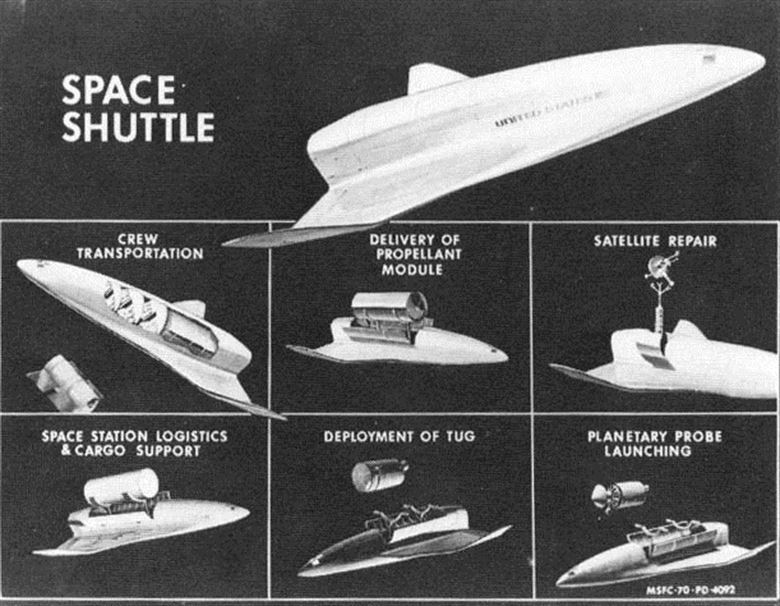
Matters were further complicated in 1971 as NASA negotiated with the U.S. Air Force regarding shared use of the Space Shuttle fleet. Military funding for the Space Shuttle program was vital if NASA hoped to build the vehicle at all. But the U.S. Air Force specified a total payload capability of 65,000 pounds for Space Shuttles capable of carrying large, sophisticated military satellites into orbit. This figure was nearly three times more than NASA had originally planned. These major factors led to a dramatic redesign of the Space Shuttle and the proposed space station. The NASA space station was originally designed following the Skylab pattern. A single multi-deck structure which made up the space station would be carried into orbit by a Saturn V rocket. Space Shuttles would then only be needed to ferry astronauts, equipment and supplies. It was thought that this type of space station would have a useful life of about ten years, at which time it could simply be replaced by another. However, an “all at once” space station did not fit the NASA budget.
NASA decided to adopt a modular concept for the space station. The space station would be built piece by piece over a period of years, with separate modules carried into orbit by Space Shuttles. This was a prudent move for NASA. Not only did it provide a more realistic approach for constructing a space station, it also made possible the production of a redesigned Space Shuttle capable of carrying heavy military payloads and even commercial satellites. In redesigning the Space Shuttle as a space station module carrier, U.S. Air Force payload criteria were met, thus assuring critical military funding. Just as important, the redesign would allow NASA to carry a plethora of satellites aboard Space Shuttles. Over time, this could produce tremendous cost savings for NASA. Not only could NASA secure private funding to carry commercial satellites aboard Space Shuttles, the costs of maintaining Atlas-Centaur, Delta and Titan rocket fleets could be phased out and ultimately eliminated.
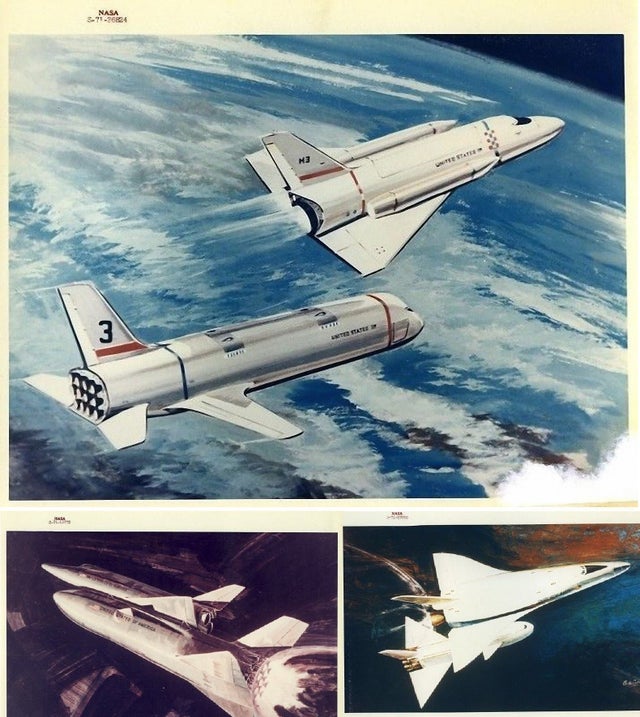
Space Shuttle Artist Conceptions, Photo Courtesy NASA
With an event like the Challenger explosion never anticipated, NASA made a decision, so to speak, to “put all of their eggs in one basket”. The Space Shuttle was to be a multi-purpose manned vehicle which would carry NASA into the next century. Even with major design modifications, NASA faced a huge price tag for its Space Shuttle fleet. On July 1, 1971, NASA granted four-month contract extensions to Rockwell and McDonnell Douglas to come up with methods of cutting their projected $10 billion development costs. The contractors decided that the most suitable method of cutting costs was to scrap the manned Booster stage of the Space Shuttle. NASA opted instead to create a more traditional expendable system to carry the manned Orbiter into space. NASA kept the manned Booster on the drawing boards, though, in case it could be afforded at a later date. Reduction in the overall size and complexity of the Space Shuttle booster system and redesign of the Orbiter did provide cost savings, but additional changes were ahead.
A smaller version of the Orbiter, called Mark I, was planned initially. This could later be replaced by a larger Mark II version of the Orbiter. The development of the Mark I and Mark II Space Shuttle fleet was to be phased in over a period of several years. The Orbiter itself could be scaled down considerably as NASA agreed to use external fuel tanks to carry the fuel the spacecraft would need to reach orbit. In previous designs, the Orbiter would carry its own fuel tanks on board. In September, 1971, Boeing proposed using a modified S-IC first stage from the Saturn V to act as a main fuel tank for the Space Shuttle. In one version, the S-IC could be equipped with a crew compartment, wings and aerodynamic equipment to facilitate a manned Booster landing. The “Re-usable S-IC” Booster, called RS-IC, would carry the Orbiter aloft. Following separation, the Orbiter would reach orbit powered by its own engines, fed by two external liquid hydrogen tanks which would be jettisoned in space. The RS-IC would then return for a landing.
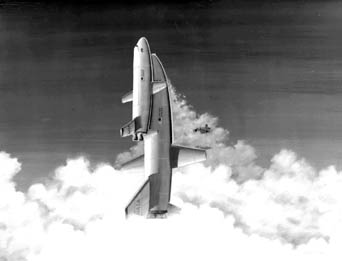
A more cost-effective version involved using a modified S-IC Saturn V first stage as an unmanned Booster which would be attached to a large external fuel tank. This array would be mated to the Orbiter. The S-IC would then act as an expendable Booster which would separate at an altitude of about 45 miles, leaving the Orbiter to reach orbit using its own engines fueled by the remaining single external fuel tank which would be jettisoned in space. With the exception of the S-IC booster, this design was somewhat similar to the vehicles which eventually flew. The S-IC option was scrapped because the booster burned liquid oxygen and kerosene. This fuel combination was deemed too inefficient for the Space Shuttle.
Space Shuttle development contracts for Rockwell, Grumman/Boeing and Lockheed were extended through February, 1972, and two core concepts for the spacecraft emerged. These were divided into parallel burn and series burn concepts. In the parallel burn concept, the Orbiter’s engines ignited at the same time as the Booster. The Orbiter’s engines would fire all the way to orbit, which would require them to be fed by a large external fuel tank. The Booster system would be jettisoned at some point during ascent. Initial options for the Booster called for various combinations of large or medium-sized solid rocket boosters with the possibility of high-pressure liquid fuel assist. One popular parallel burn Booster combination called for two large solid rocket boosters to be assisted by four smaller solid rocket boosters which would be strapped to the Orbiter’s large external fuel tank.
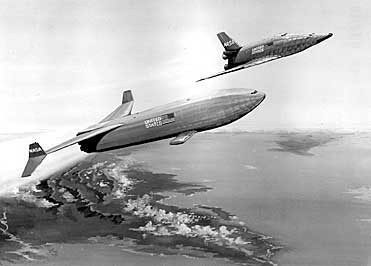
In the series burn concept, or multi-stage approach, the Orbiter’s engines would still be fed by an external fuel tank. However, the Orbiter’s engines would not fire until a first stage Booster had first been expended in flight. Series burn first stage arrays on the drawing board for the Space Shuttle called for various combinations of clustered solid rocket boosters, clustered modified Saturn V F-1 engines or new high-pressure liquid fueled engines. NASA again encountered development difficulties because all of the parallel and series burn concepts presented proved to be too expensive to be manufactured under tight budgetary constraints. A company named Mathematica was retained by NASA to perform an economic analysis of the entire Space Shuttle program. The company would recommend the most cost-effective design for the vehicle, as well as tally funding alternatives such as commercial launch revenue.
Mathematica did provide some encouragement at a critical time for NASA. It was almost immediately determined that the U.S. manned space program would be more cost-effectively served by Space Shuttles rather than continued use of expendable rockets like Saturn IB and Saturn V. The federal Office of Management and Budget (OMB) scrutinized NASA expenditures and the agency’s proposals for the Space Shuttle. Initial reactions of OMB to the Space Shuttle were not encouraging, so NASA took its case directly to President Richard M. Nixon. Late in 1971, there was a chance that the Space Shuttle program would be halted for more than one year. NASA had no guarantee that President Nixon would recommend any expenditures for the Space Shuttle in his fiscal year 1973 budget, which ran from July 1, 1972 to June 30, 1973. President Nixon was ready to present his fiscal year 1973 budget to the U.S. Congress in early January, 1972. If he did not endorse funds for the Space Shuttle in this budget, the program could have faced a stall until July, 1973 at the earliest.
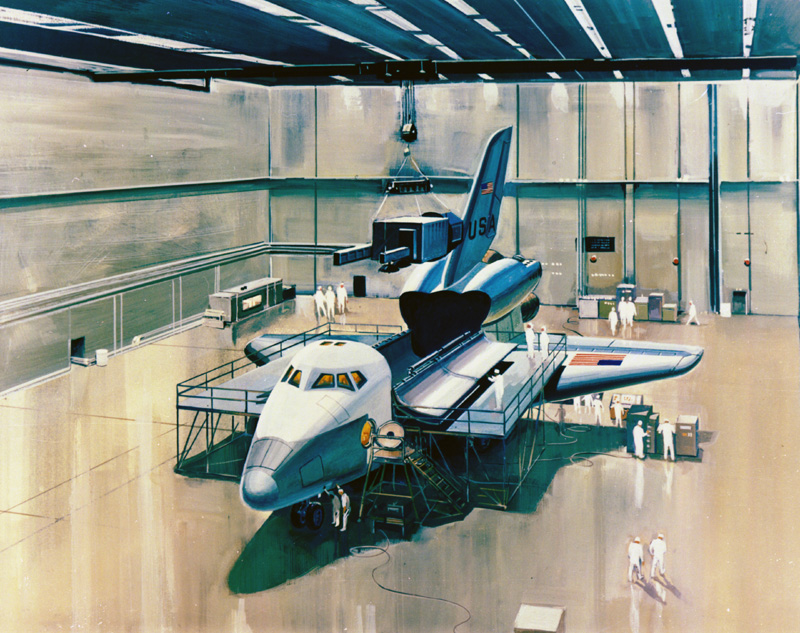
NASA Administrator James Fletcher and NASA Deputy Administrator George Low met with President Nixon for 45 minutes at the “San Clemente White House” on January 5, 1972. A decision had already been made based on previous correspondences between NASA and the President. At 11:15 a.m. Pacific Time on January 5, 1972, President Nixon announced his commitment to fund the development of the Space Shuttle. Just 19 days later, his budget was presented to Congress. Necessary funding for the Space Shuttle was ultimately approved. NASA still lacked a firm design for the Space Shuttle. Mathematica reported that two options remained economically feasible for the Booster stage. Either a large solid rocket booster system or a high-pressure liquid fueled Booster system were considered feasible.
A high-pressure liquid fueled series or parallel burn Booster was projected to cost $7 billion to develop and $100 per pound of payload to operate. A parallel burn Booster utilizing large solid rocket boosters was projected to cost $5.5 billion to develop and $160 per pound of payload to operate. While the Booster employing large solid rocket boosters would likely be more expensive to operate, NASA opted to take advantage of huge cost savings up front. Since costs of ultimate operation could be absorbed throughout the life of the Space Shuttle program, the parallel burn Booster using large solid rocket boosters was selected. On March 15, 1972, NASA officially announced plans to incorporate this design into the Space Shuttle. The solid rocket boosters were to be recovered and re-used following each launch. NASA claimed each solid rocket booster could be flown 100 to 500 times prior to retirement. As per this parallel burn configuration, the Orbiter’s engines would be ignited at launch and fed by liquid fuel contained in a large external fuel tank which would be jettisoned after the spacecraft neared orbit.
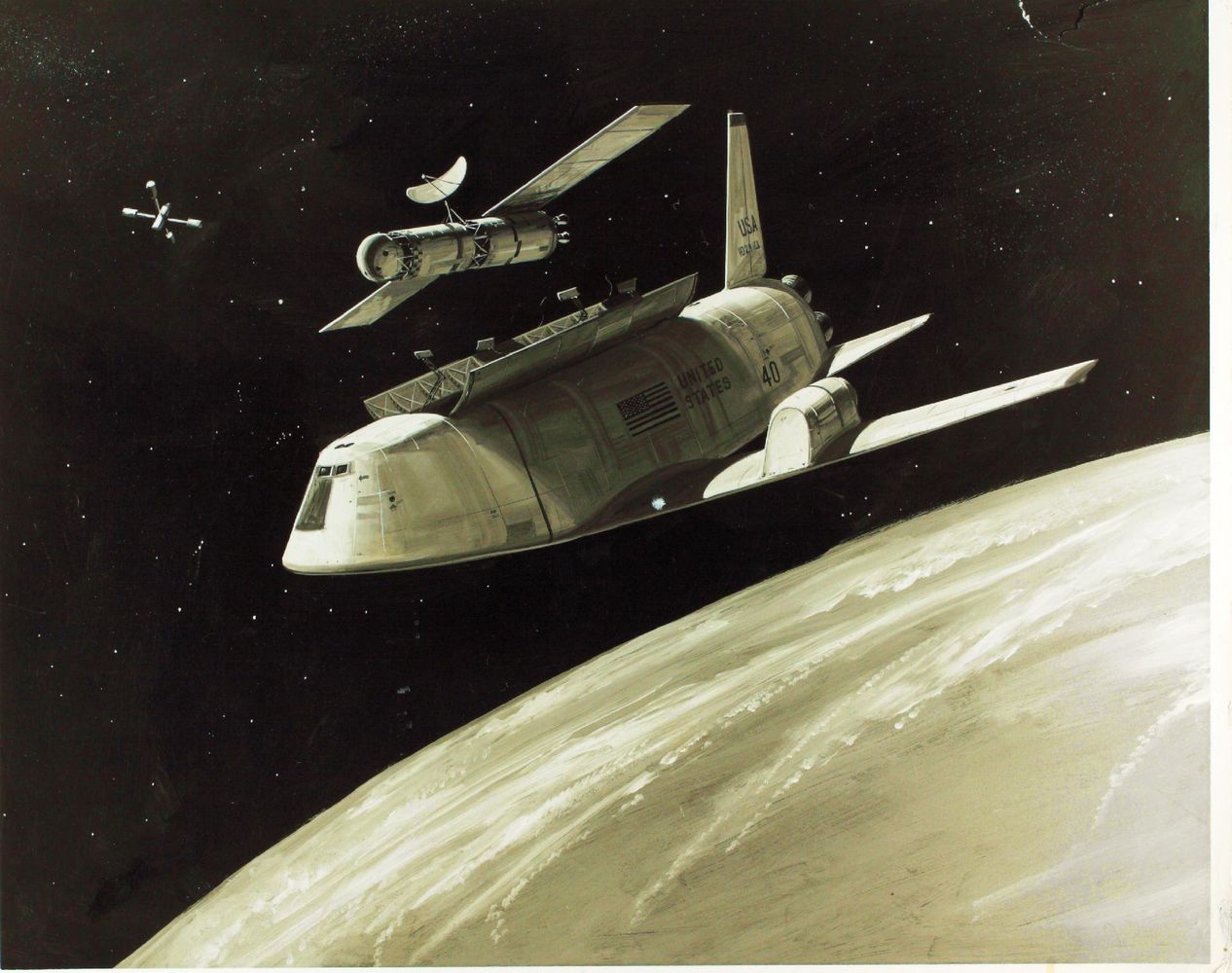
On March 17, 1972, NASA requested bids for construction of the Orbiter. Responses from Rockwell, Grumman, McDonnell Douglas and Lockheed were received by May 12, 1972. Space Shuttle Main Engine (SSME) development remained the responsibility of Rocketdyne under a contract which had already been issued in July, 1971. NASA updated their SSME specifications and submitted them to Rocketdyne in April, 1972. The International Space Division of Rockwell received the contract to develop and manufacture the Orbiter, as well as manage overall vehicle integration, on July 25, 1972. By this time, the accepted design of the Space Shuttle was quite similar to the vehicles that eventually entered service. However, a few design changes would follow. NASA made a decision to scrap two abort solid rocket motor assemblies which would have been attached to the Orbiter’s tail. During an in-flight emergency, these motors would have been fired to propel the Orbiter away from its main solid rocket boosters.
It was determined that the Space Shuttle’s main engines would be able to adequately guide the spacecraft away from the solid rocket boosters if a “Return-to-Launch Site” (RTLS) abort became necessary. In addition, two turbofan engines which would have been fitted to the Orbiter’s rear fuselage were scrapped. The turbofan engines would have enabled the Orbiter to maintain powered flight during landing operations and powered flight transfer between ground facilities. Instead, NASA decided that the Orbiter could safely glide to a landing. Point-to-point flying of the Orbiter between facilities would be accomplished by carrying the spacecraft “piggyback” atop a modified Boeing 747 aircraft. Martin Marietta was granted a construction contract for the Space Shuttle’s External Tank (ET) in August, 1973. Originally, this contract specified that a small solid rocket booster be attached atop the ET.
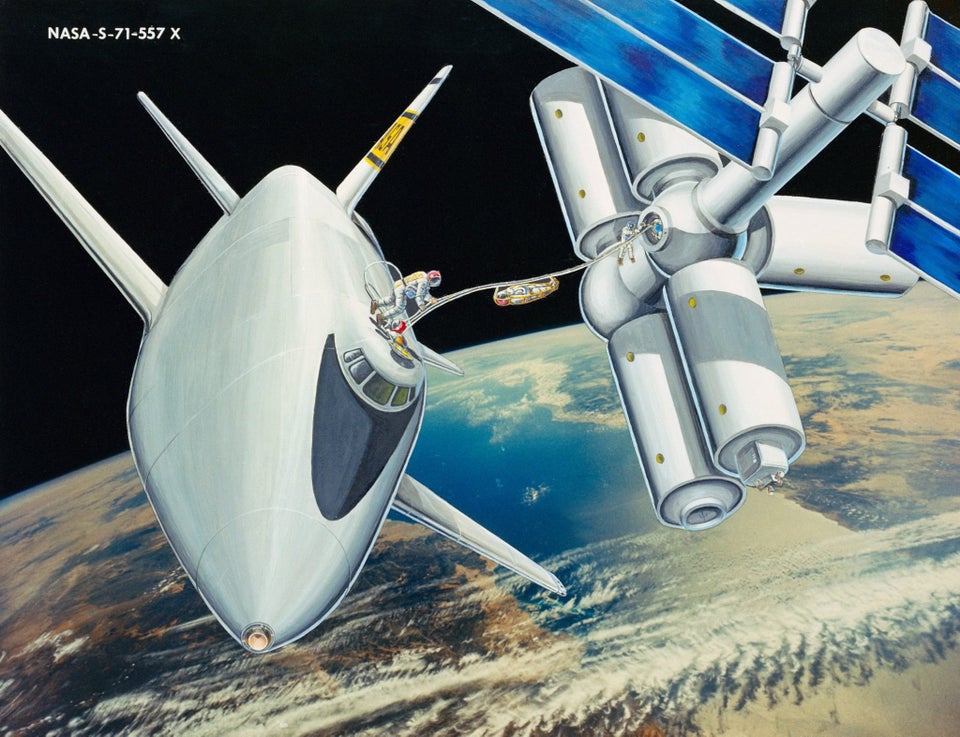
The small solid rocket booster would be fired following ET jettison to propel the tank back toward the atmosphere. However, studies indicated that the ET could not achieve orbit on its own inertia and would fall back, then break up in the atmosphere by itself. Thiokol Corporation was granted a contract to manufacture the Space Shuttle’s Solid Rocket Boosters (SRB) in November, 1973. The company had already demonstrated a successful track record of providing reliable solid rocket boosters for a plethora of rockets. A dispute regarding the SRB contract was initiated by Lockheed following its issuance. While the contract remained with Thiokol after a resolution of the action, the grievance process effectively froze the contract until June, 1974. Rockwell began work on Space Shuttle Enterprise, designated Orbiter Vehicle-101 (OV-101), on June 4, 1974. All of the subcontractors delivered their Enterprise components to Rockwell by the end of 1975.
Enterprise was rolled out of the Rockwell hangar at Palmdale, California on September 17, 1976. The spacecraft was subsequently rolled to the NASA Dryden Flight Research Center at Edwards Air Force Base, California for flight testing. Rockwell continued the development of Space Shuttles Columbia (OV-102), Discovery (OV-103) and Atlantis (OV-104). Although Enterprise was intended to be re-fitted as an operational Space Shuttle, NASA opted instead to construct Challenger (OV-099) from what was originally a high-fidelity Structural Test Article (STA-099). NASA anticipated that its full fleet of four Space Shuttles would be in complete operation by 1984. NASA would decide to build a fifth operational Space Shuttle, Endeavour (OV-105), specifically to replace Challenger, which was lost on January 28, 1986. However, a fifth operational Space Shuttle was not originally anticipated.
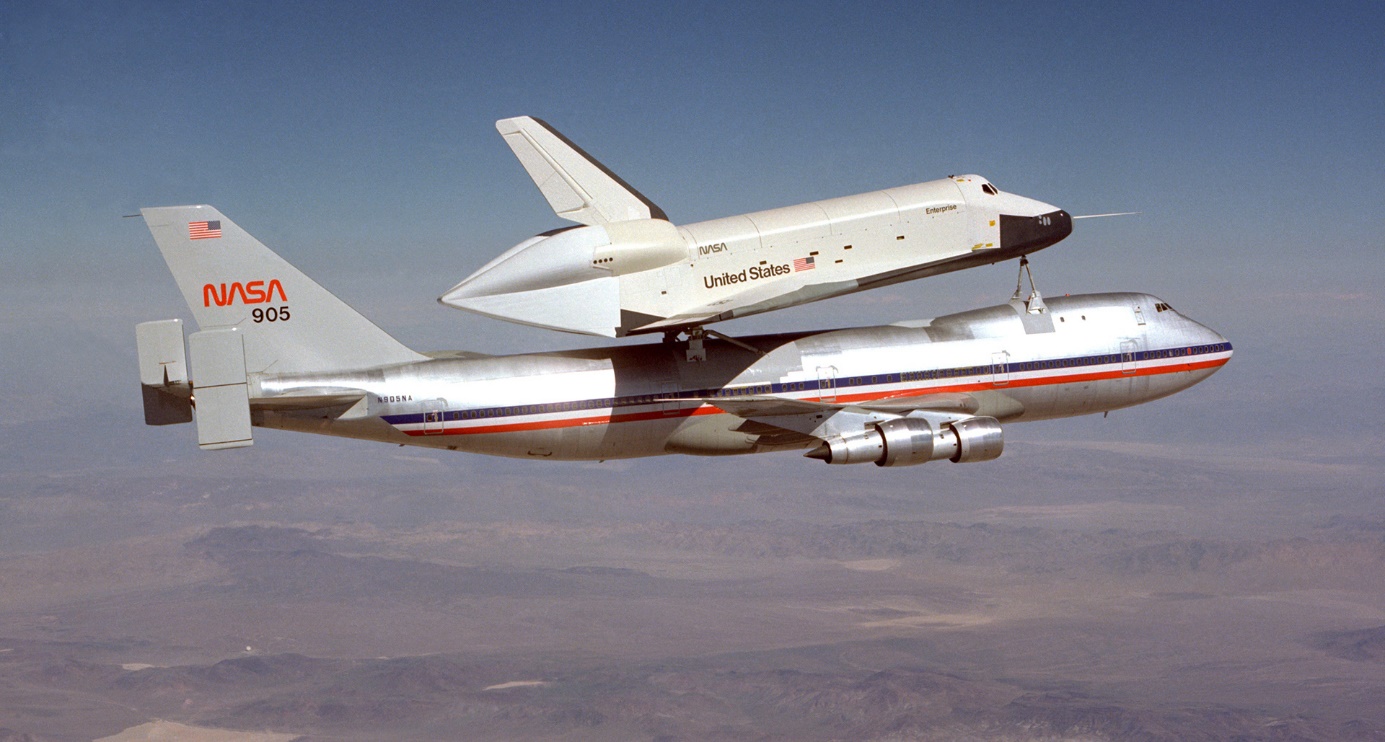
Space Shuttle Enterprise, Photo Courtesy NASA
NASA expected the Space Shuttle fleet to ultimately complete 25 to 60 missions per year. Plans called for up to 20 launches per year from each of three launch pads. Although NASA reviewed several detailed proposals for constructing virgin Space Shuttle processing, launch and landing sites in various parts of the country, the space agency wisely opted to conserve scarce resources by modifying existing facilities. The two Apollo launch pads at the Kennedy Space Center, 39A and 39B, were renovated for the Space Shuttle. A third Space Shuttle launch site was constructed at Vandenberg Air Force Base, California by renovating Titan III launch complex SLC-6, nicknamed “Slick-6”, although Space Shuttles never ended up being launched from there.
One of the first important tasks of the Space Shuttle fleet was to have been to boost the Skylab space station to a higher orbit. NASA had considered renovating and occupying Skylab as a cost-effective way of starting up a “new” space station program. When Skylab was initially abandoned on February 8, 1974 it was purposely boosted to a slightly higher orbit which varied from 269 to 283 miles. Calculations indicated that Skylab would remain in orbit for at least nine years, giving NASA ample time to get the Space Shuttle program rolling. NASA had optimistically envisioned that a Space Shuttle would be able to attempt a docking with Skylab as early as the fifth Space Shuttle flight, which was originally expected to occur as early as the latter part of 1979. The Skylab rescue mission was formally approved by NASA in September, 1977 and slated for the fifth Space Shuttle flight. In November, 1977 NASA awarded a contract to Martin Marietta for the design and construction of suitable docking and boost mechanisms.
By late 1978, National Oceanographic and Atmospheric Administration studies indicated that solar activity was forecast to become the second most intense in the century, with solar winds likely to be strong enough to increase atmospheric drag and cause Skylab to decay to much lower altitudes within a year. The revelation prompted NASA to determine how, if necessary, Skylab could be guided back to Earth in a manner necessary to avoid damage to populated areas. NASA was also prompted to step up its development of Space Shuttle hardware necessary to save the space station. Martin Marietta had already designed a teleoperator docking unit that could be remotely guided by an astronaut to dock with Skylab. Once docking was completed, engines in the docking mechanism could be fired to boost Skylab to a safe orbit. The docking unit was scheduled to be delivered to the Kennedy Space Center by August, 1979 for a Space Shuttle flight scheduled for September, 1979. Due to development delays, the September, 1979 Space Shuttle flight would be the third, not the fifth as envisioned. It was discovered that Skylab operational systems were working well, and NASA remained optimistic that the space station could be saved. But time was clearly running out. The effort to save Skylab ended abruptly in December, 1978.
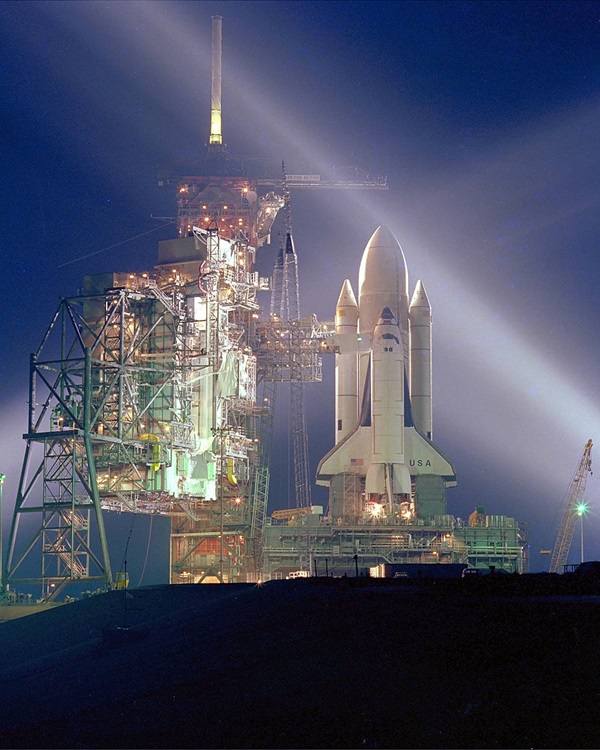
Space Shuttle Columbia, Photo Courtesy NASA
NASA had run into development problems with the Space Shuttle Main Engines, and it became clear that even the first Space Shuttle launch would not occur until well after the solar winds had increased atmospheric drag and forced the Skylab orbit to decay beyond hope of rescue. On December 15, 1978 NASA Administrator Robert Frosch informed President Jimmy Carter that Skylab could not be saved, and that NASA would attempt to guide the space station to a controlled re-entry as far away from populated areas as possible. Skylab, however, would refuse to die quietly. At 3:45 a.m. EDT on July 11, 1979 controllers at the NASA Johnson Space Center commanded Skylab to tumble, hoping the space station would break apart upon re-entry. It did not, however, break apart as expected, and at 12:37 p.m. EDT on July 11, 1979 Skylab rained debris near Perth, Australia. Although the Skylab rescue mission was never completed, the Space Shuttle fleet was slated to support the launch of a plethora of scientific, commercial and military satellites. It would also facilitate on-orbit scientific investigations and aid NASA in a slower, more methodical approach to completing a space station.
The Space Shuttle fleet was never, however, destined to perform up to 60 missions per year as intended. As NASA approached a more modest launch rate of about 24 missions per year by the late 1980’s, the Space Shuttle had already proven to be much more expensive and time-consuming to service and maintain than originally envisioned. And, the entire program was halted on January 28, 1986 when Space Shuttle Challenger exploded 73 seconds after launch. This was just the 25th Space Shuttle mission, and it became stunningly clear that major modifications to the entire Space Shuttle program were called for. With the launch of Space Shuttle Discovery on September 29, 1988 NASA entered a brand new era of Space Shuttle operations, adopting a more relaxed pace averaging about eight launches per year. Learning from one of its greatest tragedies, NASA was able to rebuild and maintain a Space Shuttle program that has been remarkably safe and reliable, with the exception of the loss of Space Shuttle Columbia on February 1, 2003.
SPACE SHUTTLE CONSTRUCTION AND OPERATION
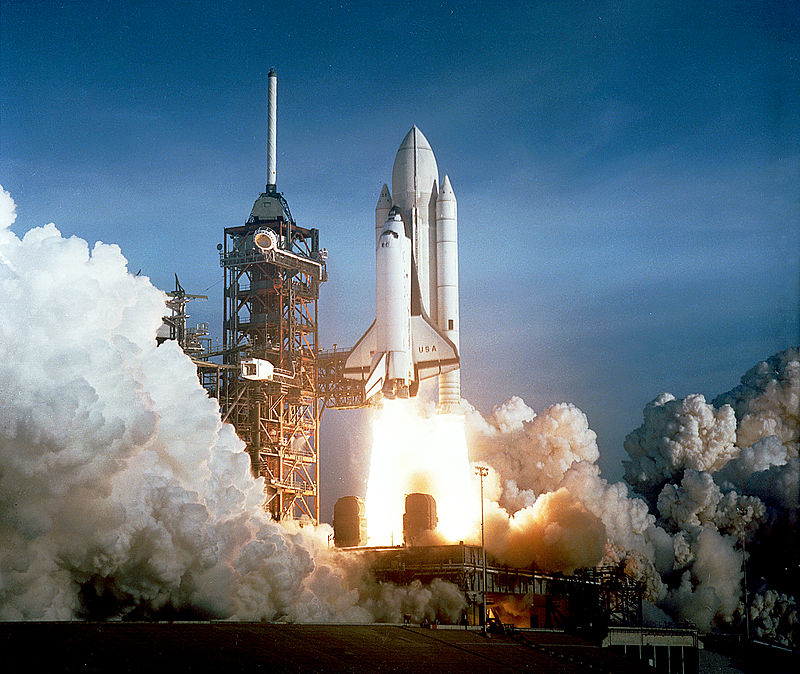
Space Shuttle Orbiter Length: 122 feet, 2 inches
Space Shuttle Orbiter Height: 56 feet, 8 inches
Space Shuttle Orbiter Diameter: 22 feet, 8 inches
Space Shuttle Orbiter Wingspan: 78 feet, 1 inch
Date of First Space Shuttle Launch: April 12, 1981
Date of Final Space Shuttle Launch: July 8, 2011
Number of Space Shuttle Launches: 135
The following information is more or less common to all Space Shuttles. Although the Space Shuttle program was retired in 2011, this information is included here for historic and research purposes.
The Space Shuttle Orbiter is constructed in major sections. These include:
1. The Forward Fuselage, which is made up of lower and upper sections that form a clamlike shell around a pressurized crew compartment. It houses the crew compartment and supports the forward reaction control system module, nose cap, nose gear wheel well, nose gear, nose gear doors and forward Orbiter/External Tank attachment.
2. The Crew Compartment, which is a pressurized three-level compartment intended to support all astronaut activities aboard the Orbiter. The Crew Compartment has a side hatch for normal crew ingress and egress which can be blown in an emergency.
The Crew Compartment also contains a hatch into an airlock from the middeck, and a hatch from the airlock through the aft bulkhead into the payload bay to support either spacewalks or access to pressurized modules in the payload bay area.
The Crew Compartment has 11 windows, including six forward windows, two overhead rendezvous observation windows, two aft payload bay viewing windows and a single side hatch window. Three panes make up each window. At a total width of nearly three inches, these are the thickest windows ever designed for see-through flight applications.
The Crew Compartment contains three levels, including a flight deck located at the top, a middeck in the center and a lower level equipment bay. The Crew Compartment is pressurized at 14.7 pounds per square-inch with an atmosphere of 80% nitrogen and 20% oxygen. This accommodates the crew with a shirt-sleeve working environment.
3. The Airlock, which is typically housed in the crew compartment middeck. The Airlock is 83 inches long and has a diameter of 63 inches. Two pressurized sealing hatches and a complement of support system hardware are contained in the Airlock. Each sealing hatch has a four-inch diameter observation window.
Depending on the mission application, the Airlock can be positioned in either the crew compartment or the payload bay in support of spacewalk activities. The Airlock can also be modified to employ a tunnel adapter hatch, tunnel adapter and tunnel to allow the crew to enter pressurized modules in the payload bay.
4. The Wings, which provide an aerodynamic lifting surface to produce conventional lift and control for the Orbiter. The left and right Wings consist of the wing glove and an intermediate section that includes the main landing gear wells.
The Wings also include a torque box, a forward spar for mounting the reusable leading edge structure thermal protection system, the wing/elevon interface, the elevon seal panels and the elevons, which provide flight control during atmospheric flight. Each Wing is 60 feet long and has a maximum thickness of 5 feet.
5. The Midfuselage, which provides a structural interface for the forward fuselage, aft fuselage and wings. It supports the payload bay doors, hinges, tie-down fittings, forward wing glove as well as various Orbiter system components. The Midfuselage provides the structural foundation for the payload bay.
6. The Payload Bay Doors, which are opened shortly after orbit is achieved to allow heat to be released from the Orbiter and to allow the release of payloads as necessary. The two Payload Bay Doors are hinged at the port or starboard side of the midfuselage and are latched at the centerline atop the Orbiter.
Thermal seals on the Payload Bay Doors provide a relatively airtight environment within the payload bay when the doors are closed. This seal is critical when ground operations require equipment and payloads to be maintained within the payload bay. Each Payload Bay Door is 60 feet long by 15 feet wide.
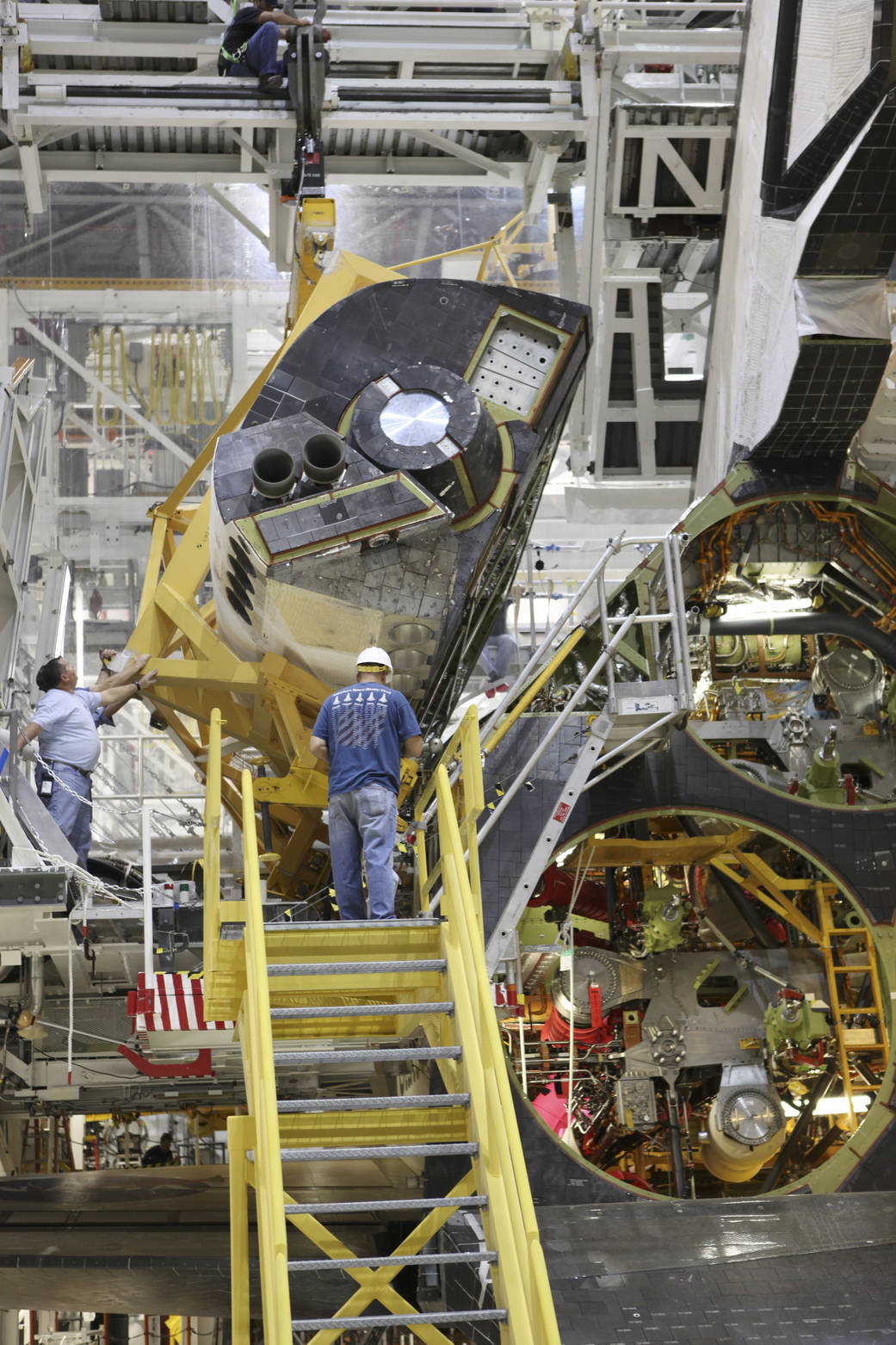
Space Shuttle Orbital Maneuvering System Pod, Photo Courtesy NASA
7. The Aft Fuselage, which consists of an outer shell, thrust structure and internal secondary structure. The Aft Fuselage supports and interfaces with the left-hand and right-hand aft orbital maneuvering system/reaction control system pods.
The Aft Fuselage also supports and interfaces with the wing aft spars, midfuselage, Orbiter/External Tank rear attachments, Space Shuttle Main Engines, aft heat shield, body flap, vertical tail and two pre-launch umbilical panels.
The Aft Fuselage outer shell allows access to systems installed within the structure. The Aft Fuselage thrust structure supports the three Space Shuttle Main Engines and their hardware. The Aft Fuselage internal secondary structure houses hardware and wiring for auxiliary power unit, hydraulics, ammonia boiler and flash evaporator systems.
8. The Orbital Maneuvering System/Reaction Control System Pods, which are attached to the upper aft fuselage left and right sides and contain all of the Orbital Maneuvering System (OMS) and Reaction Control System (RCS) propulsion elements that are located at the aft of the Orbiter.
9. The Body Flap, which provides a thermal shield for the three Space Shuttle Main Engines during re-entry and provides the Orbiter with pitch control trim during atmospheric flight.
10. The Vertical Tail, which consists of a structural fin surface, a rudder/speed brake surface, a tip and a lower trailing edge. The Vertical Tail provides aerodynamic stability for the Orbiter during flight, and its rudder can be split into two halves to act as a speed brake during landing.
The Space Shuttle Orbiter remains the most complex flying machine ever built, and is made up of operational systems which include:
1. The Thermal Protection System, which consists of various materials that are applied to the Orbiter external skin to help maintain the skin at acceptable temperatures during flight. Additional thermal protection is provided by insulation installed inside the Orbiter.
Thermal protection materials protect the Orbiter from all temperatures above 350 degrees Fahrenheit experienced during ascent and re-entry. These materials also protect the Orbiter in a range of temperatures from minus 250 degrees Fahrenheit to 3,000 degrees Fahrenheit experienced while in orbit.
A number of different materials are used in the Thermal Protection System, including reinforced carbon-carbon, black high-temperature reusable surface insulation tiles, black fibrous refractory composite insulation tiles, white low-temperature reusable surface insulation tiles, quilted insulation blankets and more specialized materials.
2. The Main Propulsion System, which is made up of the three Space Shuttle Main Engines and all of their related hardware. These include the Orbiter Main Propulsion System Helium Subsystem, Main Propulsion System Propellant Management Subsystem, External Tank interfaces and Pogo Suppression System.
In addition, the Main Propulsion System includes Space Shuttle Main Engine controllers, malfunction detection systems, hydraulic systems, thrust vector control systems and helium, oxidizer and fuel flow sequence systems.
3. The Orbiter/External Tank Separation System, which contains all of the hardware and control systems necessary to support safe separation of the External Tank from the Orbiter. This is made up of two 17-inch disconnects, an External Tank separation system and two Orbiter umbilical doors.
4. The Orbital Maneuvering System, which is made up of two Orbital Maneuvering System engines and all of their related hardware. One Orbital Maneuvering System engine is housed in each of two Orbital Maneuvering System (OMS)/Reaction Control System (RCS) pods attached to the top aft end of the Orbiter.
Each OMS engine burns a combination of monomethyl hydrazine and nitrogen tetroxide liquid fuel, and can produce a thrust of 6,000 pounds. Each OMS engine can be gimbaled to provide pitch and yaw control for the Orbiter as it maneuvers toward its intended mission orbit.
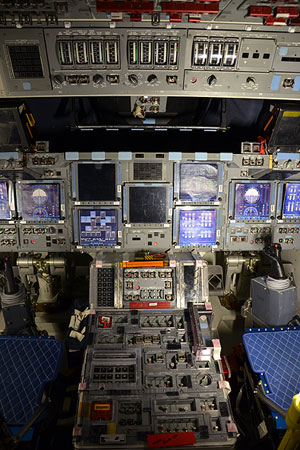
Space Shuttle Cockpit, Photo Courtesy NASA
5. The Reaction Control System, which is made up of thrusters fired to help the Orbiter achieve a precise orbital path or perform changes in its position, and all of their related hardware. Thrusters are located at the forward end of the Orbiter and in each of the two aft Orbital Maneuvering System (OMS)/Reaction Control System (RCS) pods.
The RCS contains a total of 38 primary thrusters and 6 vernier thrusters. The forward RCS array contains 14 primary thrusters and two vernier thrusters. A total of 12 primary thrusters and two vernier thrusters are housed in each of the two OMS/RCS pods.
Each RCS thruster burns a combination of monomethyl hydrazine and nitrogen tetroxide liquid fuel. Each primary thruster can produce a thrust of 870 pounds, while each vernier thruster can produce a thrust of 24 pounds. The RCS thrusters can be fired in a plethora of combinations depending on the specific mission requirements.
6. The Electrical Power System, which provides the Orbiter with electricity. The Electrical Power System is made up of the Power Reactant Storage and Distribution Subsystem, the Fuel Cell Power Plants and the Electrical Power Distribution and Control Subsystem.
The Power Reactant Storage and Distribution Subsystem stores and delivers liquid oxygen and liquid hydrogen fuel to three Fuel Cell Power Plants. In burning the liquid oxygen and liquid hydrogen, the Fuel Cell Power Plants are each capable of producing 21,000 watts of continuous output, plus 15-minute peaks of up to 36,000 watts.
Electrical power produced by the Fuel Cell Power Plants is distributed and regulated by the Electrical Power Distribution and Control Subsystem. Prior to launch, Orbiter electricity is provided by ground systems and the Fuel Cell Power Plants. The Fuel Cell Power Plants assume full control of Orbiter power at launch minus 3.5 minutes.
7. The Environmental Control and Life Support System, which controls and regulates the astronaut life support functions of the Orbiter. Life support functions include crew compartment pressure, cabin air revitalization, water cooling, temperature control, water supply, waste collection, airlock support and crew altitude protection.
8. The Auxiliary Power Unit System, which is a storable liquid hydrazine-fueled, turbine-driven power unit that generates mechanical shaft power to drive a hydraulic pump that produces hydraulic pressure for the Orbiter hydraulic system.
The Auxiliary Power Unit System is vital to the Orbiter, since it controls hydraulic devices that gimbal the Space Shuttle Main Engines, operate various propellant valves in the Space Shuttle Main Engines and move the Orbiter elevons, body flap and rudder speed brake.
In addition, the Auxiliary Power Unit System controls devices that retract the External Tank/Orbiter 17-inch disconnects, deploy and retract the landing gear and support the braking and steering of the Orbiter at landing.
The Auxiliary Power Unit System is made up of three Auxiliary Power Units (APU) located in the aft fuselage. Each APU is identical, but each is operated independently of the others. All three APU’s are started five minutes before launch, and are turned off shortly before the Orbiter reaches orbit.
One APU is started shortly before the Orbiter makes its de-orbit burn, with the remaining two APU’s started just after the de-orbit burn is completed. All three APU’s run until the Orbiter completes its landing and rollout.
9. The Water Spray Boiler System, which cools the Auxiliary Power Unit (APU) lubrication oil and hydraulic fluid. Three independent Water Spray Boilers each serve a corresponding APU. The Water Spray Boiler System sprays water onto the APU lubrication oil and hydraulic fluid lines, thus cooling the fluids within them.
10. The Hydraulic System, which distributes the hydraulic pressure produced by the Auxiliary Power Unit (APU) System. The Hydraulic System is made up of three independent hydraulic systems, each of which is mated to a corresponding APU.
11. The Landing Gear System, which is a conventional aircraft tricycle configuration landing gear consisting of a single forward nose landing gear and a left and right main landing gear. Each landing gear includes a shock strut with two tire and wheel assemblies.
Each main landing gear wheel is equipped with a brake assembly with anti-skid protection. The nose landing gear is steerable. The landing gear are retracted and deployed by hydraulic mechanism, and are locked in position within a wheel well and protected by landing gear doors when not in use.
12. The Caution and Warning System, which is designed to warn the crew of any conditions that may adversely affect the performance of the Orbiter. The Caution and Warning System primarily consists of a set of visual and aural alarms that alert the crew when any system has exceeded or strayed from its operational limits.
13. The Orbiter Lighting System, which provides both interior and exterior lighting for the Orbiter. Interior lighting is used primarily to support crew operations. Exterior lighting is used primarily to illuminate the payload bay area in order to aid visibility during payload operations and spacewalks.
14. The Smoke Detection and Fire Suppression System, which is designed to warn the crew of any fires, as well as protect the Orbiter from any fires that might develop. The system is made up of smoke detectors, portable fire extinguishers and automatic fire extinguishers.
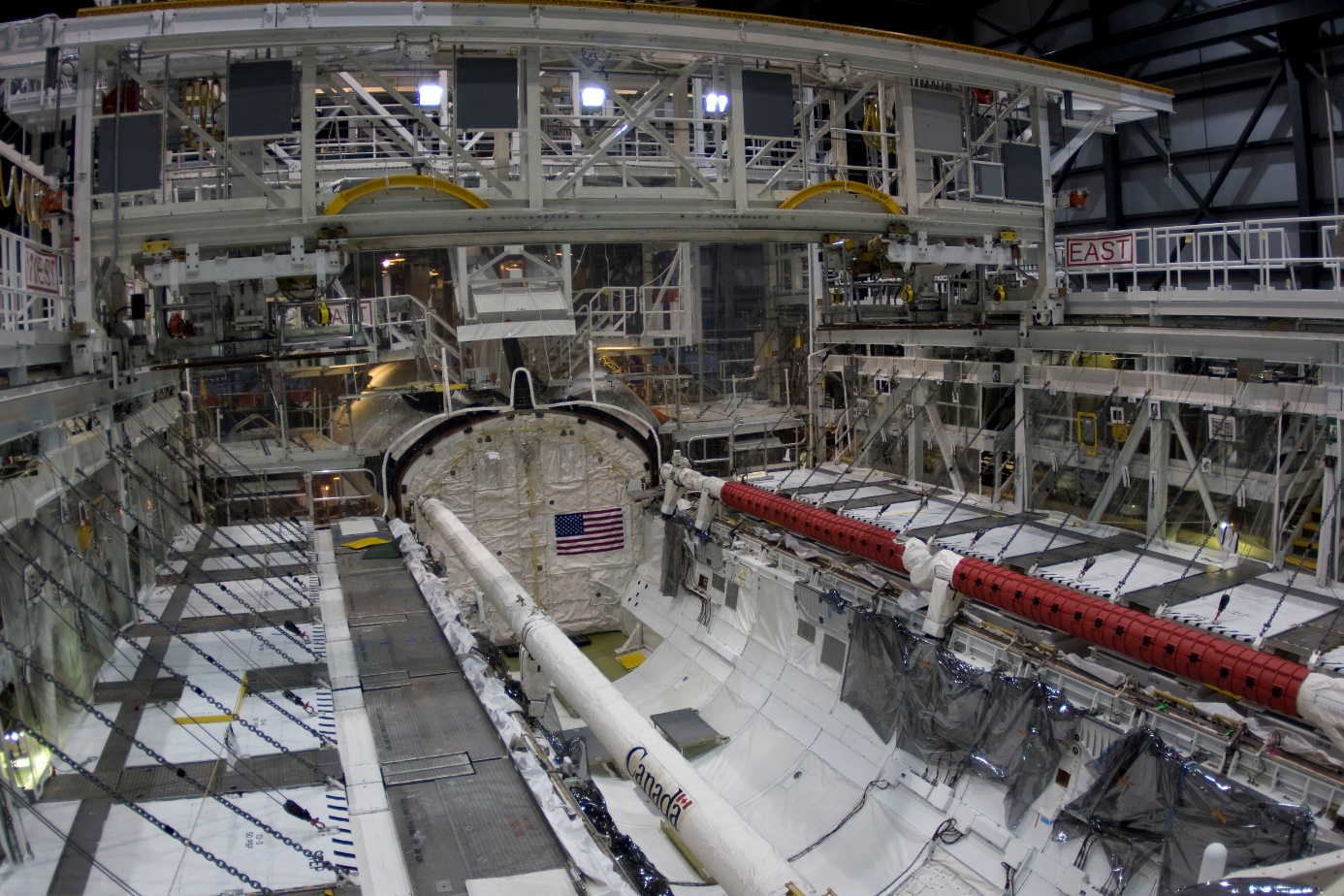
Space Shuttle Cargo Bay, Photo Courtesy NASA
15. The Payload Deployment and Retrieval System, which includes an electromechanical arm that maneuvers a payload from the payload bay and back again, plus all of its related hardware. This is more commonly known as the Remote Manipulator System (RMS), and is operated by the crew from inside the Orbiter.
The RMS can remove payloads from the payload bay for deployment. It can also grapple free-flying payloads and berth them back in the payload bay. It has been used to grapple satellites and the Hubble Space Telescope for repair and redeployment.
The RMS has also acted as an aid to astronauts participating in spacewalks. It has been used as a mobile extension ladder, work station and foot restraint for astronauts working in the payload bay during spacewalks. Cameras attached to the RMS have also been used to aid astronauts in visual inspections of the payload bay area.
16. The Payload Retention System, which is made up of a wide variety of hardware used to keep payloads secure within the payload bay. The Payload Retention System is designed to provide three-axis support for up to five separate payloads per mission.
17. The Communications System, which consists of all the equipment necessary to support the flow of voice and data transmissions to and from the Orbiter. Primary communications to and from the Orbiter flow through the NASA Space Flight Tracking and Data Network and the Tracking and Data Relay Satellite System.
The Communications System incorporates a huge and complex network of communications equipment and instrumentation. In addition to allowing both visual and aural communication with the crew, the Communications System supports a constant flow of data regarding the performance of the Orbiter, its systems and its position.
18. The Avionics System, which controls or assists in the control of most Orbiter systems. Primary functions of the Avionics System include automatic determination of Space Shuttle operational readiness, plus sequencing and control of the Solid Rocket Boosters and External Tank during launch and ascent.
The Avionics System also monitors the performance of the Orbiter, supports digital data processing, communications and tracking, payload and system management, guidance, navigation and control, as well as the electrical power distribution for the Orbiter, External Tank and Solid Rocket Boosters.
The Avionics System is made up of more than 300 computer black boxes located at various positions in the Orbiter, connected by about 300 miles of electrical wiring. A number of redundant hardware and software back-ups are incorporated within the Avionics System due to its critical nature.
Remarkably, the Avionics System is so complex that it can support fully automatic flight of the Space Shuttle from launch through landing. Although the Space Shuttle is typically guided to the runway manually during landing, the Avionics System can perform all flight functions automatically, with the exception of on-orbit rendezvous.
19. The Purge, Vent and Drain System, which is designed to produce gas purges that help regulate Orbiter temperature, prevent the accumulation of hazardous gases, vent unpressurized compartments during ascent and re-entry, drain any excess trapped fluids and keep window cavities clear.
The Purge, Vent and Drain System is made up of three separate sets of distribution plumbing located throughout the Orbiter. Purge gas consists of cool, dry air and gaseous nitrogen. Using a number of purge ports and vents, the system maintains constant humidity and temperature and assures that contaminants cannot enter the Orbiter.
20. The Orbiter Flight Crew Escape System, which is a system designed to allow the crew to escape the Orbiter under a variety of flight situations. The system consists of an Inflight Crew Escape System, Emergency Egress Slide and Secondary Emergency Egress hardware.
The Inflight Crew Escape System, introduced after the Challenger accident, allows the crew to bail out of the Orbiter during flight. It will not, however, allow the crew to escape under circumstances similar to the Challenger accident. To use this system, the Orbiter must be on a level glide path.
The specific scenario under which astronauts might benefit from the Inflight Crew Escape System would be if the Orbiter could for some reason not reach a runway. Since astronauts might not survive either a water or land ditching of the Orbiter, the Inflight Crew Escape System does provide significant advantages.
Using the Inflight Crew Escape System, the astronauts would first blow the side hatch door. They would then deploy an escape pole, which extends from the inside to the outside of the Orbiter. The astronauts would then each use hardware attached to their space suits to slide along the escape pole, then parachute to safety.
Should the astronauts need to escape the Orbiter after performing a landing, an Emergency Egress Slide can be deployed out the side hatch after the hatch is blown or opened manually. Secondary Emergency Egress is provided by blowing the left overhead window, after which hardware allows astronauts to be safely lowered to the ground.
The Space Shuttle Orbiter has proven itself to be a versatile, reliable vehicle capable of carrying out a number of tasks.
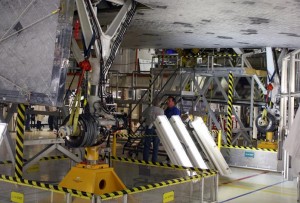
Space Shuttle Underbelly, Photo Courtesy NASA
Employing a payload bay measuring 60 feet long by 15 feet wide, the Orbiter was designed to carry payloads into space and perform missions at orbital altitudes ranging from 115 to 250 miles.
Payload capability averaged about 37,800 pounds per mission, but under certain conditions heavier payloads could be carried. An Orbiter performing a mission at a lower altitude would be able to carry a heavier payload than one performing a mission at a higher altitude.
Given Space Shuttle performance enhancements like lighter weight External Tanks and improved Main Propulsion System, Space Shuttle payload capability peaked at about 60,000 pounds.
The Orbiter was designed to carry a maximum crew of eight astronauts, although it could carry up to ten astronauts in an emergency. The Orbiter carried all of the supplies and equipment necessary for the crew to perform its mission.
The mission duration of the Orbiter was typically seven to nine days, although certain Orbiters were modified to allow missions of up to 16 days. The Orbiter afforded its occupants a shirt-sleeve environment, and never produced stresses in excess of three g’s, which is less than many amusement park thrill rides.
The Orbiter was launched in an upright position, with thrust provided by three Space Shuttle Main Engines (SSME) and two Solid Rocket Boosters (SRB). SRB separation occurred about two minutes after launch, and the SSME’s burned for about 8.5 minutes after launch.
The SSME’s shut down just before the Orbiter reached orbit. The External Tank (ET) that provided fuel for the SSME separated from the Orbiter shortly after SSME cutoff. Combinations of the 38 reaction control thrusters and six vernier thrusters are fired to stabilize the Orbiter during ET separation and helped clear the Orbiter from the ET.
Combinations of the reaction control thrusters and vernier thrusters are also fired to support attitude pitch, roll and yaw maneuvers as the Orbiter continued its ascent after ET separation. The two orbital maneuvering system engines were then fired to place the Orbiter on its proper orbit.
Once the Orbiter reached its proper orbit, the orbital maneuvering system engines could be fired again to support any major velocity maneuvers that became necessary. Combinations of the reaction control thrusters and vernier thrusters could be fired to support precision operations such as rendezvous and docking operations.
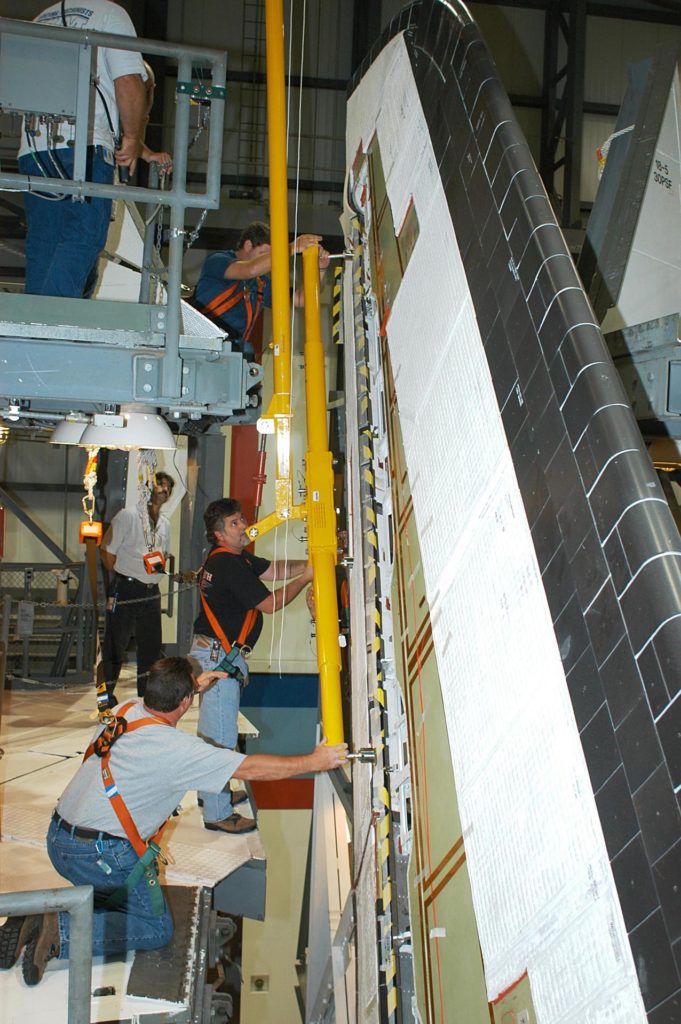
Space Shuttle Tail Fin, Photo Courtesy NASA
Once the mission was completed, the orbital maneuvering system engines were fired to slow the Orbiter in what is called the deorbit burn, or deorbit maneuver. Once in orbit, the Orbiter travelled at a speed of about 25,400 feet per second. The deorbit burn decreased the Orbiter speed to about 300 feet per second as it prepared for re-entry.
The unpowered Orbiter then re-entered the atmosphere, and is guided to a precision landing like a traditional aircraft. There were three Space Shuttle landing sites available in the United States. These were located at the Kennedy Space Center in Florida, Edwards Air Force Base in California and White Sands in New Mexico.
Once on the ground, a number of highly specialized vehicles approached the Orbiter to perform a variety of servicing and safety tasks prior to crew egress. Great care was taken to provide for the safety of the crew and prevent toxic fuels and gases from harming the environment.
The Orbiter was then routinely serviced for its next mission in a turnaround that typically took two to three months. In certain circumstances, the Orbiter was ferry-flown to California for factory modifications or major servicing.
In the event an emergency was encountered during flight, the Orbiter had several flight options available. These included:
1. Return To Launch Site (RTLS), in which the Orbiter could return to the Kennedy Space Center if all thrust was lost from one Space Shuttle Main Engine (SSME) between liftoff and launch plus 4 minutes, 20 seconds, after which time there was not enough fuel available to support this type of abort.
An RTLS abort consisted of a powered stage, at which time the SSME’s were still firing. This would be followed by an External Tank separation stage, which could not occur until after the Solid Rocket Boosters were jettisoned. Finally, the Orbiter could be maneuvered into a glide stage for a return to the launch site.
2. Transatlantic Abort Landing (TAL), in which the Orbiter could land at an overseas abort landing site if a Space Shuttle Main Engine (SSME) failed after the last RTLS abort opportunity but before any other abort could be accomplished. The TAL abort would also be attempted if an Orbiter system failure prevented any other type of abort.
Using the TAL abort, the Orbiter could complete a powered flight on a ballistic path across the Atlantic Ocean, and would then perform a glide landing at a pre-selected runway located in either the city of Moron in Spain, the city of Dakar in Senegal or the city of Ben Guerur in Morocco.
3. Abort To Orbit (ATO), in which the Orbiter could reach a lower, but safe, orbit if a propulsion failure did not allow it to reach its intended orbit. An ATO was performed during Space Shuttle Mission STS-51F, in which Challenger was able to successfully complete its mission at a lower orbital altitude.
4. Abort Once Around (AOA), in which the Orbiter could travel once around the Earth before making a landing in the United States. The AOA would be used if a propulsion failure did not allow the Orbiter to maintain any orbit, even one lower than intended.
The AOA would also be used if for some reason a system failure required the Orbiter to land quickly after it reached orbit. For all intents and purposes, an AOA would be performed in a similar manner to a normal re-entry and landing.
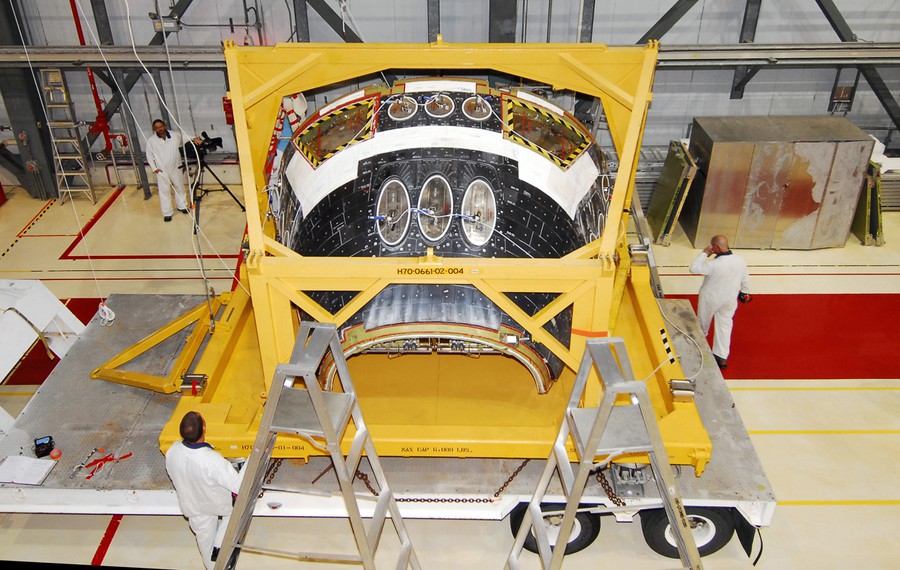
Space Shuttle Nose Assembly, Photo Courtesy NASA
5. Contingency Abort, which would be used if the Orbiter could not land on a runway. During a Contingency Abort, the Orbiter would ideally be guided to a safe glide path to allow the astronauts to use the Inflight Crew Escape System. If a safe glide path was not possible, the Orbiter would have to be ditched with the crew aboard.
The Space Shuttle Orbiter has proven itself to be a versatile vehicle, and has supported a number of diverse mission applications. These have included the deployment of a variety of scientific, military and commercial satellites and the deployment of scientific space probes.
A vast number of scientific investigations have been conducted aboard Space Shuttle Orbiters, including those performed inside pressurized laboratory modules housed in the Orbiter payload bay. Many scientific payloads have been carried in the Orbiter payload bay, including free-flying satellites that were deployed and retrieved.
Many scientific accomplishments have been made through spacewalks conducted from the Orbiter. In addition to rehearsing construction techniques for the International Space Station, astronauts have demonstrated that on-orbit repair and maintenance of satellites is possible, as are a number of on-orbit troubleshooting activities.
Space Shuttle Orbiters also have completed an ambitious docking program with the Russian Mir Space Station and the International Space Station, helping to extend an unprecedented continuous U.S. presence in space while ushering in a new era of international cooperation in space.
SPACE SHUTTLE MAIN ENGINES
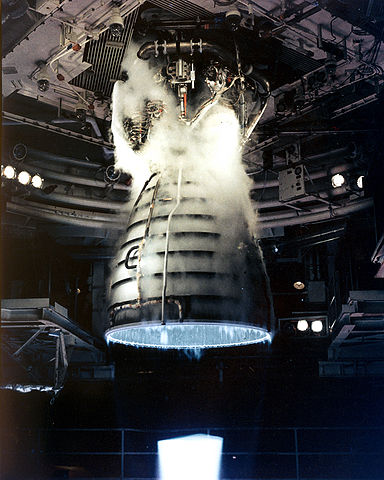
Length: 14 feet
Diameter: 7 feet, 6 inches
Space Shuttle Main Engines (SSME) were the most advanced liquid-fueled rocket engines ever built. They were manufactured by the Rocketdyne Division of Rockwell, located at Canoga Park, California. Each Space Shuttle Orbiter had three SSME’s mounted on the aft fuselage in a triangular pattern. Each SSME was designed for 7.5 hours of operation over an average lifespan of 55 starts. SSME’s burned a combination of liquid oxygen and liquid hydrogen fed from the Space Shuttle External Tank (ET). The SSME’s employed a staged combustion cycle, in which the fuels were first partially burned at high pressure and low temperature, then burned completely at high pressure and high temperature. The staged burning of fuel allowed the SSME’s to produce thrust more efficiently than other rocket engines. A rapid burning of fuel in a staged burn gave SSME’s a combustion efficiency of about 99%.
SSME thrust was variable, which was extremely important in Space Shuttle mission applications. SSME thrust could be varied from a range of 65% minimum to 109% maximum of their 100% rated power levels at precise increments of 1% as needed. A thrust value of 100%, called rated power, corresponded to a thrust of 375,000 pounds per each SSME at sea level, or 470,000 pounds of thrust per each SSME in a vacuum. A thrust value of 104%, called full power, which was typically employed as the Space Shuttle ascended, corresponded to a thrust of 393,800 pounds per each SSME at sea level, or 488,800 pounds of thrust per each SSME in a vacuum. In an emergency, each SSME could be throttled up to 109% power. This corresponded to a thrust of 417,300 pounds of thrust per each SSME at sea level, or 513,250 pounds of thrust per each SSME in a vacuum.
All three SSME’s received identical throttle commands at the same time. Throttle commands usually came from general purpose computers aboard the Orbiter. In an emergency, however, throttle commands could be controlled manually from the flight deck. Firing of the three SSME’s began at Launch Minus 6.6 seconds, at which time general purpose computers aboard the Orbiter commanded a staggered start of each SSME. The first to fire was Main Engine Number Three (right), followed by Main Engine Number Two (left) and Main Engine Number One (center) at intervals of 120 milliseconds. If all three SSME’s did not reach a mandatory thrust of 90% over the course of the next three seconds, a Main Engine Cutoff command was initiated automatically, followed by the cutoff of all three SSME’s and a number of safety functions.
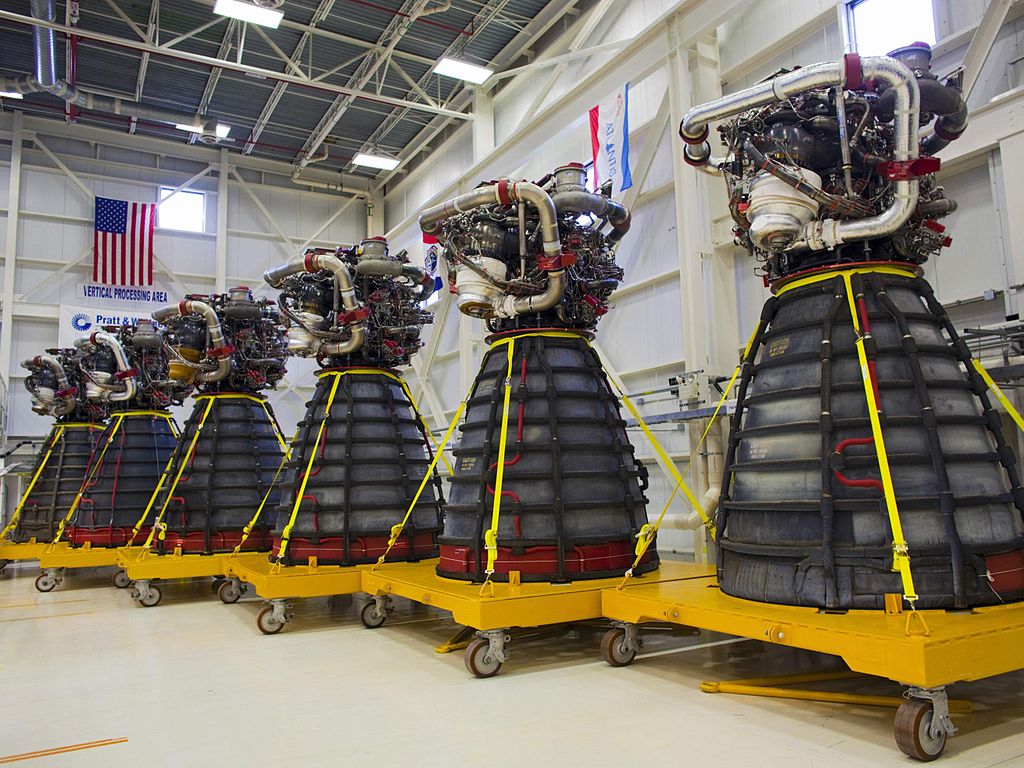
Space Shuttle Main Engines, Photo Courtesy NASA
If all three SSME’s were performing normally, the Space Shuttle could be launched. The SSME’s achieved full power at launch, but were throttled back at about Launch Plus 26 seconds in order to protect the Space Shuttle from aerodynamic stress and excessive heating. The SSME’s were throttled back up to full power at about Launch Plus 60 seconds, and typically continued to produce full power until shortly before the Space Shuttle reached orbit. During ascent, each SSME could be gimbaled plus or minus 10.5 degrees pitch and yaw to help steer the Space Shuttle. The SSME’s typically burned for about 8.5 minutes after launch. At about Launch Plus 7 minutes, 40 seconds the SSME’s were throttled down so that the Space Shuttle would not experience gravitational force in excess of three g’s. Gravitational forces in excess of three g’s might adversely affect the Space Shuttle and its crew. At about ten seconds before Main Engine Cutoff (MECO), a MECO sequence began. About three seconds later, the SSME’s were commanded to begin throttling back at intervals of 10% thrust per second until they reached a thrust of 65% of rated power, called minimum power. Minimum power was maintained for just under seven seconds, then the SSME’s shut down.
The SSME’s were controlled during flight by digital computer systems mounted on each engine. These operated in conjunction with engine sensors, valve actuators and spark igniters to provide a redundant, self-contained system for monitoring engine control, checkout and status. The SSME digital computer systems, called Main Engine Controllers, were mounted on the top of each SSME, on the outside of the combustion chamber. Each SSME had one Main Engine Controller, which consisted of two digital computers and their related electronics. In association with general purpose computers aboard the Orbiter, the SSME Main Engine Controllers were able to provide flight readiness verification, engine start and shutdown sequencing, closed-loop thrust and propellant mixture ratio control and sensor operation.
The Main Engine Controllers also produced valve actuator and spark igniter control signals, performed engine performance monitoring and limiting functions, responded to Orbiter commands plus transmitted and stored engine status, performance and maintenance data. Following MECO, the SSME’s had completed their function and were no longer needed during a Space Shuttle mission. SSME’s were thoroughly inspected, checked and tested after each Space Shuttle flight. Each SSME could be replaced or changed out as necessary. On rare occasions, SSME’s were static tested on the launch pad in what is called a Flight Readiness Firing (FRF). An FRF was typically performed when engines that had never been flown were to be used for the first time during a Space Shuttle mission. In a typical FRF, all three SSME’s were simultaneously fired for about ten seconds.
SPACE SHUTTLE EXTERNAL TANK
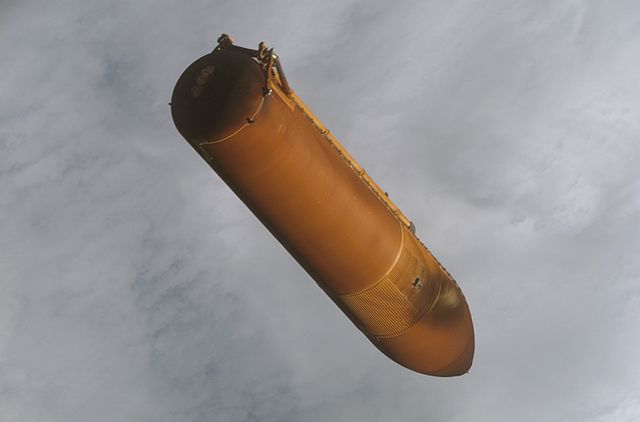
Space Shuttle External Tank, Photo Courtesy NASA
Length: 153 feet, 10 inches
Diameter: 27 feet, 7 inches
The External Tank (ET) was the only non-reusable element of the Space Shuttle. It was also the largest element of the Space Shuttle, and provided the structural backbone of the entire system. The chief purpose of the ET was to carry the liquid fuels necessary to provide power for the Orbiter’s three main engines. Martin Marietta (later Lockheed Martin) won a competitive contract to design and manufacture the Space Shuttle ET in 1973. The contract specified that the ET be constructed at the NASA Michoud Assembly Facility in New Orleans, Louisiana. The Michoud plant afforded ample space to support construction of ET’s, plus deep-water port access to allow transportation of ET’s by enclosed barge to the Kennedy Space Center. Completed ET’s were individually barged to the Kennedy Space Center in a voyage that typically took 4 to 5 days.
For many years, the ET barge was towed to and from the Kennedy Space Center by leased tug. In 1998, however, NASA opted to save money by introducing a policy of towing the ET barge to and from the Kennedy Space Center by one of the Solid Rocket Booster (SRB) retrieval ships, whose crews would otherwise have remained idle. The first ET was delivered to NASA on September 7, 1977. This was not a flight-ready ET, but rather was used for tests in association with the Space Shuttle Main Propulsion Test Article (MPTA-098) assembled at the Rockwell plant at Palmdale, California. Three test ET’s were ultimately delivered to NASA. The first flight-ready ET was delivered to NASA on June 29, 1979. The first six ET’s delivered to NASA were called the Standard Weight Tank (SWT), with each tank weighing 75,500 pounds. SWT’s were flown on Space Shuttle Missions STS-1 through STS-5 and STS-7.
During Space Shuttle Missions STS-1 and STS-2, the ET’s were painted white. NASA quickly determined that hundreds of pounds of weight and thousands of dollars in preparation work would be saved if the ET’s remained unpainted, and so all ET’s flown from STS-3 onward remained unpainted, sporting an orange-brown color. In 1979, even before a Space Shuttle had completed a space flight, NASA issued a directive that ET’s be lightened by at least 6,000 pounds so that Space Shuttles would be able to carry proportionally heavier payloads. The resulting ET was called the Lightweight Tank (LWT) which was made 10,000 pounds lighter than the SWT through several methods, including materials and design changes and the use of new fabrication techniques. The 65,500-pound LWT was first flown on Space Shuttle Mission STS-6, and then from STS-8 through STS-90.
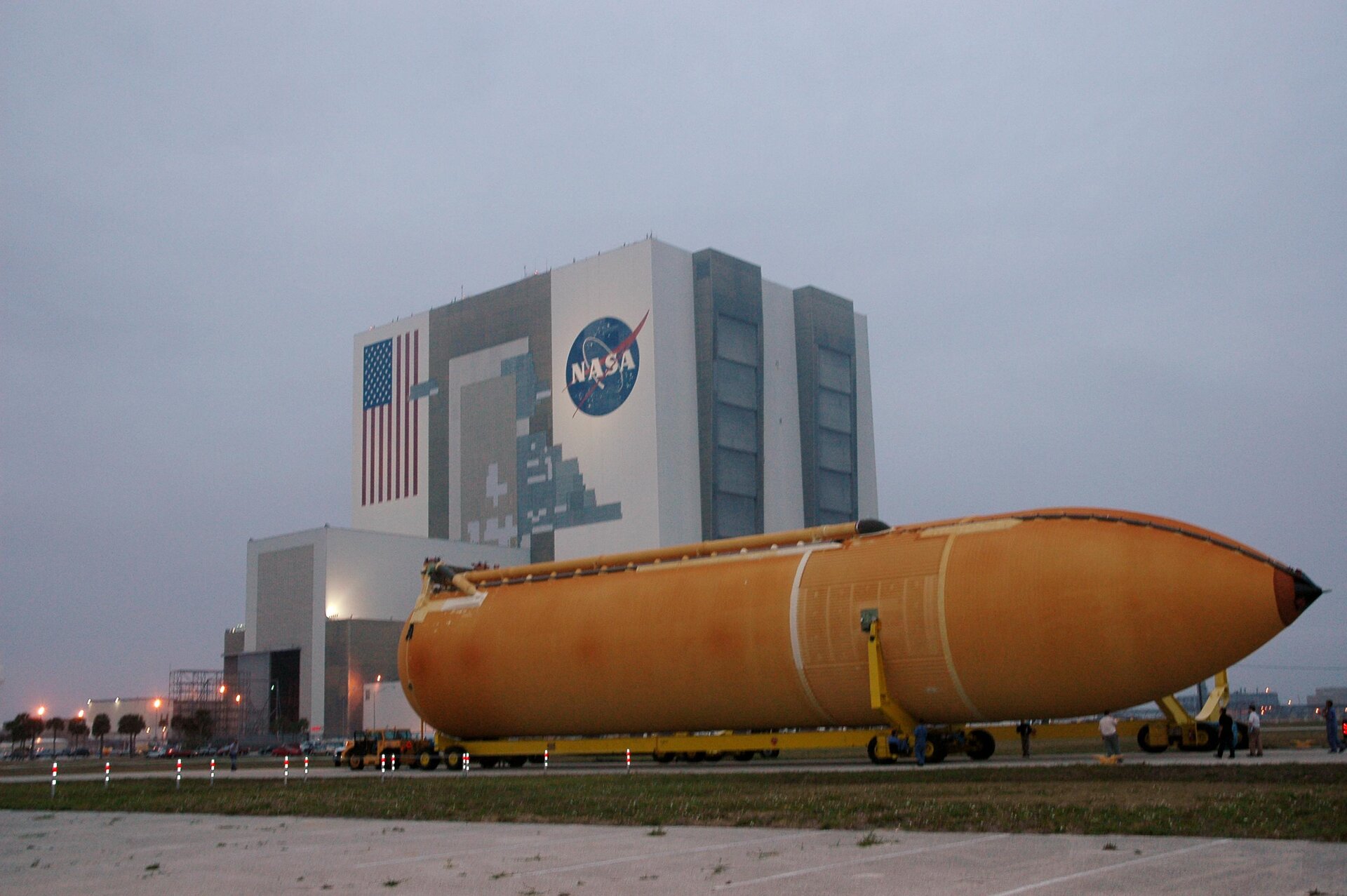
Beginning with Space Shuttle Mission STS-91, a new ET called the Super Lightweight Tank (SLWT) were flown. At a weight of 58,000 pounds, the SLWT is 7,500 pounds lighter than the LWT. The SLWT was introduced primarily to allow NASA to carry heavier payloads aboard the Space Shuttle in support of International Space Station construction. Weight savings in the SLWT were created primarily by constructing the ET from an aluminum-lithium alloy. Previous versions of the ET were constructed using an aluminum-steel alloy and titanium. In general terms, however, much about all three versions of the ET were identical. Each ET was comprised of a liquid oxygen tank located at the top and a liquid hydrogen tank located at the bottom. The liquid oxygen tank was connected to the liquid hydrogen tank by an intertank, which was located in between the other two. The intertank was designed to receive and distribute all thrust loads that the SRB’s produce during launch and flight. The intertank was able to absorb and transfer these loads evenly, providing vital structural integrity for the Space Shuttle. The intertank was 22 feet, 6 inches long by 27 feet, 7 inches wide.
The liquid oxygen tank was 54 feet, 7 inches long by 27 feet, 7 inches wide and carried 145,138 gallons of liquid oxygen weighing 1,380,000 pounds. The liquid hydrogen tank was 96 feet, 8 inches long by 27 feet, 7 inches wide and carried 390,139 gallons of liquid hydrogen weighing 230,000 pounds. Fully loaded with a total of 1,610,000 pounds of liquid fuel, the SLWT version of the ET weighed 1,668,000 pounds at liftoff. Liquid oxygen was stored aboard the ET at a temperature of -297 degrees Fahrenheit, while the liquid hydrogen was stored aboard the ET at a temperature of -423 degrees Fahrenheit. Since the liquid fuels stored inside the ET were this cold, the outer surface of the ET required thermal protection. This was provided by a one inch layer of spray-on foam insulation applied over the forward portion of the liquid oxygen tank, the intertank and the sides and bottom of the liquid hydrogen tank. This foam insulation was intended to reduce ice or frost formation on the tank, which could both increase the weight of the ET and become hazardous to the Space Shuttle during launch. The foam insulation also served to protect the ET from the effects of engine and aerodynamic heating, which could potentially cause the liquid fuel to boil.
An ablative coating made of material that flakes off as it becomes hot was applied to the ET external bulges and projections to protect them from aerodynamic heating that developed during flight. The ET also contained systems that were necessary to support its operation. These included a pressurization and vent system to regulate the tank pressure, an environmental conditioning system to regulate the temperature and humidity of the intertank area and an electrical system to distribute power and provide lightning protection. Much of this equipment is housed in the intertank. All fluid control mechanisms and valves that regulate performance of the ET, with the exception of the vent control valves, were located in the Orbiter. This was due to the cost savings over replacing this equipment after every Space Shuttle mission, since the ET could not be recovered. The ET supplied liquid oxygen and liquid hydrogen to the Orbiter’s three main engines through 17-inch diameter feed lines. The liquid oxygen was fed at a rate of 159,480 pounds, or 16,800 gallons, per minute while the liquid hydrogen was fed at a rate of 26,640 pounds, or 45,283 gallons, per minute. At launch, the ET was attached to both the Orbiter and SRB’s. The SRB’s were jettisoned from the ET about two minutes after launch. The ET typically emptied about 8.5 minutes after launch, at which time it was detached from the Orbiter, broke up and fell into a predetermined area of either the Pacific or Indian Ocean.
SPACE SHUTTLE SOLID ROCKET BOOSTERS
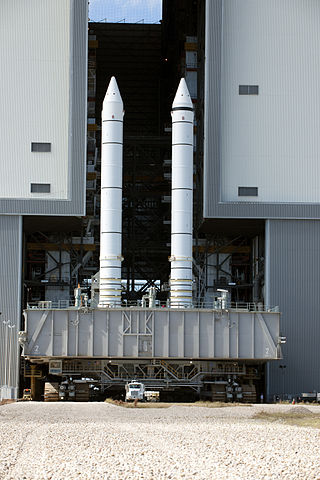
Space Shuttle Solid Rocket Boosters, Photo Courtesy NASA
Length: 149 feet, 2 inches
Diameter: 12 feet, 2 inches
The vast majority of thrust needed to launch the Space Shuttle was provided by two Solid Rocket Boosters (SRB). SRB’s were manufactured by the Wasatch Division of Morton Thiokol Corporation, located in Brigham City, Utah. In addition to providing the bulk of Space Shuttle liftoff thrust, the SRB’s supported the entire weight of the Orbiter and External Tank (ET) prior to launch. The Space Shuttle SRB’s were the largest solid-fueled motors ever built, and the first designed to be reused. Each SRB weighed about 1,300,000 pounds at launch. The solid fuel contained in the SRB weighed about 1,100,000 pounds while the inert weight of each SRB was about 200,000 pounds. The primary elements of each SRB were the motor, structure, separation system, operational flight instrumentation, recovery system, pyrotechnics, deceleration system and range safety destruct system.
Each SRB was attached to the ET at the SRB’s aft frame by two lateral sway braces and a diagonal attachment. The forward end of each SRB was attached to the ET at the forward end of the SRB’s forward skirt. On the launch pad, Each SRB was fastened to the Mobile Launcher Platform (MLP) at the SRB aft skirt by four large bolts and nuts that were severed by small explosive charges at liftoff. The propellant mixture in each SRB was made up of 69.6% ammonium perchlorate oxidizer, 16% aluminum fuel, 0.4% iron oxide catalyst, 12.04% polymer binder and 1.96% epoxy curing agent. The propellant was contained within the SRB beginning with an 11-point star-shaped perforation in the forward segment to a double-truncated cone perforation in both of the aft segments and the aft closure segment.
These varying shapes allowed the SRB thrust to be reduced by about 33% at launch plus 50 seconds. This reduction in thrust was intended to alleviate stress to the Space Shuttle as it entered its area of maximum dynamic pressure during ascent. The SRB’s employed during each Space Shuttle mission were matched pairs, each made up of four solid rocket motor segments. To minimize any thrust imbalance, the SRB pairs were matched by loading each of the four SRB segments in pairs using the same batches of solid fuel. The segmented solid rocket motor design assured maximum flexibility during manufacturing operations, and also ease of transportation. The SRB’s were transported to the launch site using heavy-duty rail cars equipped with special SRB covers. The cone-shaped aft skirt of each SRB provided one of the most vital supports for the Space Shuttle prior to launch, since it could react to loads that might shift between the SRB’s and the MLP during pre-launch operations.
Four SRB separation motors were also mounted on the aft skirt of each SRB. The aft section of each SRB contained avionics and a thrust vector control system that consisted of two auxiliary power units, hydraulic pumps, hydraulics systems and a nozzle extension jettison system. The forward section of each SRB contained avionics, a sequencer, four forward separation motors, a nose cone separation system, drogue and main parachutes, recovery beacon, recovery light, range safety system and, in certain flights, a parachute camera system. Each SRB had two integrated electronic assemblies, one at the forward and one at the aft. These assemblies provided the electronic command connections to initiate and control various functions of SRB components during flight. The SRB’s were ignited by electronic command from the Orbiter at Launch Minus Zero, provided that the Space Shuttle Main Engines (SSME) had built up enough thrust to support a launch.
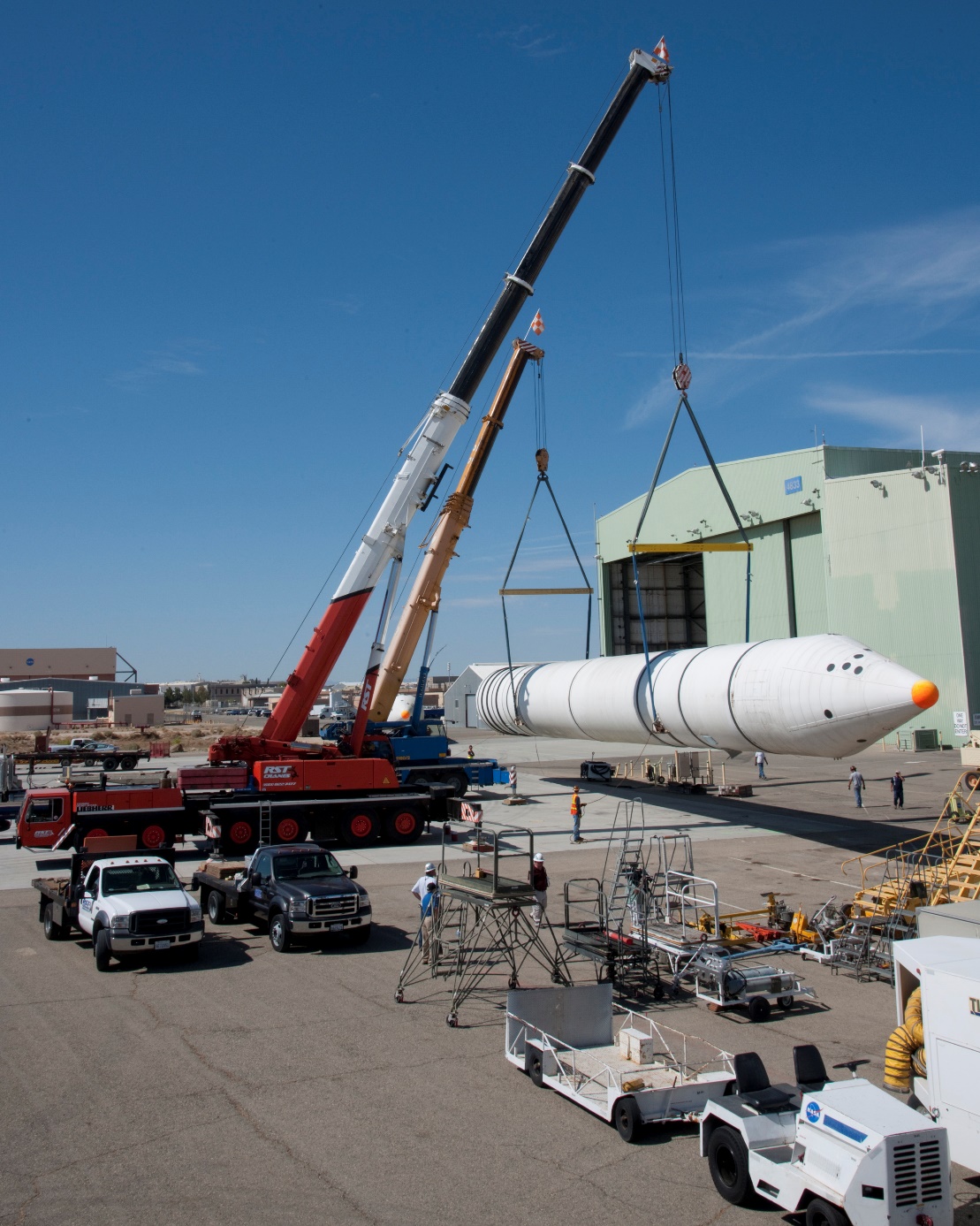
Space Shuttle Solid Rocket Booster, Photo Courtesy NASA
The SSME’s were ignited first, since the SRB’s could not be shut down once they were ignited. The results would be catastrophic if the SRB’s were ignited after an SSME failure on the launch pad. Also at Launch Minus Zero, the four bolts which held each SRB to the MLP were blown by explosive charges. Each bolt measured 28 inches long by 3.5 inches in diameter. Each SRB could produce a thrust of about 3,300,000 pounds of thrust at liftoff. The combined thrust of the SRB’s accounted for just over 70% of the total thrust needed to carry the Space Shuttle into space. Each SRB exhaust nozzle could be gimbaled up to eight degrees to help steer the Space Shuttle during ascent. About 125 seconds after launch and at an altitude of about 150,000 feet, the SRB’s burned out and were jettisoned from the ET. The jettison command originated from the Orbiter, and jettison occurred when the forward and aft attach points between the SRB’s and ET were blown by explosive charges.
Milliseconds after SRB separation, 16 solid-fueled separation motors, four in the forward section of each SRB and four in the aft skirt of each SRB, were fired for just over one second to help carry the SRB’s away from the rest of the Space Shuttle. Each of the separation motors could produce a thrust of about 22,000 pounds. The SRB’s continued to ascend in a slow, tumbling motion for about 75 seconds after SRB separation, to a maximum altitude of about 220,000 feet. The SRB’s then began to quickly fall toward the Atlantic Ocean. About 225 seconds after SRB separation and at an altitude of about 15,700 feet the nose cap of each SRB was ejected, which resulted in deployment of a pilot parachute. The pilot parachute had a diameter of 11.5 feet, and provided the force necessary to activate mechanisms which pulled the drogue parachute from its stored position.
The drogue parachute had a diameter of 54 feet, and was used to orient and stabilize the descent of each SRB to a tail-first attitude in preparation for the deployment of the main parachutes. About 248 seconds after SRB separation and at an altitude of about 6,000 feet, deployment of the main parachutes began. Three main parachutes were deployed on each SRB. Each main parachute had a diameter of 136 feet. The main parachutes accompanied each SRB to water impact, which occurred about 295 seconds after SRB separation at a speed of about 81 feet per second. The SRB’s impacted the Atlantic Ocean about 140 miles from the launch site. Since each SRB impacted the water nozzle-first, air trapped within the SRB casings caused each SRB to float with its forward end extended about 30 feet out of the water.
Crews aboard specialized SRB retrieval ships quickly set about locating each SRB by homing in on radio beacon signals transmitted from each SRB. Crews could also be aided in locating the SRB’s by flashing lights activated on each SRB. Once located, the crews began recovering each SRB, plus the drogue parachutes and main parachutes. The SRB nozzles were then plugged, the solid rocket motors dewatered and the SRB’s towed back horizontally to a receiving and processing site on Cape Canaveral Air Force Station. There, each SRB was removed from the water. After a set of thorough inspections, the SRB components were disassembled and washed with fresh and deionized water to limit saltwater corrosion. Refurbishing of each SRB then began, with some components sent back to the manufacturer and some components remaining at the launch site.
SPACE SHUTTLE COLUMBIA (OV-102)
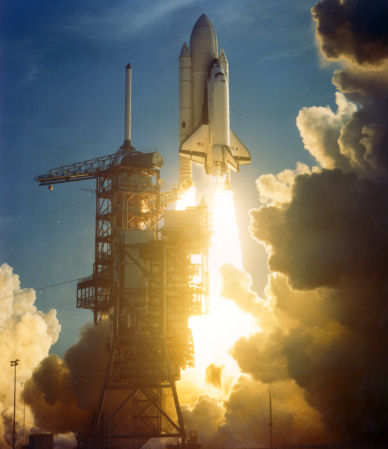
Date of First Launch: April 12, 1981
Date of Final Launch: January 16, 2003
Number of Launches: 28
Columbia was named after the Boston-based sloop of the late 1700’s, captained by Robert Gray. Other vessels named Columbia included the first U.S. Navy ship to circle the globe and the Command Module flown during Apollo 11, the first mission to land men on the Moon. Columbia was the first Space Shuttle ever launched when it began its maiden flight of STS-1 on April 12, 1981. Columbia was the first Orbiter to undergo the scheduled inspection and retrofit program. It was transported to Rockwell International’s Palmdale, California assembly plant on August 10, 1991 following the completion of mission STS-40. The Orbiter underwent about 50 modifications including the addition of carbon brakes, drag chute, improved nose wheel steering, removal of obsolete flight instrumentation and enhancements to its thermal protection system.
Columbia returned to the Kennedy Space Center on February 9, 1992 for processing for mission STS-50. On October 8, 1994 Columbia was again transported to Palmdale for about 90 additional enhancements, including upgrades to the main landing gear thermal barrier, tire pressure monitoring and radiator drive circuitry. On September 24, 1999 Columbia made its last trip to Palmdale for about an additional 100 modifications, including the addition of a glass cockpit display. Columbia’s missions included STS-1, STS-2, STS-3, STS-4, STS-5, STS-9, STS-61C, STS-28, STS-32, STS-35, STS-40, STS-50, STS-52, STS-55, STS-58, STS-62, STS-65, STS-73, STS-75, STS-78, STS-80, STS-83, STS-94, STS-87, STS-90, STS-93, STS-109 and STS-107. Columbia was destroyed during re-entry on February 1, 2003 at the conclusion of STS-107. Loss of the vehicle and crew were blamed on External Tank insulation which broke off during launch and struck Columbia’s underbelly, damaging its thermal protection and causing the Orbiter to burn up and disintegrate over East Texas.
SPACE SHUTTLE CHALLENGER (STA-099/OV-099)
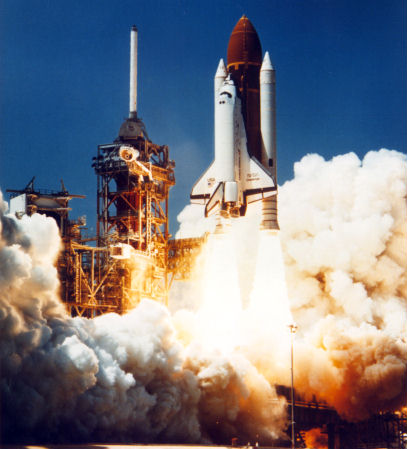
Space Shuttle Challenger, Photo Courtesy NASA
Date of First Launch: April 4, 1983
Date of Final Launch: January 28, 1986
Number of Launches: 10
Challenger was named after the British naval vessel HMS Challenger that sailed the Atlantic and Pacific Oceans in the 1870’s. Challenger was also the name of the Apollo 17 Lunar Module. Space Shuttle Challenger was destroyed 73 seconds after liftoff of mission STS-51L on January 28, 1986. A crew of seven perished. The cause of the accident was determined to be burn through of the right-hand Solid Rocket Booster which resulted in the explosion of the External Tank. Challenger began its career as a high-fidelity structural test article. As such, the Orbiter structure had evolved under such weight-saving pressure that virtually all components of the airframe were required to handle significant structural stress. The Orbiter was subjected to intensive vibration testing over an 11-month period beginning on February 4, 1978.
On January 29, 1979, NASA awarded Rockwell a contract to convert the structural test article into an operational Space Shuttle to alleviate concerns that Columbia would be the only operational Orbiter on hand when the ambitious flight series began. Challenger, along with Discovery, were modified to be able to carry a Centaur upper stage into space as a booster for a number of proposed satellite payloads. These modifications included the addition of increased plumbing to load and vent the Centaur’s liquid oxygen/liquid hydrogen fuel in the Shuttle’s payload bay as well as new controls on the aft flight deck to monitor the Centaur during flight operations. However, the Centaur upper stage was never actually flown as it was considered to be too risky in lieu of the Challenger tragedy. Challenger’s missions included STS-6, STS-7, STS-8, STS-41B, STS-41C, STS-41G, STS-51B, STS-51F, STS-61A and STS-51L, its final and tragic flight.
SPACE SHUTTLE DISCOVERY (OV-103)
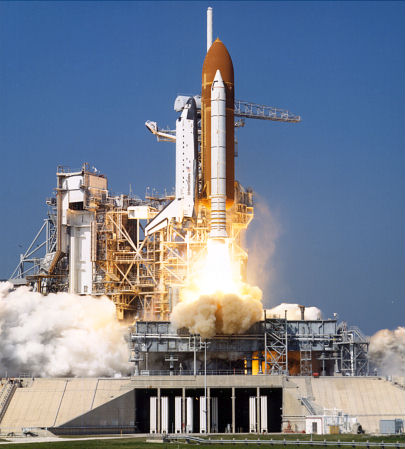
Space Shuttle Discovery, Photo Courtesy NASA
Date of First Launch: August 30, 1984
Date of Final Launch: February 24, 2011
Number of Launches: 39
Discovery was named after one of two ships used by British explorer James Cook in the 1770’s as he explored the South Pacific Ocean. Other ships also carried the name Discovery. These included a ship used by Henry Hudson as he sought a Northwest Passage between the Atlantic and Pacific Oceans in the early 1600’s. Another was a ship used by the British Royal Geographic Society on an expedition to the North Pole in 1875. The organization had a follow-up ship also named Discovery in support of an Antarctic expedition in 1904. Discovery, like Challenger, was modified to be able to carry the Centaur upper stage into space. Discovery also underwent a nine-month Orbiter Maintenance Down Period (OMDP) at the Rockwell plant in Palmdale, California following mission STS-82. This renovation included the addition of an extra cryogenic fuel tank and an external airlock to be employed during trips to the International Space Station. Discovery also underwent another OMDP following mission STS-105. This lasted over two years featuring 99 upgrades and 88 special tests. Discovery’s missions included STS-41D, STS-51A, STS-51C, STS-51D, STS-51G, STS-51I, STS-26, STS-29, STS-33, STS-31, STS-41, STS-39, STS-48, STS-42, STS-53, STS-56, STS-51, STS-60, STS-64, STS-63, STS-70, STS-82, STS-85, STS-91, STS-95, STS-96, STS-103, STS-92, STS-102, STS-105, STS-114, STS-121, STS-116, STS-120, STS-124, STS-119, STS-128, STS-131 and STS-133. Following its retirement in 2011, Space Shuttle Discovery was transported to the Smithsonian Institution in Washington, D.C. Discovery is currently housed in the James S. McDonnell Space Hangar at the National Air and Space Museum’s Steven F. Udvar-Hazy Center in Chantilly, Virginia.
SPACE SHUTTLE ATLANTIS (OV-104)
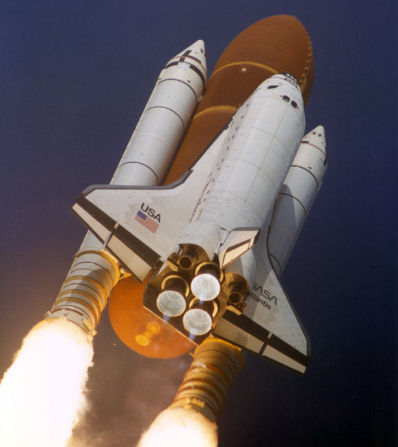
Space Shuttle Atlantis, Photo Courtesy NASA
Date of First Launch: October 3, 1985
Date of Final Launch: July 8, 2011
Number of Launches: 33
Atlantis was named after the primary research vessel of the Woods Hole Oceanographic Institute in Massachusetts from 1930 to 1966. Following mission STS-46, Atlantis was transported to the Rockwell plant in Palmdale, California for an Orbiter Maintenance Down Period (ODMP). A total of 165 modifications were made over a 20-month period and included the installation of a drag chute, new plumbing lines to configure the Orbiter for extended duration missions, more than 800 new heat tiles and blankets, new insulation for the main landing gear and structural modifications to the airframe. Atlantis also underwent a similar ODMP following mission STS-101. About 130 modifications were performed, including the addition of a “glass cockpit”, renovation of the navigation system transitioning it to more modern Global Positioning System (GPS) technology, addition of an airlock and docking mechanisms for missions to the International Space Station and modification to the Orbiter’s thermal insulation to afford a significant weight reduction. Atlantis missions include STS-51J, STS-61B, STS-27, STS-30, STS-34, STS-36, STS-38, STS-37, STS-43, STS-44, STS-45, STS-46, STS-66, STS-71, STS-74, STS-76, STS-79, STS-81, STS-84, STS-86, STS-101, STS-106, STS-98, STS-104, STS-110, STS-112, STS-115, STS-117, STS-122, STS-125, STS-129, STS-132 and STS-135. Following its retirement in 2011, Atlantis was moved to the Kennedy Space Center Visitors Complex. Space Shuttle Atlantis is currently on display in a multi-million dollar facility at the ever-popular complex.
SPACE SHUTTLE ENDEAVOUR (OV-105)
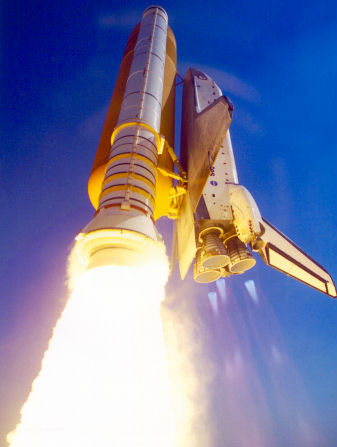
Space Shuttle Endeavour, Photo Courtesy NASA
Date of First Launch: May 7, 1992
Date of Final Launch: May 16, 2011
Number of Launches: 25
Endeavour was named after one of two ships captained by James Cook. Endeavour’s maiden voyage was in 1768 in an exploration of the South Pacific Ocean. For the first time, a Space Shuttle Orbiter’s name was selected via a national competition of elementary and secondary schools. The name Endeavour was announced by President George H.W. Bush in 1989. Endeavour incorporated new hardware designed to improve and expand Orbiter capabilities. Most of this new equipment was installed on the other Orbiters during their scheduled maintenance periods. Specific upgrades introduced on Endeavour included a 40-foot diameter drag chute that reduced landing rollout distance by as much as 2,000 feet, plumbing and electrical connections to allow missions up to 28 days in duration, updated avionics systems, updated navigation including star trackers, improved nosewheel steering as well as an improved version of the Orbiter’s Auxiliary Power Unit which provide power to operate hydraulic systems.
Archives Library Information Center (ALIC)

Space Exploration
Information about the United States’ space flight programs, including NASA missions and the astronauts who participate in the efforts to explore Earth’s galaxy.
- Finding Aids for Records on Space Exploration
- Presidential Libraries
- CRS Reports
- NASA’s Space Centers
- NASA’s Space Programs
- Hubble Space Telescope
- Space Exploration Biographies
- Women in Space History >
- October 4 - The Soviet Union launched the first satellite, Sputnik, into space.
- November 3 - The Soviet spacecraft Sputnik 2 was launched with a dog named Laika on board. Laika did not survive the voyage.
- January 31 - Explorer 1 was the first satellite launched by the United States when it was sent into orbit on January 31, 1958. It was designed and built by the Jet Propulsion Laboratory (JPL) of the California Institute of Technology. The satellite was sent aloft from Cape Canaveral in Florida by the Jupiter C rocket that was designed, built, and launched by the Army Ballistic Missile Agency (ABMA) under the direction of Dr. Wernher Von Braun.
- August 19 - The Soviet craft Sputnik 5 was launched, carrying the dogs Strelka and Belka. They became the first living beings to survive a trip into space.
- April 12 - Russian cosmonaut Yuri Gagarin became the first human in space.
- May 5 - Astronaut Alan Shepard became the first American in space.
- May 25 - President Kennedy challenged the country to put a man on the moon by the end of the decade.
- February 20 - Astronaut John Glenn became the first American in orbit.
- June 16 - Valentina Nikolayeva Tereshkova became the first woman in space.
- March 18 - While tethered to his spacecraft, cosmonaut Alexi Leonov became the first man to walk in space.
- June 3 - Astronaut Ed White became the first American to walk in space.
- July 14 - The spacecraft Mariner 4 transmitted the first pictures of Mars.
- February 3 - The Russian spacecraft Luna 9 became the first spacecraft to land on the moon.
- June 2 - Surveyor 1 became the first American spacecraft to land on the moon.
- January 27 - Astronauts Gus Grissom, Ed White, and Roger Chaffee were killed in an accidental fire in a command module on the launch pad.
- April 24 - Cosmonaut Vladimir M. Komarov was killed in a crash when the parachute on his Soyuz 1 spacecraft failed to deploy.
- October 18 - A descent capsule from the Soviet probe Venera 4 collected data about the atmosphere of Venus.
- September 15 - The Soviet spacecraft Zond 5 was launched and later became the first spacecraft to orbit the moon and return to Earth.
- December 21 - Apollo 8 was launched, and later her crewmembers became the first men to orbit the moon.
- July 20 - Neil Armstrong and "Buzz" Aldrin became the first men on the moon.
- April 11 - Apollo 13 was launched.
- September 12 - The Soviet craft Luna 16 was launched and became the first automatic spacecraft to return soil samples of the moon.
- November 17 - The Soviet automatic robot Lunokhod 1 landed on the moon with Luna 17.
- December 15 - The Soviet Venera 7 became the first probe to land on Venus.
- April 19 - The Soviet space station Salyut 1 was launched.
- July 30 - The moon rover was driven on the moon for the first time.
- November 13 - The Mariner 9 probe became the first craft to orbit another world - Mars.
- December 11 - Eugene Cernan and Harrison "Jack" Schmitt became the last men to walk on the moon.
- May 14 - The U.S. launched its first space station, Skylab.
- July 17 - The American Apollo 18 and Soviet Soyuz 19 dock in the Apollo-Soyuz Test Project.
- September - The American probe Viking 2 discovered water frost on the Martian surface.
- August and September - Voyagers 1 and 2 were launched. (Voyager 2 was launched before Voyager 1, but Voyager 1 was on a faster trajectory.)
- March and August - Voyagers 1 and 2 began transmitting images of Jupiter and her moons.
- September - The U.S. probe Pioneer 11 reached Saturn and began transmitting images.
- November 13 - Voyager 1 reached Saturn and began transmitting images.
- April 12 - Columbia became the first Space Shuttle to be launched.
- August 26 - Voyager 2 reached Saturn and began transmitting images.
- April 4 - The second Space Shuttle, Challenger, was launched.
- June 19 - Sally Ride became the first American woman in space on Challenger’s second mission.
- August 30 - Guion Bluford became the first African-American in space.
- February 3 - Astronaut Bruce McCandless became the first man to take an untethered space walk.
- August 30 - The third Space Shuttle, Discovery, was launched.
- October - Kathryn Sullivan became the first American woman to walk in space.
- October 3 - Atlantis, the fourth Space Shuttle, was launched.
- January 24 - Voyager 2 began transmitting images from Uranus.
- January 28 - The Space Shuttle Challenger exploded seconds after liftoff.
- February 20 - The core section of the Space Station Mir was launched.
- August - Voyager 2 began transmitting images from Neptune.
- August 10 - The Magellan spacecraft began mapping the surface of Venus using radar equipment.
- August 24 - The Space Shuttle Discovery deployed the Hubble Space Telescope.
- May 7 - The Space Shuttle Endeavor was launched on her maiden voyage.
- September 12 - Mae Jemison became the first African-American woman in space.
- December - The Space Shuttle Endeavor made the first servicing mission of the Hubble Space Telescope.
- February 3 - Sergei Krikalev became the first Russian cosmonaut to fly on a Space Shuttle.
- February 2 - Eileen Collins became the first female Shuttle pilot.
- December - The Galileo probe began transmitting data on Jupiter.
- July 4 - The Mars Pathfinder arrived on Mars and later began transmitting images.
- October 29 - John Glenn became the oldest man in space.
- July 23 - Eileen Collins became the first female Shuttle Commander.
- February 14 - The U.S. Near Earth Asteroid Rendezvous (NEAR) spacecraft began transmitting images of the asteroid Eros.
- February 12 - NEAR landed on the surface of Eros.
- April 28 - American Dennis Tito became the first tourist in space after paying the Russian space program $20,000,000.
- February 1 - The Space Shuttle Columbia broke up on re-entry into the Earth’s atmosphere.
- February 13 - An investigative panel found that superheated air almost certainly seeped through a breach in space shuttle Columbia’s left wing and possibly its wheel compartment during the craft’s fiery descent, resulting in the deaths of all seven astronauts.
- August 25 - NASA launched the largest-diameter infrared telescope ever in space, the Spitzer Space Telescope.
- September 21 - NASA’s Galileo mission ended a 14-year exploration of the solar system’s largest planet and its moons with the spacecraft crashing by design into Jupiter at 108,000 mph.
- January 14 - President Bush proposed a new space program that would send humans back to the moon by 2015 and establish a base to Mars and beyond.
- July 1 - The Cassini spacecraft sent back photographs of Saturn’s shimmering rings.
- July 3 - A NASA spacecraft collided with a comet half the size of Manhattan, creating a brilliant cosmic smashup designed to help scientists study the building blocks of life on earth.
- July 26 - Space Shuttle Discovery was launched with seven astronauts aboard; this was America’s first manned space shot since the 2003 Columbia disaster.
- January 15 - NASA spacecraft Stardust returned safely to Earth in a desert near Salt Lake City with the first dust ever collected from a comet.
- August 4 - NASA launched its Phoenix Mars Lander.
- August 8 - Space Shuttle Endeavour and a crew of seven blasted off with teacher-astronaut Barbara Morgan aboard as a crewmember. Morgan was the first teacher in space since the Challenger disaster in 1986.
- January 14 - The NASA space probe Messenger skimmed 124 miles above Mercury.
- May 25 - NASA’s Phoenix Mars Lander landed safely and began sending images home after a 10-month, 422 million-mile journey. Scientists later reported that Phoenix discovered chunks of ice.
- March 6 - The NASA spacecraft Kepler was launched. Its mission is to search for planets outside our solar system, in a distant area of the Milky Way.
- June 18 - NASA launched the Lunar Crater Observation and Sensing Satellite, also known as LCROSS. The mission is to confirm the presence or absence of ice on the moon. On November 13, 2009, NASA scientists announced the discovery of a "significant amount" of ice in a crater near the moon’s South Pole.
- October 10 - Virgin Galactic, a private company, announced the successful first manned glide flight of the VSS Enterprise. This vehicle is a suborbital plane designed to take private citizens on suborbital space flights.
- October 11 - President Barack Obama signed legislation focusing NASA’s efforts on exploring Mars and the asteroids.
- December 8 - A private company named SpaceX launched a spacecraft into orbit and returned it to earth safely. It was the first non-government organization to accomplish this.
- July 8 - The space shuttle Atlantis became the last American space shuttle to be launched into space. Mission STS-135 and its 4-member crew brought much-needed supplies and equipment to the International Space Station (ISS).
- July 16 - NASA's Dawn spacecraft became the first man made craft to orbit an asteroid.
- November 26 - NASA launched Curiosity, the biggest, best equipped robot ever sent to explore another planet. It will reach Mars in 2012.
- May 22 - SpaceX, a commercial space company, launched its Dragon C2+ mission to resupply the International Space Station (ISS).
- August - NASA’s Voyager 1 probe, launched in 1977, entered interstellar space.
- August 6 - NASA's Curiosity rover successfully landed on Mars. As large as a car, it carried an array of advanced new instruments and experiments.
- September 7 - NASA launched the unmanned LADEE spacecraft from NASA's Wallops Flight Facility in Virginia. It was the U.S. space agency's third lunar probe in five years.
- December 24 - NASA astronauts wrapped up successful repairs at the International Space Station after a rare Christmas Eve spacewalk to fix an equipment cooling system.
This timeline is mainly compiled from the NASA Space Exploration Timeline: 1957 A.D.-Present , Sea and Sky’s Space Exploration Timeline and Timeline of NASA, the Space Shuttle and Near Earth Space Flights .

- The President
- Executive Orders
- Photo Gallery
- Presidential Daily Diary
- Exhibitions
- Museum FAQs
- Past Exhibitions
- Guide to Holdings
- Research FAQs
- Civics for All of US
- Scouting - Earn Badges
- Public Programs
- News & Events
- Terms and Conditions for Using Our Website
- Visit the Museum
- Visit the Research Room

Museum Hours Monday - Sunday 10:00am-5:00pm Research Hours Monday - Friday 9:30am-5:00pm
The Evolution of Space Travel: Then and Now
The Education and Public Programs Team at the Nixon Library is pleased to remind you that the National Archives and Records Administration (NARA) continues to be an excellent source for entertaining and historical content! Simply follow the links below for additional information.
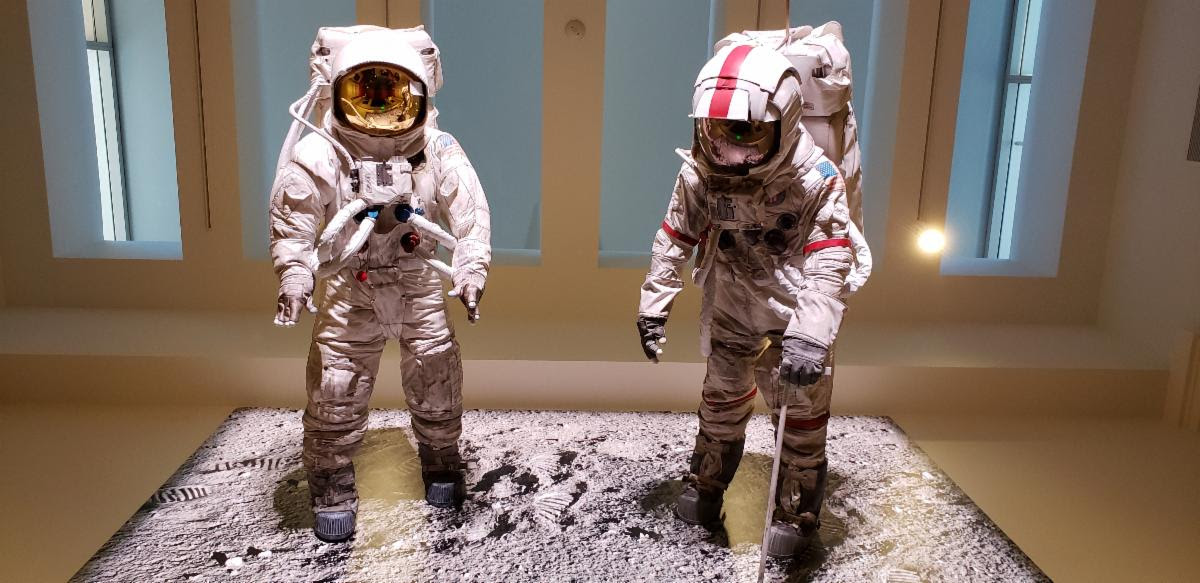
Replicas of the Apollo 11 Space Suit and the Apollo 16 EMU Space Suit. Richard Nixon Presidential Library and Museum, National Archives and Records Administration, Prop 1148, P.2015.6
President Dwight Eisenhower created the National Aeronautics and Space Administration (NASA) on July 29, 1958. Its mission was to coordinate the United States’ advancement in space and its context was direct competition between the two greatest antagonists of the Cold War: the United States and the Soviet Union. The space race would be "another dramatic arena for this competition, as each side sought to prove the superiority of its technology, its military firepower and–by extension–its political-economic system.” Richard Nixon, elected into office in November 1968, inherited the Cold War and the tensions associated with it, both on earth and in space. A decade of “effort, expertise and coordination” helped propel the United States of America to victory in the “Space Race.” Ten years of planning and persistence culminated in all six lunar landings occurring during Richard Nixon’s presidency.
American lunar landings ended in 1972, but the advancement of space travel and exploration continues with NASA’s Artemis Program aiming to land on the moon once again in 2024. Privatized space exploration, pioneered by Richard Branson of Virgin Galactic and Jeff Bezos’s Blue Origin, is now dominating a domain once solely reserved for government agencies. The space race has evolved from competition between two powerful nations with warring ideologies to private companies and billionaire entrepreneurs vying for customers in the realm of space tourism in the final frontier.
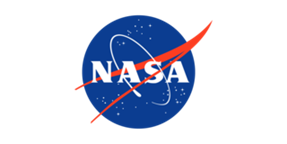
Symbols of NASA-Designed in 1959, the "meatball" as it is affectionately called, was the agency's logo for 16 years until it was replaced in 1975 by the more modern looking "worm" design. The "meatball" was resurrected in 1992 and is the most recognized symbol of the organization. “Symbols of NASA,” NASA, last modified September 30, 2019, https://www.nasa.gov/audience/forstudents/5-8/features/symbols-of-nasa.html
NASA, and its creation of the Apollo Program in 1961, thrived due to support and generous government funding from President John F. Kennedy. In a joint message to Congress on May 25, 1961, Kennedy stated, “I believe the nation should commit itself to achieving the goal, before this decade is out, of landing a man on the moon and returning him safely to Earth." Lyndon Johnson's administration continued to support increased agency funding, reaching an all-time high of 4.4% of the national budget in 1966. During the Nixon administration, eight years after the program began, on July 20, 1969, the Apollo 11 space mission touched down on the surface of the Moon. American astronaut Neil Armstrong uttered his famous phrase, "That's one small step for [a] man, one giant leap for mankind." Armstrong and fellow astronaut Edwin “Buzz” Aldrin planted the American flag into the surface of the Moon, and the United States reigned victorious.
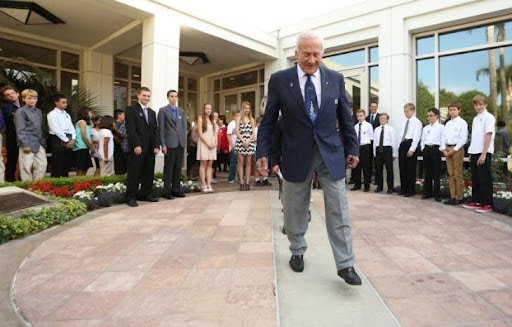
Astronaut Buzz Aldrin re-creates his moonwalk at the Richard Nixon Presidential Library and Museum in Yorba Linda on June 12, 2013. Photographs Courtesy of the Richard Nixon Foundation.
NASA achieved what many thought impossible, landing humans on the Moon and bringing them safely back to Earth , ultimately winning the Space Race during the Cold War. History was also made when the two astronauts received an interplanetary congratulatory phone call from President Nixon, the longest distance phone call ever made, on July 20, 1969 at 11:45 PM Eastern Daylight Time.
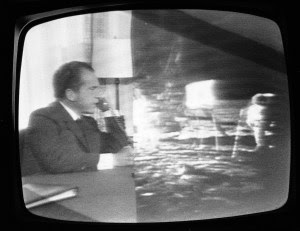
Split-screen of President Richard Nixon and the Apollo 11 astronauts on a White House television, July 20, 1969. (NAID 66394157 ).
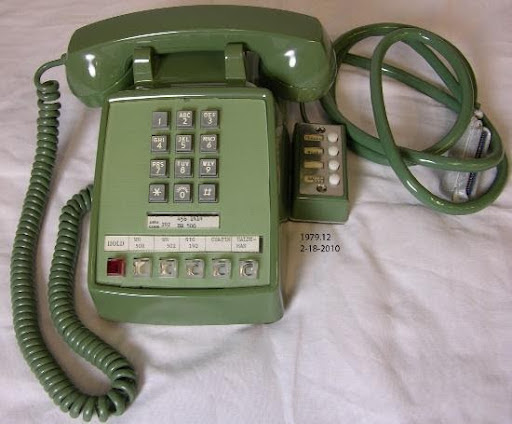
While in the White House Oval Office on July 20, 1969, President Nixon used this green telephone to talk to the Apollo 11 astronauts while they walked on the moon. Richard Nixon Presidential Library and Museum, National Archives and Records Administration, 1979.12
Four days later, the President welcomed home the Apollo 11 crew in person aboard the USS Hornet in the Pacific Ocean. The final lunar landing, Apollo 17, occurred in December of 1972.
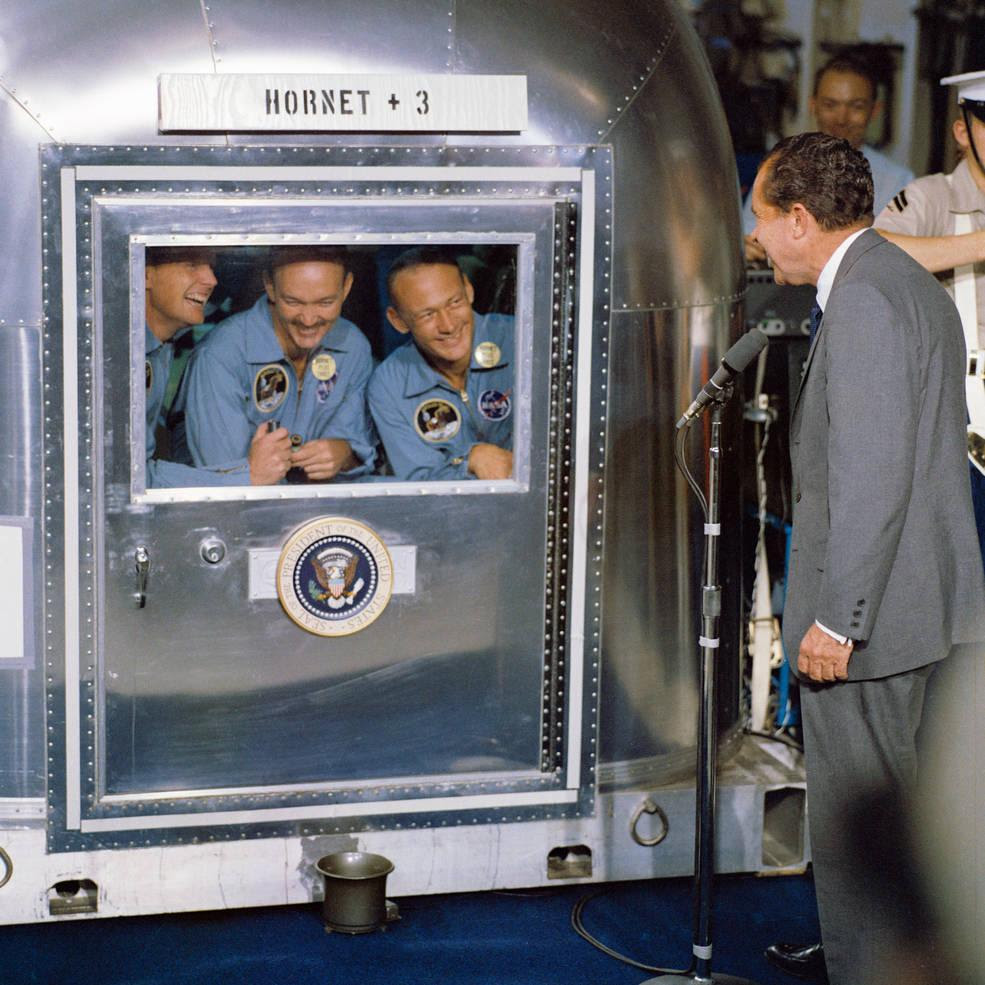
"President Nixon - Welcome - Apollo XI Astronauts - USS Hornet." Photograph. NASA. From JSC, July 24, 1969. https://images.nasa.gov/details-S69-21365 (accessed July 14, 2021).
Man's exploration of the Moon was challenging, expensive, wondrous, tragic, and breathtaking. NASA’s almost five billion dollar budget in 1969 prompted the President to reevaluate the space program's importance in comparison to the many national issues needing attention and funding. On March 7, 1970, President Nixon changed the trajectory of the space program stating, “We must think of [space activities] as part of a continuing process and not as a series of separate leaps, each requiring a massive concentration of energy. Space expenditures must take their proper place within a rigorous system of national priorities.” By January 1972, Nixon had outlined a vision to revolutionize space travel that would take away the astronomical costs and make space more accessible for all Americans. These decisions reined in budget expenditure, “ promoted increased international participation in U.S. human spaceflight programs , and prompted the expansion of privatized space exploration happening today.
On May 22, 1972, Nixon became the first United States President to visit Moscow. Subsequent meetings brought diplomacy in space through the Agreement Concerning Cooperation in the Exploration and Use of Outer Space for Peaceful Purposes . This agreement laid the foundation for the 1975 linking of an Apollo spacecraft with a Soviet Soyuz command module during the Ford administration. Its mission, a nine-day space flight, tested the “ compatibility of rendezvous and docking systems and the possibility of an international space rescue. ” President Nixon’s space diplomacy set the groundwork for the current International Space Station in orbit by promoting technological growth and easing the financial burden of space exploration through pooled resources.
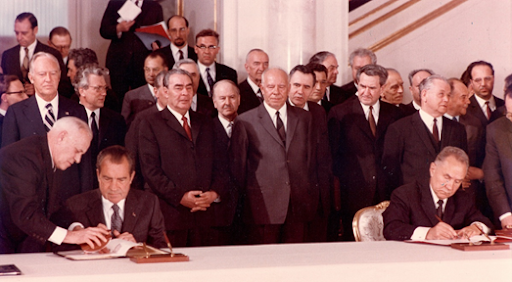
President Nixon and Alexei Kosygin signing the Space Agreement titled "The Agreement Concerning Cooperation in the Exploration and Use of Outer Space for Peaceful Purposes." 5/24/1972, Moscow, Russia, USSR, Grand Kremlin Palace, St. Vladimir Hall. (WHPO-9179-06)
Space race 2.0.

A Virgin Galactic spacecraft flew into space, a first for the space tourism company, during a flight on Thursday high above the Mojave Desert in California. Hartman, Matt, Photographer. “Virgin Galactic Rocket Ship Reaches Space, a Milestone in Space Tourism,” Photograph, Associated Press. From New York Times , December 13, 2018. https://www.nytimes.com/2018/12/13/science/virgin-galactic-spaceship.html (accessed July 14, 2021).
On September 21, 2020, NASA published an update to its newest mission, the Artemis Plan , stating, “In its formal plan, NASA captures Artemis progress to date, identifying the key science, technology, and human missions, as well as the commercial and international partnerships that will ensure we continue to lead in exploration and achieve our ambitious goal to land astronauts on the Moon.”
The astronauts chosen will include the first woman and the first person of color to walk on the moon in the year 2024. To become an astronaut with NASA, potential candidates must be U.S. citizens, earn a master's degree in biological science, physical science, computer science, engineering, or math, have 1,000 hours as a pilot in command of an aircraft, and pass the flight astronaut physical exam. The budding industry of space tourism spearheaded by billionaires Richard Branson and Jeff Bezos will help bypass NASA’s stringent regulations. The current price tag: $250,000 . After his landmark flight this month, Richard Branson, owner of Virgin Galactic stated, “We’re here to make space more accessible to all.” The Space Race - albeit reimagined in the 21st Century to include commercial partnerships and space tourism - continues thanks to the legacies of Presidents Eisenhower, Kennedy, Johnson, Nixon and Ford.
Thank you for visiting nature.com. You are using a browser version with limited support for CSS. To obtain the best experience, we recommend you use a more up to date browser (or turn off compatibility mode in Internet Explorer). In the meantime, to ensure continued support, we are displaying the site without styles and JavaScript.
- View all journals
- Explore content
- About the journal
- Publish with us
- Sign up for alerts
- BOOK REVIEW
- 13 February 2023
How NASA’s breakthrough ‘class of ’78’ changed the face of space travel
- Alexandra Witze
You can also search for this author in PubMed Google Scholar
The New Guys: The Historic Class of Astronauts That Broke Barriers and Changed the Face of Space Travel Meredith Bagby William Morrow (2023)
Access options
Access Nature and 54 other Nature Portfolio journals
Get Nature+, our best-value online-access subscription
$29.99 / 30 days
cancel any time
Subscribe to this journal
Receive 51 print issues and online access
$199.00 per year
only $3.90 per issue
Rent or buy this article
Prices vary by article type
Prices may be subject to local taxes which are calculated during checkout
Nature 614 , 407-408 (2023)
doi: https://doi.org/10.1038/d41586-023-00401-w
Competing Interests
The author declares no competing interests.
Related Articles

- Astronomy and astrophysics
- Planetary science
- Space physics

This super-Earth is the first planet confirmed to have a permanent dark side
News 28 MAR 24

Thermonuclear explosions on neutron stars reveal the speed of their jets
Article 27 MAR 24

The complex circumstellar environment of supernova 2023ixf

How Sydney Harbour Bridge was shaping up 100 years ago
News & Views 26 MAR 24

Are we in the Anthropocene yet?
Editorial 20 MAR 24

It’s final: the Anthropocene is not an epoch, despite protest over vote
News 20 MAR 24
Don’t underestimate the rising threat of groundwater to coastal cities
Correspondence 26 MAR 24

Planet-eating stars hint at hidden chaos in the Milky Way
Tenure-track Assistant Professor in Ecological and Evolutionary Modeling
Tenure-track Assistant Professor in Ecosystem Ecology linked to IceLab’s Center for modeling adaptive mechanisms in living systems under stress
Umeå, Sweden
Umeå University
Faculty Positions in Westlake University
Founded in 2018, Westlake University is a new type of non-profit research-oriented university in Hangzhou, China, supported by public a...
Hangzhou, Zhejiang, China
Westlake University
Postdoctoral Fellowships-Metabolic control of cell growth and senescence
Postdoctoral positions in the team Cell growth control by nutrients at Inst. Necker, Université Paris Cité, Inserm, Paris, France.
Paris, Ile-de-France (FR)
Inserm DR IDF Paris Centre Nord
Zhejiang Provincial Hospital of Chinese Medicine on Open Recruitment of Medical Talents and Postdocs
Director of Clinical Department, Professor, Researcher, Post-doctor
The First Affiliated Hospital of Zhejiang Chinese Medical University
Sir Run Run Shaw Hospital, School of Medicine, Zhejiang University, Warmly Welcomes Talents Abroad
“Qiushi” Distinguished Scholar, Zhejiang University, including Professor and Physician
No. 3, Qingchun East Road, Hangzhou, Zhejiang (CN)
Sir Run Run Shaw Hospital Affiliated with Zhejiang University School of Medicine
Sign up for the Nature Briefing newsletter — what matters in science, free to your inbox daily.
Quick links
- Explore articles by subject
- Guide to authors
- Editorial policies
- Cast & crew
- User reviews
The Space Movie

A musical journey through our solar system to the far reaches of the universe. A musical journey through our solar system to the far reaches of the universe. A musical journey through our solar system to the far reaches of the universe.
- Tony Palmer
- Buzz Aldrin
- Neil Armstrong
- Mike Collins
- 8 User reviews

- (archive footage)

- (uncredited)

- See all cast & crew
- Production, box office & more at IMDbPro
Technical specs
- Runtime 1 hour 18 minutes
Related news
Contribute to this page.

- See more gaps
- Learn more about contributing
More to explore

Recently viewed
'Alien: Covenant' Stars Not Too Keen on Space Travel
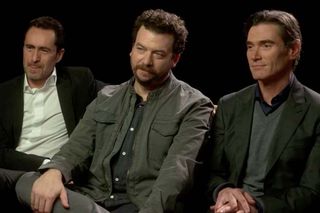
LONDON — As crewmembers of the Covenant spaceship, they spent years traveling toward the distant planet Origae-6, with the goal of establishing a colony to secure the survival of humanity.
But that's science fiction. In real life, the actors who star in "Alien: Covenant" — Ridley Scott's new installment in the "Alien" film saga, which opens in theaters across the United States Friday (May 19) — don't seem all that excited about venturing into the final frontier. And you can't really blame them. As with every "Alien" mission, the Covenant's trip didn't turn out exactly as the crew and the passengers had hoped, ending in a horrific fight for life.
"If somebody said, 'Do you want to go to space?' and the opportunity arose, I would take it," said Michael Fassbender, who reprised his role as the android David from 2012's "Alien" film "Prometheus" and added a second one as an upgraded version of the robot called Walter. [ 9 Terrifying Extraterrestrials from the 'Alien' Movies ]
"But it's not on my bucket list or anything," Fassbender told Space.com here earlier this month.
The film's main star, Katherine Waterston, portrays a bereaved terraforming expert named Daniels who turns into a kickass monster-fighting warrior in the film. In real life, however, she finds the time commitment of space travel, especially the intergalactic type, quite off-putting.
"I don't think they would be able to offer that kind of spaceship that I would want to travel on in my lifetime: one that flies as quickly as from New York to London," she said.
Even the film's director, the legendary Sir Ridley Scott (who also directed the original 1979 "Alien" and the 2015 smash hit " The Martian "), admitted he is not of a particularly adventurous spirit.
Get the Space.com Newsletter
Breaking space news, the latest updates on rocket launches, skywatching events and more!
"Are you kidding me? I like it here," said Scott, who also directed "Prometheus," which takes place 10 years before the events of " Covenant ."
Billy Crudup (who plays Covenant's second in command, Christopher Oram) and Danny McBride (who plays the ship's pilot, Tennessee) agreed with the rest of the cast.
"We are not going anywhere," Crudup said.
"I get motion sickness," McBride said. "I feel like it would be rough just getting out of the atmosphere. I will let everyone else leave, and then I'll just wander around and take stuff from their houses."
Follow us @Spacedotcom , Facebook or Google+ . Originally published on Space.com .
Join our Space Forums to keep talking space on the latest missions, night sky and more! And if you have a news tip, correction or comment, let us know at: [email protected].

Tereza is a London-based science and technology journalist, aspiring fiction writer and amateur gymnast. Originally from Prague, the Czech Republic, she spent the first seven years of her career working as a reporter, script-writer and presenter for various TV programmes of the Czech Public Service Television. She later took a career break to pursue further education and added a Master's in Science from the International Space University, France, to her Bachelor's in Journalism and Master's in Cultural Anthropology from Prague's Charles University. She worked as a reporter at the Engineering and Technology magazine, freelanced for a range of publications including Live Science, Space.com, Professional Engineering, Via Satellite and Space News and served as a maternity cover science editor at the European Space Agency.
International Space Station: Live updates
Meet the 4 astronauts of SpaceX's Ax-3 launch for Axiom Space
Dune: What the climate of Arrakis can tell us about the hunt for habitable exoplanets
Most Popular
By Harry Baker March 29, 2024
By Sharmila Kuthunur March 29, 2024
By Samantha Mathewson March 29, 2024
By Keith Cooper March 29, 2024
By Joe Rao March 29, 2024
By Elizabeth Howell March 29, 2024
By Sharmila Kuthunur March 28, 2024
By Mike Wall March 28, 2024
By Robert Lea March 28, 2024
- 2 April 8 total solar eclipse: Why this eclipse repeats itself every 54 years
- 3 Spaceflight tripleheader! SpaceX planning 3 launches in 5-hour span today
- 4 Why are some supermassive black hole jets so short? Astronomers may have cracked the case
- 5 1st Boeing Starliner astronauts are ready to launch to the ISS for NASA (exclusive)
Netflix's 3 Body Problem Reveals a Surprisingly Brilliant Mode of Space Travel
The idea of space travel with parachutes and nuclear explosions will sound plenty familiar to NASA alum.

In 1946, only a year after the explosive and devastating debut of the nuclear age, Polish-American mathematician and physicist Stanislaw Ulam had an idea for a rocket that was so crazy it just might work.
During the war, Ulam worked side-by-side with Robert Oppenheimer and Edward Teller on the creation of the atomic bomb at Los Alamos, and now that peace was achieved, the future of the nuclear age was only just beginning. It was during this moment of possibility while still conducting research at the famous New Mexico facility, that Ulam’s thoughts turned toward the stars: Could the explosive power of the atomic bomb be used for exploration instead of destruction?
In other words, could nuclear bombs somehow become deep-space rocket engines?
“It is a very ambitious but efficient way to undertake space explorations with a vehicle able to travel at high speeds with high payloads and an extremely good ratio of payload to total initial weight,” Ulam wrote in his 1976 memoir Adventures of a Mathematician . “The spaceship could transport hundreds or thousands of people.”

Earthlings want to send a probe light years away to spy on the San-Ti, but need an idea to get there, fast.
Fast-forward to 2024 and Ulam’s nuclear daydreaming is enjoying a renaissance of sorts as the Netflix series The Three-Body Problem , based on a novel by Chinese sci-fi author Liu Cixin, cribs the idea as a fast-and-not-so-easy way to propel a payload to incredible speeds. To achieve this, the characters devise a “radiation sail” to be propelled by a thousand consecutive nuclear explosions in space until the spacecraft reaches a velocity just a notch above 1 percent of lightspeed.
But while the Three-Body Problem uses Ulam’s nuclear rocket for decidedly sci-fi ends, the 80-year-long story of this developing technology, known today as nuclear pulse propulsion (NPP), is very real — and it may still be the future of space exploration.
An Explosive History
Every rocket humanity has ever sent skyward has been powered by chemical fuel, a combination of kerosene, oxygen, and hydrogen, or both, with enough “oomph” to escape Earth’s orbit and reach its otherworldly destination. That’s how the Apollo astronauts landed on the moon, how the Space Shuttle crews built the International Space Station, and how future space explorers will put bootprints on Mars.
But similar to how fission (and especially fusion) represent efficient energy sources of the future, the same can also be said for rocketry. And while the idea of riding the concussive explosions of a nuclear bomb may seem strange, the idea isn’t quite as strange as you might think.
“Your car is a pulsed system because the piston is compressing gas and air together, and then it explodes and pushes the piston apart,” Jason Cassibry, a professor at the Department of Mechanical and Aerospace Engineering at the University of Alabama in Huntsville, tells Inverse . Cassibry is affiliated with the university’s Propulsion Research Center where he recently worked on a pulsed propulsion system similar to magneto-inertial fusion technology. “So every time you explode [a bomb] according to Newton's second law, it would give it an increase in momentum and accelerate it, just like you would driving your car and stepping on the gas.”
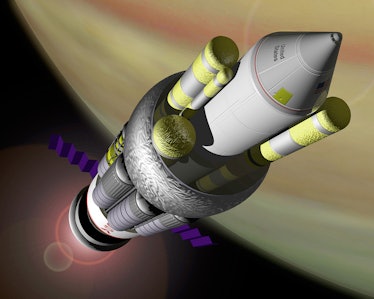
NASA’s Project Orion involves a heavy-lift vehicle that used atomic bombs to detonate behind a pusher plate fitted with shock absorbers.
Ulam recognized the beautiful simplicity of a pulsed system, and after mulling over the idea for years, he finally put his thoughts to paper in a classified 1955 report, stating that “the scheme proposed in the present report involves the use of a series of expendable reactors (fission bombs) ejected and detonated at a considerable distance from the vehicle.” Ulam eventually presented the idea to President Eisenhower’s scientific advisor George Kistiakowsky whose “reception of it was not enthusiastic,” Ulam wrote in his memoir.
Despite initial skepticism, the idea eventually gathered steam under the infamous Project Orion , a heavy-lift vehicle concept that used atomic bombs, ranging from a few to several kilotons, to detonate behind a pusher plate fitted with shock absorbers to limit the impact of that initial, explosive acceleration. While many of the early design challenges of the spacecraft were overcome, the project shut down in 1965 due to nuclear treaties that prohibited nuclear explosions in space. Chemical rockets had also become more powerful and were clearly NASA’s preferred chariot to the stars during the Space Race.
But the idea didn't die and several projects carried the NPP flame with names like Project Daedelus , Project Longshot , and Vista . One of the most intriguing ideas was a spacecraft concept known as Medusa that altered the pulsed propulsion design using a lightweight sail (technically a spinnaker) to harness the pressure pulses of subsequent nuclear explosions, a concept that’s extremely similar to the one explored in the Three-Body Problem . Sadly, none of these concepts — including Cassibry’s own Pulsed Fission-Fusion (PuFF) system — ever made it to the launch pad, largely due to technological limitations and lingering concerns over detonating nuclear explosions in space.
“There was a resurrection of Project Orion in the 90s when Clinton was in office, and when they got to the level to talk to some of his staffers…they said ‘no way are we putting nuclear weapons in space,’” Cassibry says. “Now, they’re even more sensitive to it — even though the Cold War is over, there are still concerns.”
Space Travel Goes Nuclear
However, not all nuclear propulsion systems are the same.
While Cassibry worked on pulsed systems, ostensibly the great-grandchild of Ulam’s original vision, other systems include nuclear thermal propulsion (NTP) and nuclear electric propulsion (NEP). While all three are based on nuclear technology, NTP and NEP use more traditional fission systems (i.e. heating up propellant, which turns to gas, and results in propulsion). So unlike NPP, which uses microexplosions for propulsion (much to the chagrin of international nuclear treaties), NTP and NEP systems can’t be weaponized.
While all three technologies use different methods and have various use cases, nuclear propulsion — whether through fission heating or nuclear explosion — has some pretty stark advantages over its chemical competitor.
“There are certain missions to the ice giants — Uranus and Neptune — that could not be done, given all the constraints that you put on a mission that far out, with anything other than nuclear thermal,” Cassibry says. “[NTP] is more straightforward than some of the things we could do…it’s kind of low-hanging fruit in terms of advanced propulsion concepts.”
NASA has taken notice and hopes to test its Demonstration Rocket for Agile Cislunar Operations (DRACO) NTP rocket in 2026. Being three times more efficient than chemical rockets, that means Draco could travel from the Earth to Mars in just 45 days or carry increased cargo loads in a more conventional timeframe. However, Cassibry still believes that nuclear pulse propulsion, using fission, fusion, or a combination of the two, will ultimately outperform even these nuclear-powered spacecraft decades down the road.
“There’s a joke that crushes my soul every time I hear it that fusion is the technology of the future and it always will be,” Cassibry says. “But we started with really, really, really terrible reactors and we’ve been making steady progress…we’ll see fusion propulsion being possible within about 20 to 30 years.”
Whether on a popular Netflix show or in the minds of the leading minds on space travel, it would seem Ulam’s dream is alive and well.
Follow Polygon online:
- Follow Polygon on Facebook
- Follow Polygon on Youtube
- Follow Polygon on Instagram
Site search
- What to Watch
- What to Play
- PlayStation
- All Entertainment
- Dragon’s Dogma 2
- FF7 Rebirth
- Zelda: Tears of the Kingdom
- Baldur’s Gate 3
- Buyer’s Guides
- Galaxy Brains
- All Podcasts
Filed under:
Pick up a 4K digital copy of 2001: A Space Odyssey for free
Just shy of the film’s 55th anniversary
If you buy something from a Polygon link, Vox Media may earn a commission. See our ethics statement .
Share this story
- Share this on Facebook
- Share this on Reddit
- Share All sharing options
Share All sharing options for: Pick up a 4K digital copy of 2001: A Space Odyssey for free
/cdn.vox-cdn.com/uploads/chorus_image/image/73236454/607392542.0.jpg)
Stanley Kubrick’s 2001: A Space Odyssey remains one of the greatest space movies, even as we approach the 55th birthday of its theatrical debut. It’s awe-inspiring, full of clever practical effects. It’s also terrifying, both for its disturbing vision of the great unknown and for showcasing the perils of naughty AI that knows too much, decades before it was something anyone truly had to think about. Maybe you’ve seen this film countless times already, or you’re intrigued after seeing the cheeky, yet heavy-handed references to the film in the opening sequence of Greta Gerwig’s Barbie.
I’m just here to tell you that you can get a free 4K digital copy of the movie over at Amazon Prime Video, per a recent deal alert from Wario64’s X (formerly known as Twitter) account. Once you’re signed in, you can select “Buy movie” in UHD quality to get it for free. It typically costs $14.99, so grab it while it’s still discounted.
/cdn.vox-cdn.com/uploads/chorus_asset/file/15139398/Screen_Shot_2015-01-15_at_2.32.35_PM.0.0.1489995302.png)
2001: A Space Odyssey
Prices taken at time of publishing.
- $0 at Amazon (4K)
The next level of puzzles.
Take a break from your day by playing a puzzle or two! We’ve got SpellTower, Typeshift, crosswords, and more.
Sign up for the newsletter Patch Notes
A weekly roundup of the best things from Polygon
Just one more thing!
Please check your email to find a confirmation email, and follow the steps to confirm your humanity.
Oops. Something went wrong. Please enter a valid email and try again.

Don’t have the time to read (or watch) Shōgun? Get the audiobooks for just $10

Cloud’s unreliable narration only makes Final Fantasy 7 Rebirth’s ending more confusing
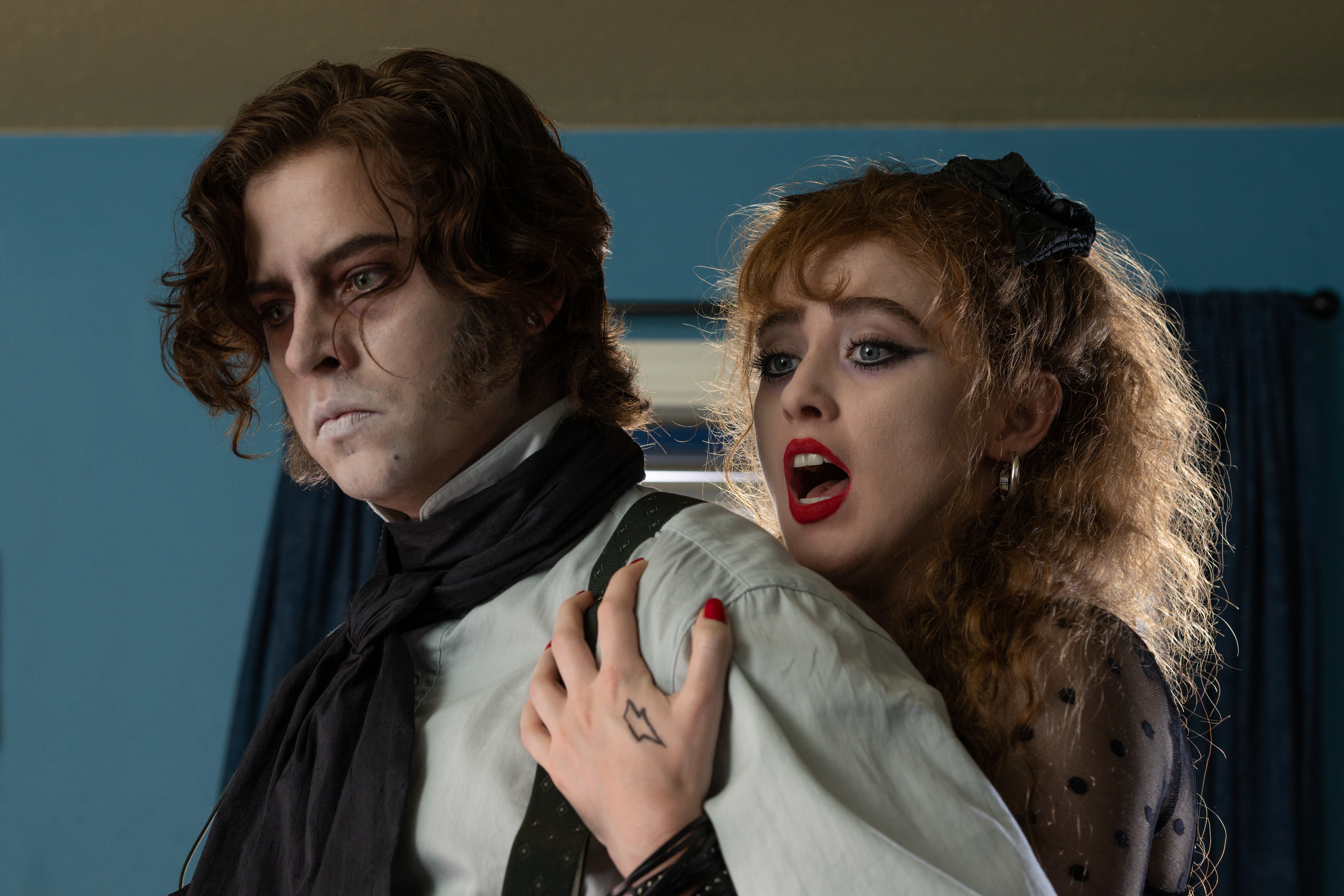
Imaginary, Lisa Frankenstein, Netflix’s The Beautiful Game, and every new movie to watch at home this weekend

- Dragon’s Dogma 2 guides, walkthroughs, and explainers
Should you give the grimoires to Myrddin or Trysha in Dragon’s Dogma 2?

All maister skills in Dragon’s Dogma 2 and how to get them
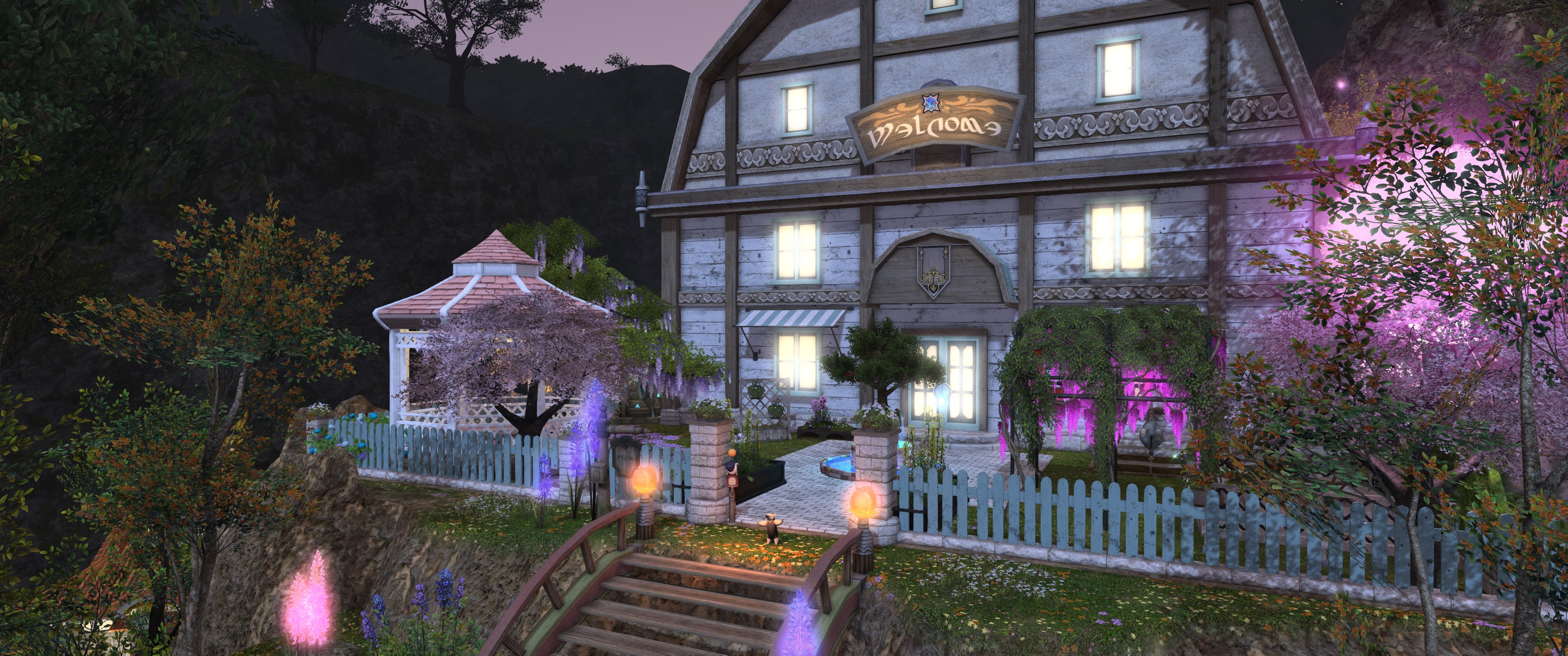
How to get a house in FFXIV
- Travel News
What a Solar Eclipse Looks Like from Space, According to an Astronaut
Ex-international space station commander terry virts spilled the beans on his space eclipse experience..
Published on 3/29/2024 at 1:25 PM

Maybe you've seen a few extraordinary meteor showers in your life, and counted more than 30 shooting stars in one night only. Or maybe, you've dropped your jaw when an incredibly colorful and vivid aurora borealis painted the night sky above a US state one time. Maybe you've also already been in complete totality during a total solar eclipse , and were able to catch a glimpse of the sun's corona in all of its magnificence.
If you've witnessed one or more of those phenomena, then congratulations—you're definitely up there with the most passionate stargazers and eclipse chasers, as catching sight of any of those events is, statistically, pretty rare.
You know what's even rarer, though? Witnessing one of those events mentioned above… but from space. Former NASA astronaut and International Space Station Commander Terry Virts can definitely say he saw an eclipse from space in 2015—and according to him, it was a sight to behold.
Commander Virts, who recently announced a partnership with the fast-food chain Sonic ahead of the total solar eclipse on April 8, sat down with Thrillist and told us all about his eclipse experience—from the ones he's spotted on Earth to the one he witnessed from space.
Thrillist: Commander Virts, to start us off and give us an idea, can you tell us how many eclipses you've witnessed in your life? Terry Virts: That's a good question. I think I've seen two partial eclipses from Earth, then I've seen one total eclipse [in] 2017, and then I saw an eclipse from space. So four or five, something like that.
And how would you describe the feeling of experiencing totality? On a scale from one to 10, a partial solar eclipse is a seven. It's pretty cool. It gets a little bit dark, but you don't really notice that much. The total eclipse was like a million when I saw it in 2017—I was shocked at how amazing it was.
What about seeing the eclipse from space instead? How did you feel? Seeing it from space was really unusual. I spent over seven months in space—I kind of saw a lot from the space station, but I've never seen anything like the eclipse.
What did it look like? You look down at Earth and you just see this black shadow moving across. [In the past,] I've seen when the moons of Jupiter make a shadow on Jupiter or on Saturn, and you can see this black spot that looks really interesting. But to see it from space on Earth was really amazing. I'm glad they told us there was going to be an eclipse because it would've been unsettling, to say the least, to look over and see this big giant black thing moving across the planet.
Could you still make out the shape of the Earth? Oh, yeah. There was Earth, it was the middle of the day, it was over the North Atlantic and it was cloudy. There were a lot of clouds down below. So it was just a normal day with this big black circle moving across the planet.

Who did you witness the eclipse from space with? It was me and Samantha Cristoforetti, an Italian astronaut.
And what was your guys' reaction to it when it happened? Samantha's not easy to impress. She's done a lot. She's seen a lot. And she was really impressed. It was really special to see that from space. We didn't actually fly through the moon's shadow, so we didn't see the actual eclipse from the space station, but I think it was even more amazing to look down and see the shadow on the Earth.
What would you say was the main difference between witnessing the total solar eclipse from Earth and from space, aside from the fact that, obviously, the visuals are different? Well, the big difference was it didn't get dark, so it was still daylight where I was in space. Whereas when you see the total eclipse from Earth, it turns into nighttime. It's really wild.
I guess it's safe to say that for most of our readers (and myself included), witnessing a total solar eclipse from space is an impossible scenario. Some people, though, will be able to fly on commercial planes during the total solar eclipse, which is possibly the closest thing to it. Would you be able to explain what they are going to see? Well, if you're on just a normal commercial flight going from A to B, you're probably not going to be under the path of totality while the shadow goes over. But you may be able to look down on Earth and see it dark, which will be really cool! If you're at least nearby, look out and you might get a chance to see it—like I saw it from space.
If you luck out and you happen to be under the path of totality [...] it'll get dark inside the airplane, [and] you'll be able to see a sunset view on the horizon, no matter what window you look out. If the pilot's nice, he can bank up and one half of the airplane will be able to look up and see the eclipse.
Ready to go stargazing?
Here are all the best stargazing events that you can get out and see this month or you could stay in and stream the northern lights from home. If you're just getting started, check out our guide to astronomy for beginners or easy stargazing road trips from big US cities .
Want more Thrillist? Follow us on Instagram , TikTok , Twitter , Facebook , Pinterest , and YouTube .
I will fight for overhead space on a plane, but I shouldn't have to | Cruising Altitude
I’ll admit it. I will elbow you out of the way to get on the plane 30 seconds sooner and secure overhead bin space. I’m not proud of it, but I'll probably never see you again, and I really don’t want to have to check a bag on most flights.
I’m part of the problem, but I’m not alone. The bag wars just keep heating up.
“We travel a couple times a year, about four times a year, and we’re noticing that we don’t have any overhead space for our bags. When people are getting on the plane, they’re taking the first (space) available,” Elaine DiCresce, a retiree from Minneapolis, told me. “The last few times, we actually checked our bags at the gate. It’s just frustrating.”
So how did we get here? Why is overhead bin space at such a premium, and what can be done about it? Here’s what I learned.
Who sets carry-on bag rules?
Most flights have a 1 + 1 rule: one carry-on bag that goes in the overhead bin and one personal item that fits under the seat in front in economy and on most domestic flights. But these guidelines are flexible and not set in stone.
“The airlines make the rules,” Loulu Lima, founder of the Texas-based travel agency Book Here Give Here , told me. “This is real simple, and every airline has a different rule.”
That is to say, there’s no overarching regulation about what carry-on bags have to be, just that most airlines use similar equipment and set standards more or less the same way.
“Sometimes you’ll hear an agent blame the FAA, but that’s not true,” said Brett Snyder, author of the blog Cranky Flier and owner of the travel agency Cranky Concierge.
But whenever you fly, it’s a good idea to check the details of your carry-on allowance.
Lima said each airline has slightly different dimensions for allowable carry-on bags, and different tickets have different rules. Some basic economy tickets might not allow for overhead bin baggage, and ultra-low-cost carriers like Spirit and Frontier may charge an extra fee for carry-on bags.

What are the best ways to secure overhead bin space?
Unfortunately, there’s no great strategy here. The best way to access a bin on most airlines is to be in an early boarding group, which usually means having a more premium ticket, having frequent flyer status with the airline, holding the right credit card, or paying for access.
“I hate to say it, but sometimes I would join a credit card that gets you earlier boarding or buy that early boarding space. It really depends on the airline," Lima said.
How can overhead bin space be less competitive?
First, a brief detour to look at why bin space is so sought-after in the first place:
“We initially got there when checked bags were still free, but people were primarily concerned that their checked bag would be lost,” Snyder said. “When (airlines) started charging for checked bags, then it became even more important for people, because people don’t want to pay for it.”
Lima agreed that passengers mistrusting airlines is a big part of why so many passengers rely solely on carry-ons on their trips.
“We’ve all become control freaks to a certain extent,” she said. “There’s no trust that the bag is actually going to make it. Why do you think the AirTags and the Tiles and all of these other things are so popular these days?”
Airlines are aware that access to bins is competitive and frequently tout improvements that mean more space for rollaboards. In fact, just on Tuesday, United Airlines announced it was installing larger bins on its Embraer E175 regional jets, operated by Skywest. Regional jets, which typically fly short routes, are notoriously tight on carry-on space.
Beyond physical improvements to overhead bins, airlines can’t do much to help with the competition, though.
Snyder said airlines can encourage or require passengers to gate-check their bags but acknowledged that sometimes backfires, especially if they start forcing checks before the overhead bins are full.
And, of course, airlines can charge for overhead bin access, which is unpopular with passengers, but it does smooth things along at the boarding door.
“You have airlines like Spirit and Frontier, they charge you more to carry-on than to check a bag,” Snyder said. “You don’t see the same kind of mad dash that you see on other airlines to get on board just so you can claim your bin space.”
Yet, the efficacy of such practices is somewhat limited.
For DiCresce and her husband, Clifford, they’re left wondering why airlines don’t assign slots in the overhead bin like seats, and to be honest, I think it’s a fair question to which I don’t have an answer.
Expert packing tips
Until new innovations or some sort of sorcery make overhead bin space unlimited, we’re stuck duking it out with fellow passengers for whatever we can get.
Lima said that she usually travels with carry-on bags only and that you can minimize the space you need by being strategic about how and what you pack.
“I’ve gone to China and to Finland for three weeks and I’ve had different temperature changes,” she said. “I’m all about rolling and, as a plus-sized woman, my clothes are bigger than most, so if I can do it, everyone else can do it, too.”
For Snyder, the best way to avoid the stress is to just determine not to rely on the bins at all.
“When you travel without a carry-on bag, it is remarkably freeing. You, all of a sudden, don’t care when you board if you have an assigned seat,” he said.
And I’ve seen for myself that the checked-bag system is increasingly reliable. I’ll still fight you for that overhead bin space for now, but I may be coming around to Snyder’s view.
Zach Wichter is a travel reporter for USA TODAY based in New York. You can reach him at [email protected]

Suggested Searches
- Climate Change
- Expedition 64
- Mars perseverance
- SpaceX Crew-2
- International Space Station
- View All Topics A-Z
Humans in Space
Earth & climate, the solar system, the universe, aeronautics, learning resources, news & events.

NASA Astronaut Loral O’Hara, Expedition 70 Science Highlights
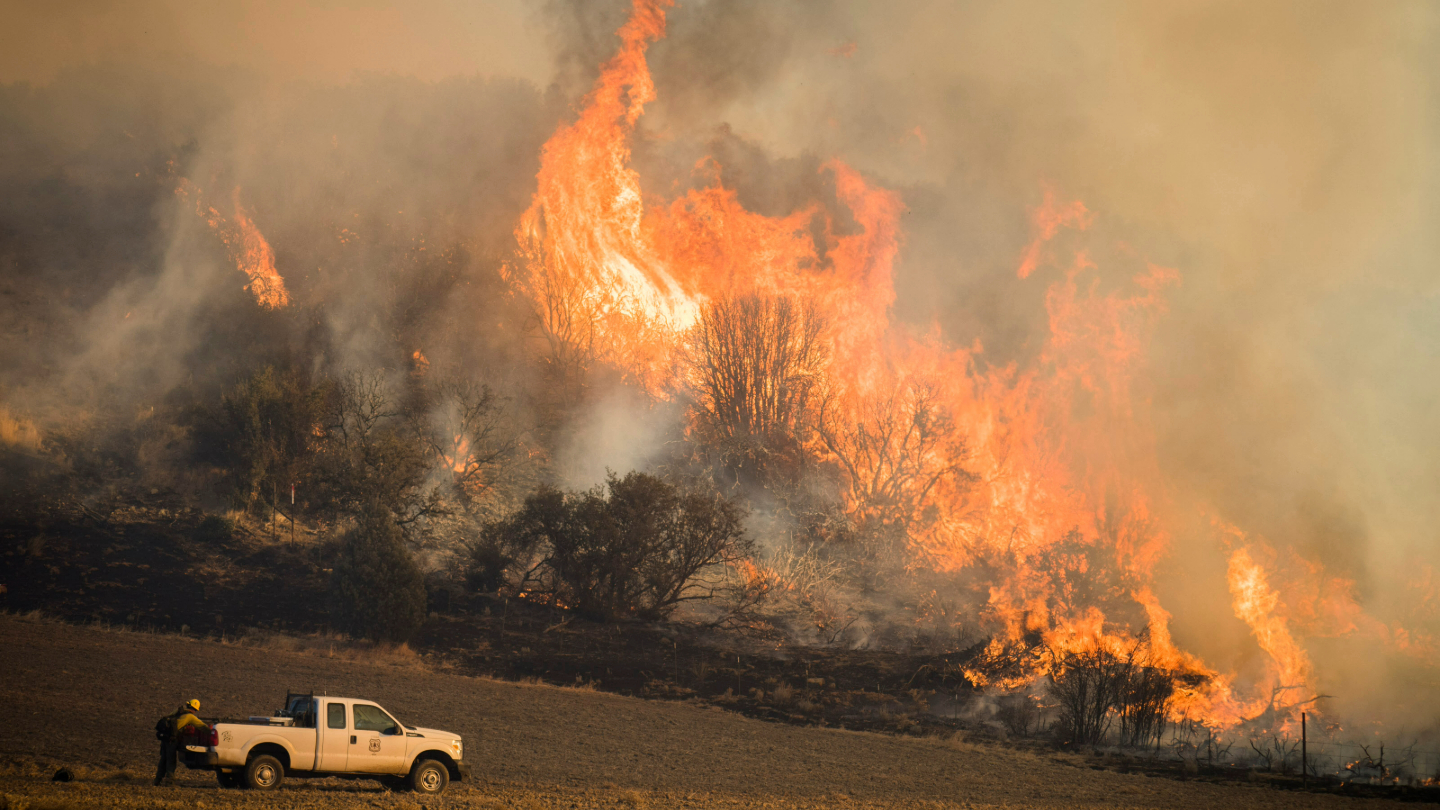
NASA Data Shows How Drought Changes Wildfire Recovery in the West
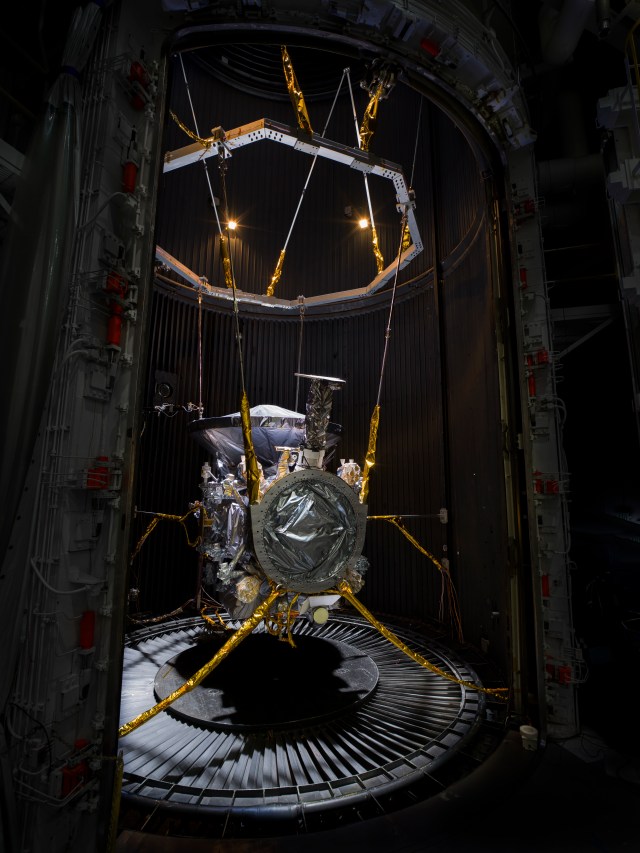
NASA’s Europa Clipper Survives and Thrives in ‘Outer Space’ on Earth
- Search All NASA Missions
- A to Z List of Missions
- Upcoming Launches and Landings
- Spaceships and Rockets
- Communicating with Missions
- James Webb Space Telescope
- Hubble Space Telescope
- Why Go to Space
- Astronauts Home
- Commercial Space
- Destinations
- Living in Space
- Explore Earth Science
- Earth, Our Planet
- Earth Science in Action
- Earth Multimedia
- Earth Science Researchers
- Pluto & Dwarf Planets
- Asteroids, Comets & Meteors
- The Kuiper Belt
- The Oort Cloud
- Skywatching
- The Search for Life in the Universe
- Black Holes
- The Big Bang
- Dark Energy & Dark Matter
- Earth Science
- Planetary Science
- Astrophysics & Space Science
- The Sun & Heliophysics
- Biological & Physical Sciences
- Lunar Science
- Citizen Science
- Astromaterials
- Aeronautics Research
- Human Space Travel Research
- Science in the Air
- NASA Aircraft
- Flight Innovation
- Supersonic Flight
- Air Traffic Solutions
- Green Aviation Tech
- Drones & You
- Technology Transfer & Spinoffs
- Space Travel Technology
- Technology Living in Space
- Manufacturing and Materials
- Science Instruments
- For Kids and Students
- For Educators
- For Colleges and Universities
- For Professionals
- Science for Everyone
- Requests for Exhibits, Artifacts, or Speakers
- STEM Engagement at NASA
- NASA's Impacts
- Centers and Facilities
- Directorates
- Organizations
- People of NASA
- Internships
- Our History
- Doing Business with NASA
- Get Involved
- Aeronáutica
- Ciencias Terrestres
- Sistema Solar
- All NASA News
- Video Series on NASA+
- Newsletters
- Social Media
- Media Resources
- Upcoming Launches & Landings
- Virtual Events
- Sounds and Ringtones
- Interactives
- STEM Multimedia
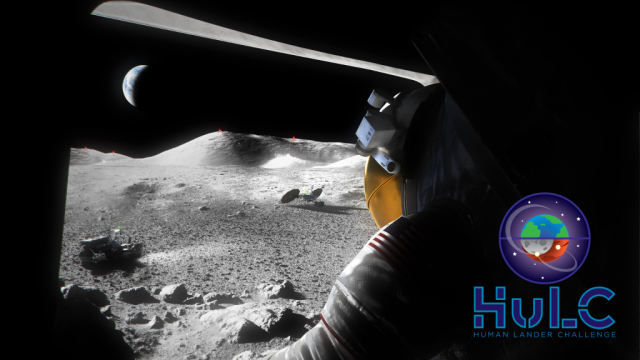
NASA Names Finalists to Help Deal with Dust in Human Lander Challenge
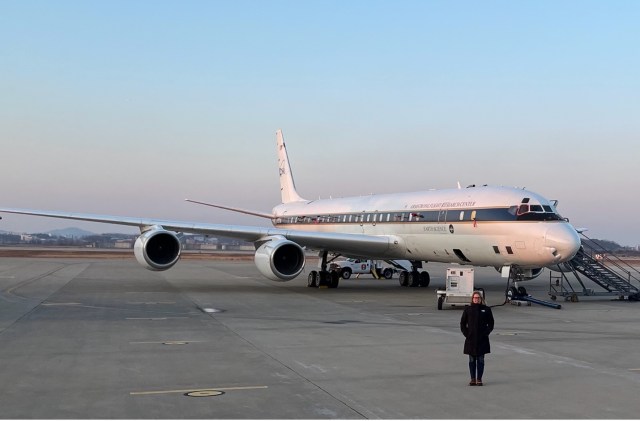
Langley Celebrates Women’s History Month: The Langley ASIA-AQ Team
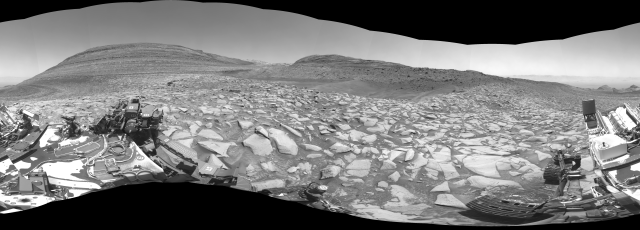
NASA’s Curiosity Searches for New Clues About Mars’ Ancient Water

Diez maneras en que los estudiantes pueden prepararse para ser astronautas

Optical Fiber Production
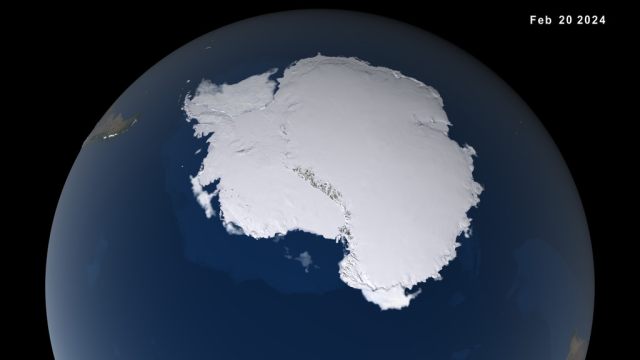
Antarctic Sea Ice Near Historic Lows; Arctic Ice Continues Decline

Early Adopters of NASA’s PACE Data to Study Air Quality, Ocean Health
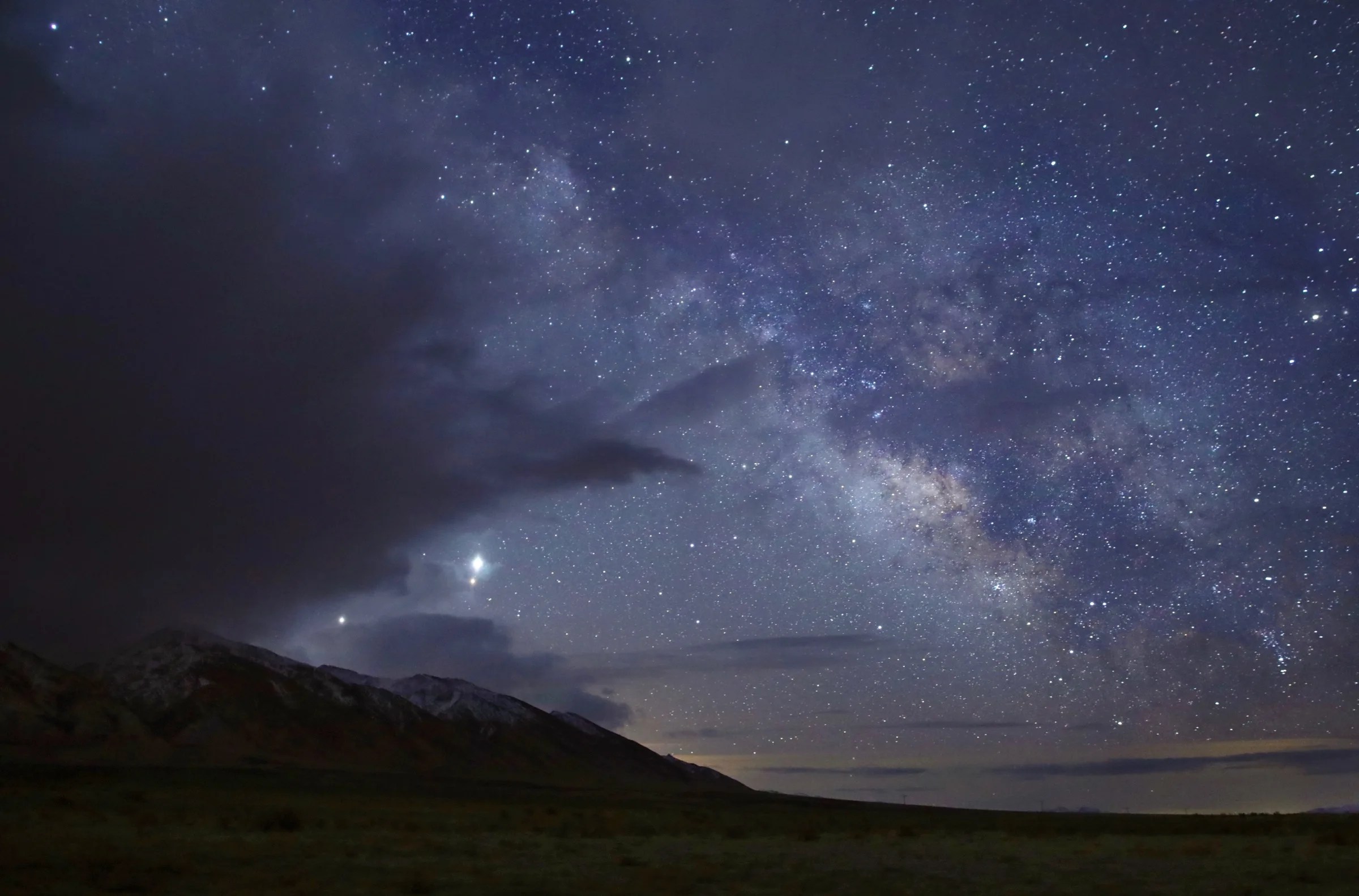
What’s Up: March 2024 Skywatching Tips from NASA
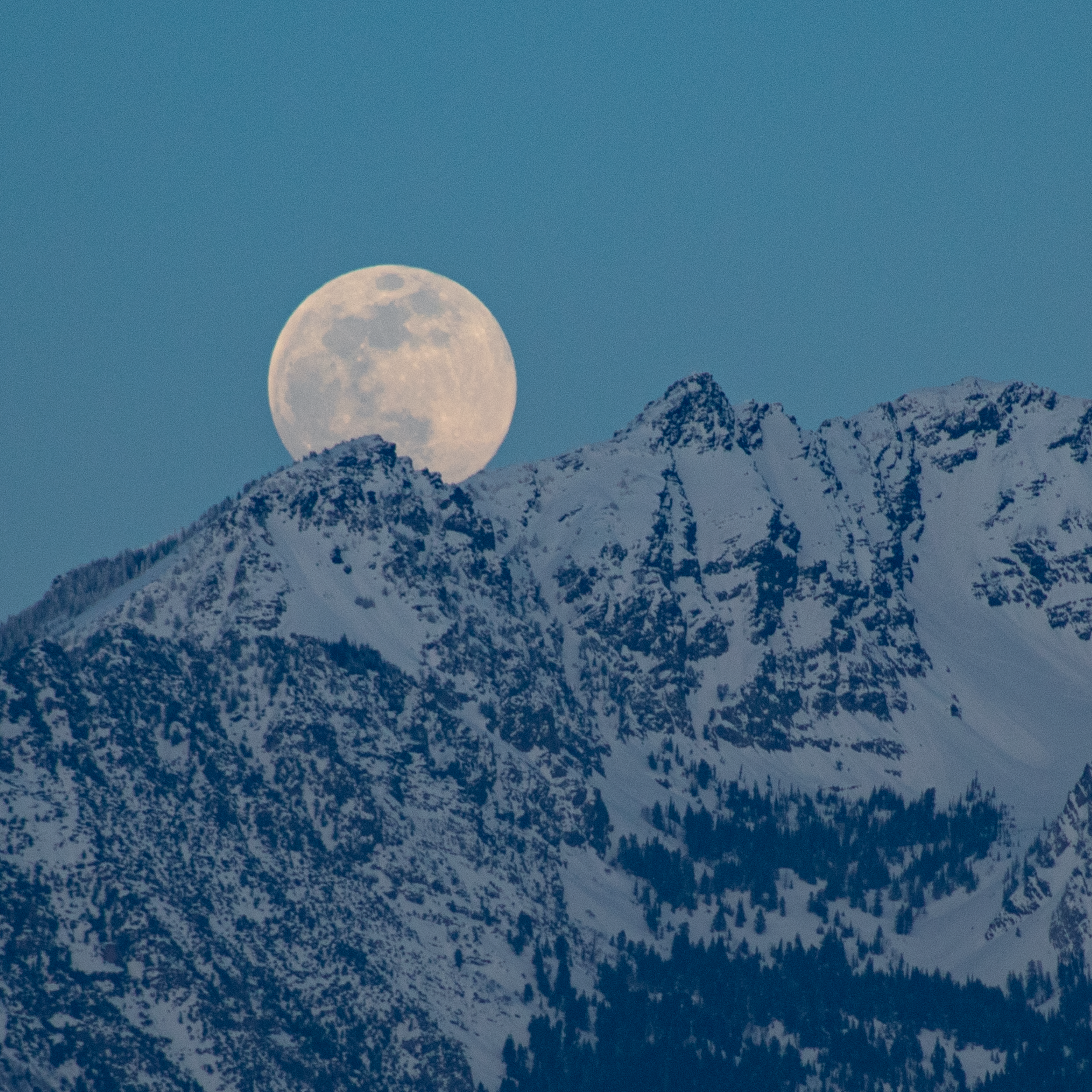
March-April 2024: The Next Full Moon is the Crow, Crust, Sap, Sugar, or Worm Moon

Planet Sizes and Locations in Our Solar System
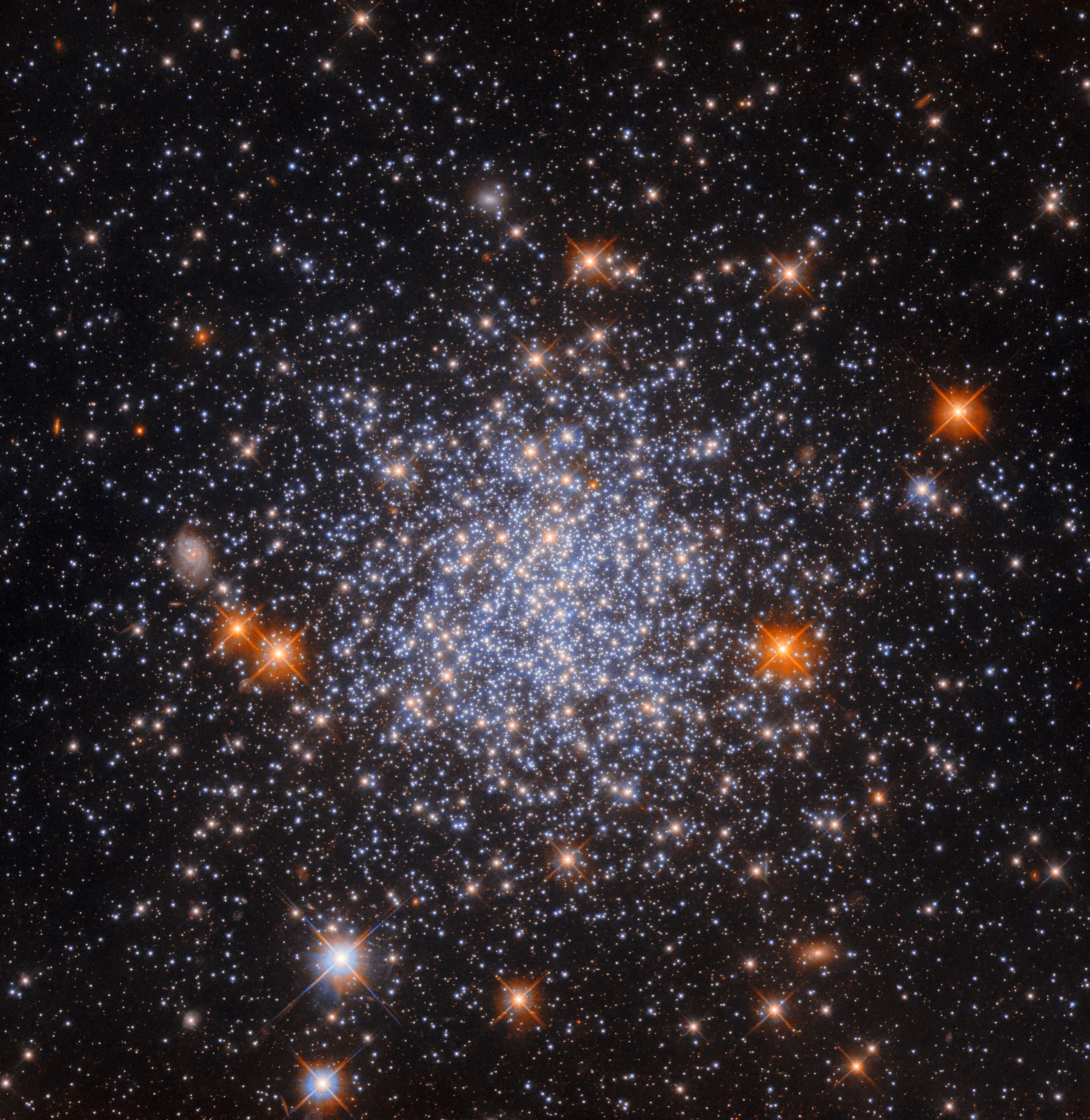
Hubble Finds a Field of Stars
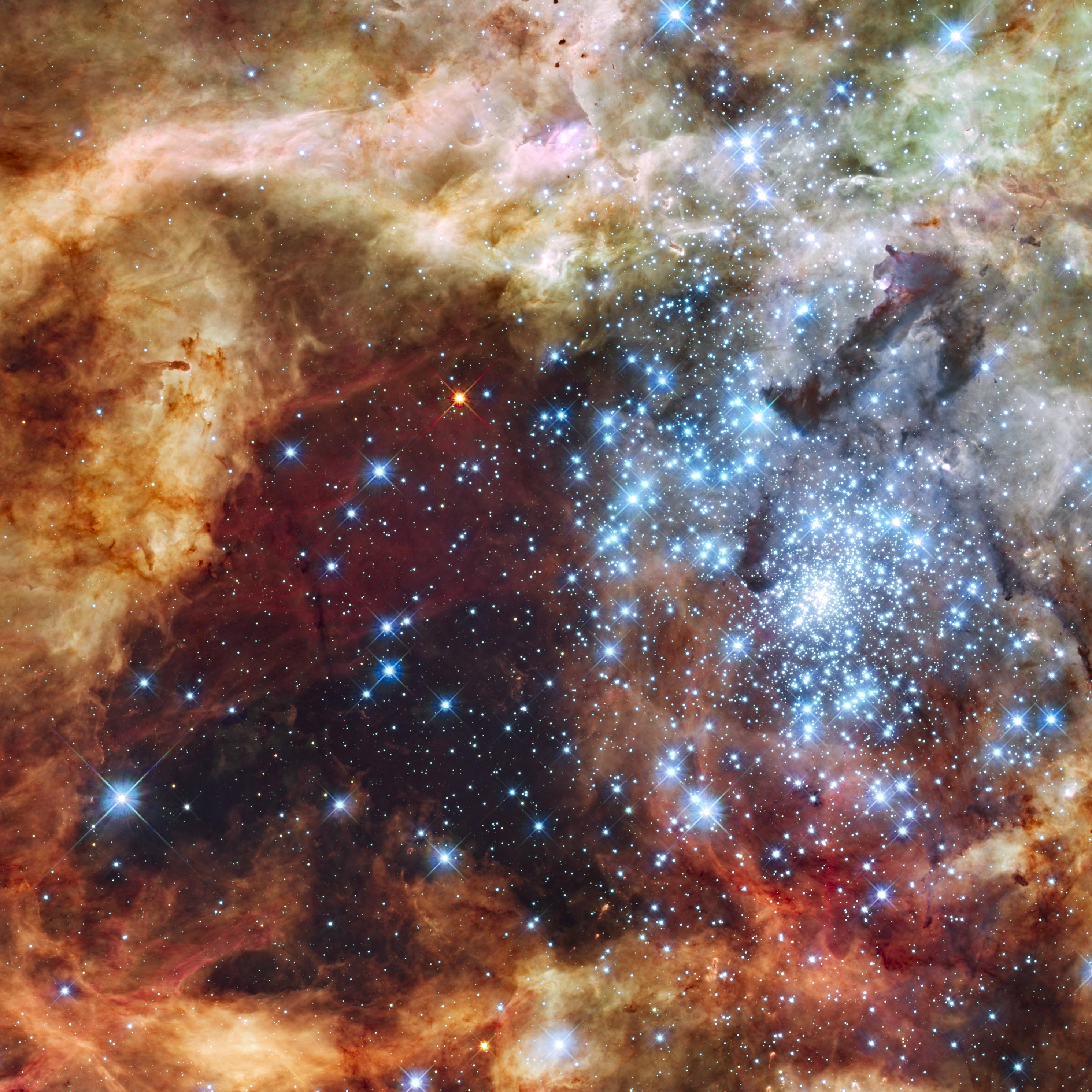
Three-Year Study of Young Stars with NASA’s Hubble Enters New Chapter
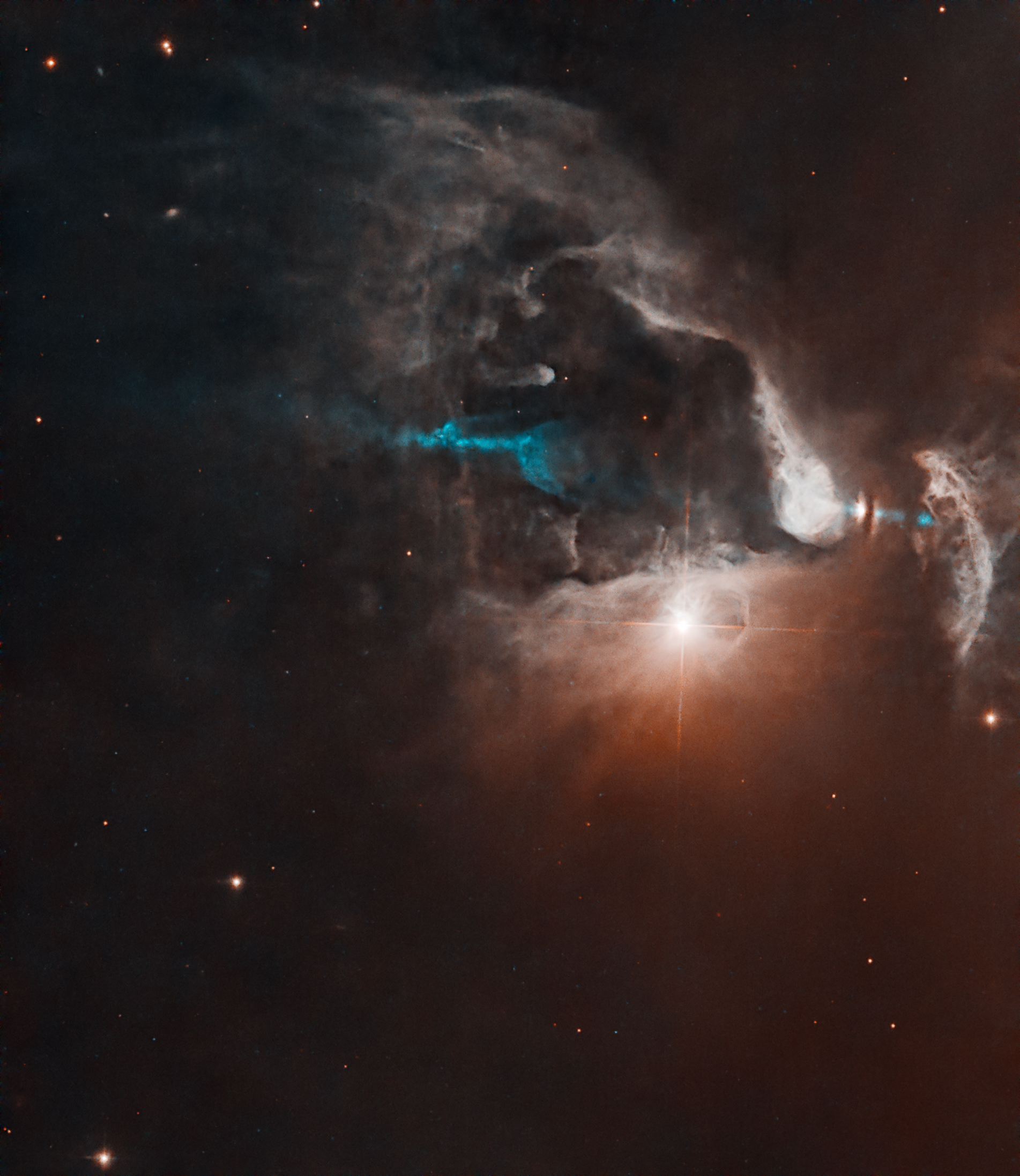
Hubble Sees New Star Proclaiming Presence with Cosmic Lightshow
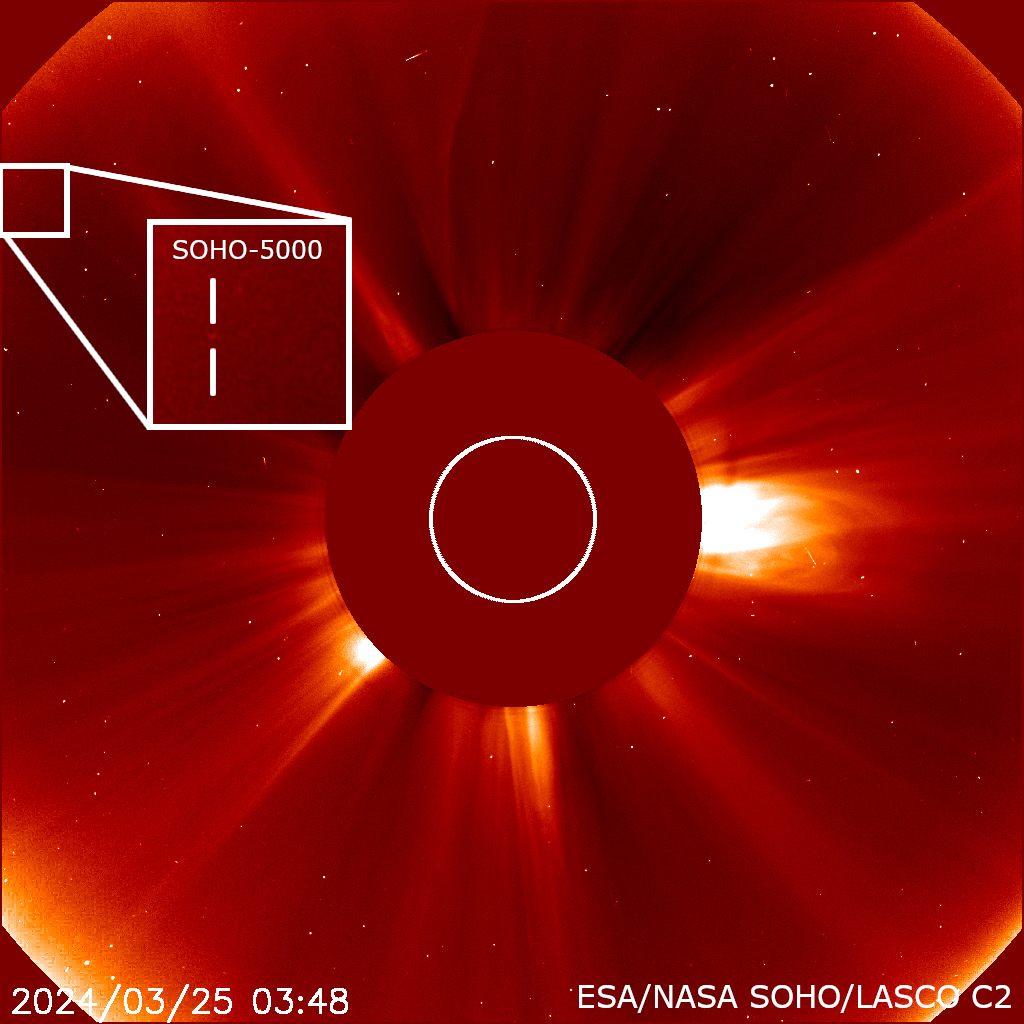
ESA, NASA Solar Observatory Discovers Its 5,000th Comet

ARMD Solicitations
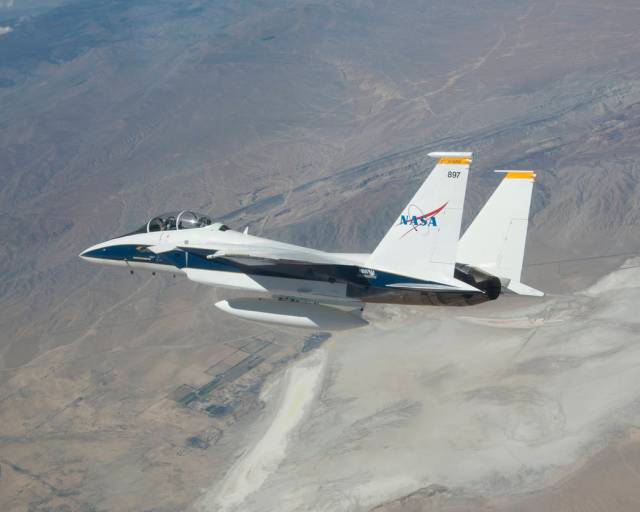
F-15D Support Aircraft

University Teams Selected as Finalists to Envision New Aviation Responses to Natural Disasters

David Woerner

Tech Today: Cutting the Knee Surgery Cord
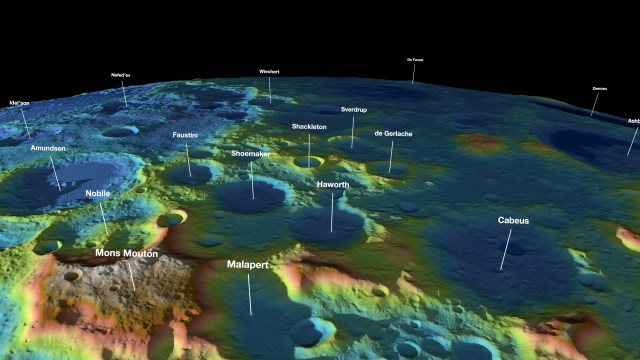
NASA, Industry Improve Lidars for Exploration, Science
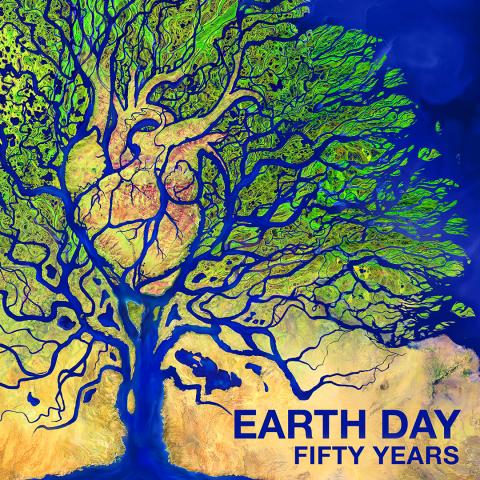
Earth Day 2020: Posters and Wallpaper
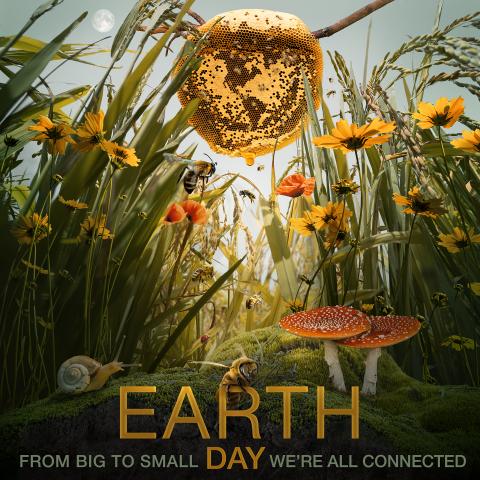
Earth Day 2021: Posters and Virtual Backgrounds

Launch Week Event Details
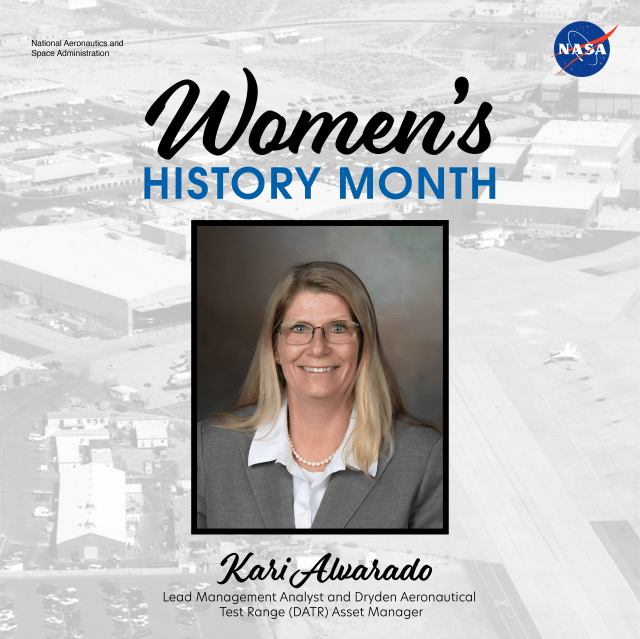
Women’s History Month: Meet Kari Alvarado
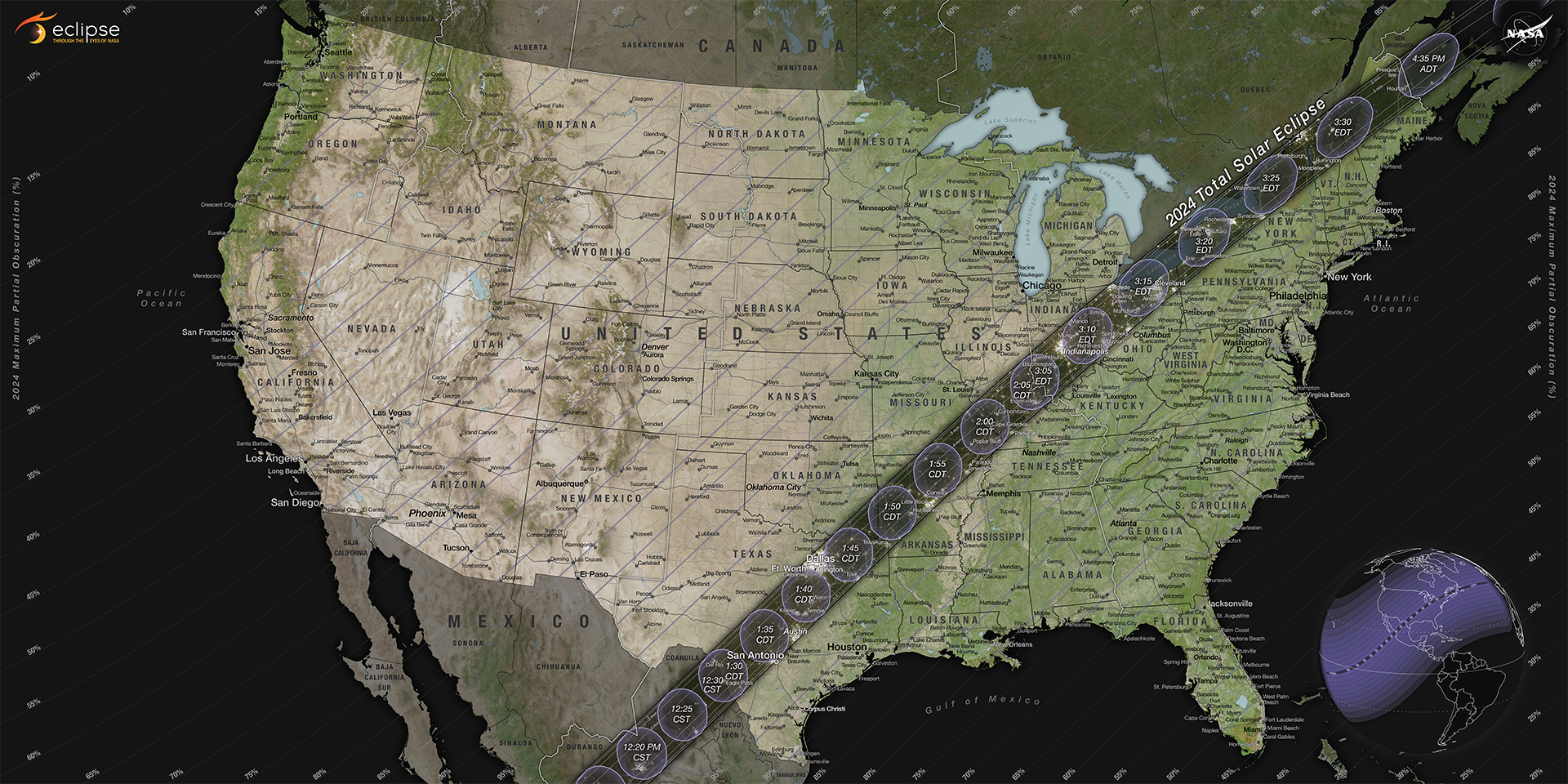
Contribute to NASA Research on Eclipse Day – and Every Day
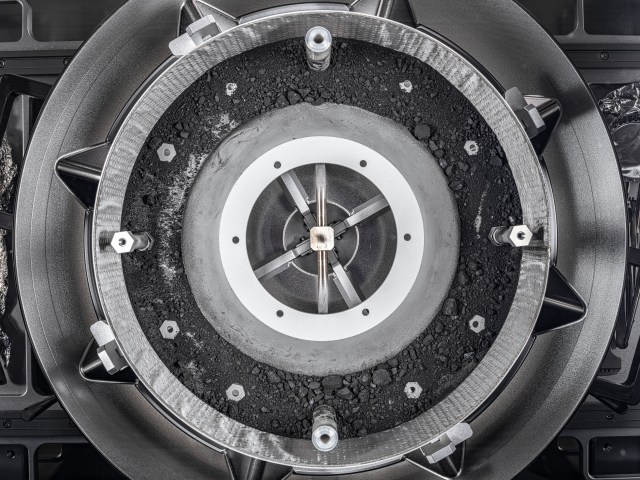
NASA’s OSIRIS-REx Mission Awarded Collier Trophy

Astronauta de la NASA Marcos Berríos

Resultados científicos revolucionarios en la estación espacial de 2023
The 1970s: kennedy dispatches probes to far reaches as apollo ends, steven siceloff, public affairs specialist.
Part 3 in Kennedy Space Center’s History series
Kennedy Space Center spent the 1970s bridging the achievements of the 1960s and the expectations of the 1980s. The center emerged from the decade as a place of adaptation and innovation.
The 10-year span saw Kennedy help NASA reach farther into space than ever before. The center launched men to the moon five times, rescued a crew during an emergency, sent America’s first space station into orbit and then lofted a pair of spacecraft on a rare journey to see the four outer planets up -close.
Even the missions that fell in between those stand as civilization-defining scientific milestones. The twin Viking landers, for example, set down softly on the Martian surface and beamed back the first analysis of the rust-colored soil that gives the red planet its nickname.
There was also the Apollo-Soyuz flight in 1975 that saw American astronauts and Russian cosmonauts shake hands in space for the first time, a preview of the relationship that now sustains the International Space Station.
“Certainly in the manned program, it’s the transition era between this kind of radical, exciting, somewhat crazy moon program of the ’60s and this very stable, very useful shuttle program of the ’80s,” said Roger Launius, curator at the Smithsonian’s National Air and Space Museum and NASA’s former chief historian.
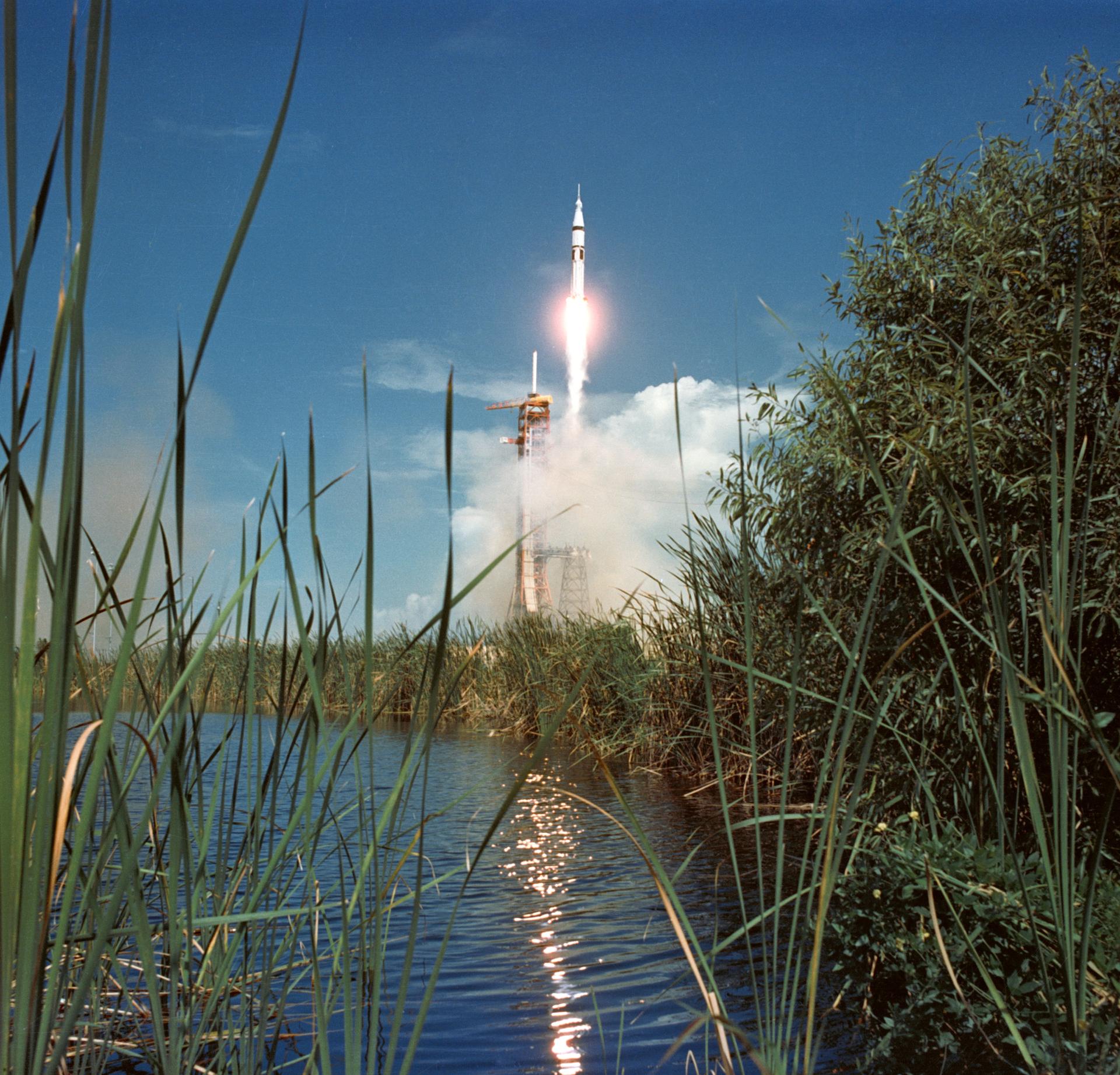
The chances of NASA accomplishing such milestones looked distant when the decade began. A year after the first moon landing, the center saw its first mass employee layoff as Apollo’s end was scheduled. Although the program’s scale was diminished, Kennedy workers still had a few Apollo missions to launch, including Apollo 13. Kennedy’s team worked closely with NASA’s other spaceflight centers through one difficulty after another to get the three astronauts back to Earth safely.
The layoffs continued through the return of Apollo 17 in December 1972, the last mission to carry astronauts to the lunar surface.
Having landed on the moon six times, NASA set its sights on Earth orbit with the Skylab program in 1973. Built inside the third stage of a Saturn V rocket, Skylab was designed to be a large workshop for astronauts. It was outfitted with life support, communications and other critical systems, as well as scientific equipment including a telescope designed to look at the sun.
Skylab developed mission-threatening problems minutes after launch when aerodynamic forces stripped a solar panel and micrometeoroid shield off the rocket as it climbed through the atmosphere into space.
As it had before, Kennedy’s team worked closely with other NASA centers to come up with a plan to save the perilously injured station. Pete Conrad’s crew of three left Kennedy aboard an Apollo spacecraft loaded with improvised tools and methods. The astronauts sprung a partially deployed solar panel and opened an umbrella-like covering over the outer shell of the workshop.
The Kennedy launch team sent the final Apollo spacecraft into orbit in 1975, timing the liftoff perfectly to allow a docking with a Soyuz capsule launched from the Soviet Union. The successful flight marked the last time an American astronaut would fly into space during the decade.
Some of the greatest achievements of the 1970s belonged to the most sophisticated machines of the day: robotic probes with computer brains, cameras and instruments that would return a scientist’s delight of information about distant worlds. Preparing the spacecraft to fly meant dealing with increasingly complex machinery and unprecedented standards to keep the spacecraft free of contaminants, particularly those vehicles making landings on other worlds.
“There is this transformation in planetary science that forces Kennedy to do payload processing it had never done before,” Launius said. “It’s critical to Viking. If they allow any biological material on the spacecraft, they’re going to get a false reading and fundamentally Viking was about biological experiments.”
Pioneer and Voyager spacecraft rode powerful boosters from the coast of Florida to start journeys that would not end until they crossed outside the solar system.
Pioneers 10 and 11 laid down paths beginning with their launches in 1972 to become the first to cross the asteroid belt between Mars and Jupiter. Both Pioneers gave Earth-bound researchers unprecedented photos of Jupiter, with Pioneer 11 going by Saturn, too. They are now far outside the orbits of the planets and moving fast enough to leave the solar system.
Two Voyager spacecraft set out in 1975 to match the Pioneers’ record by flying by four planets. Taking advantage of an alignment that happens once every 175 years, Voyagers 1 and 2 were sent on a “Grand Tour” of the outer solar system. Picking up speed with each planetary encounter, the Voyagers are farther into space than the Pioneer spacecraft. Voyager 1 is more than 11 billion miles from Earth, so far that it takes radio signals travelling at the speed of light 33 hours to reach Earth.
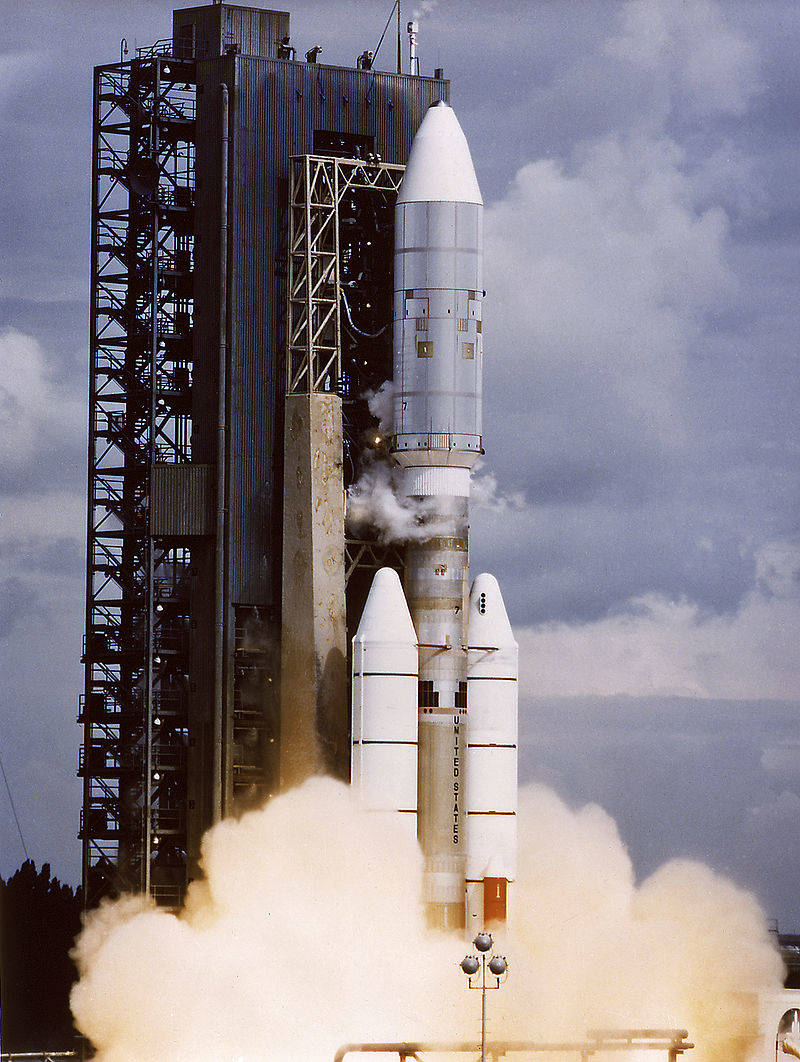
“It was a golden age of planetary science and Kennedy was the jumping-off place to make it happen,” Launius said.
Following the wind- down of the early 1970s, Kennedy’s momentum started ramping up anew towards the end of the decade when the infrastructure for the space shuttle fleet took shape and saw some testing. Enterprise, the prototype that was used to prove the shuttle design would work as a glider, was enlisted to test hardware and techniques that would be used to prepare shuttles for launch for the next 30 years.
Columbia, the first shuttle intended to fly in space, would provide one of the final milestones of the 1970s at Kennedy when it arrived atop a modified 747 Shuttle Carrier Aircraft to begin what would be a groundbreaking but arduous time of preparations for its first flight. Although that mission, STS-1, would not begin until 1981, its successes were built on the agency’s achievements throughout the decade before.
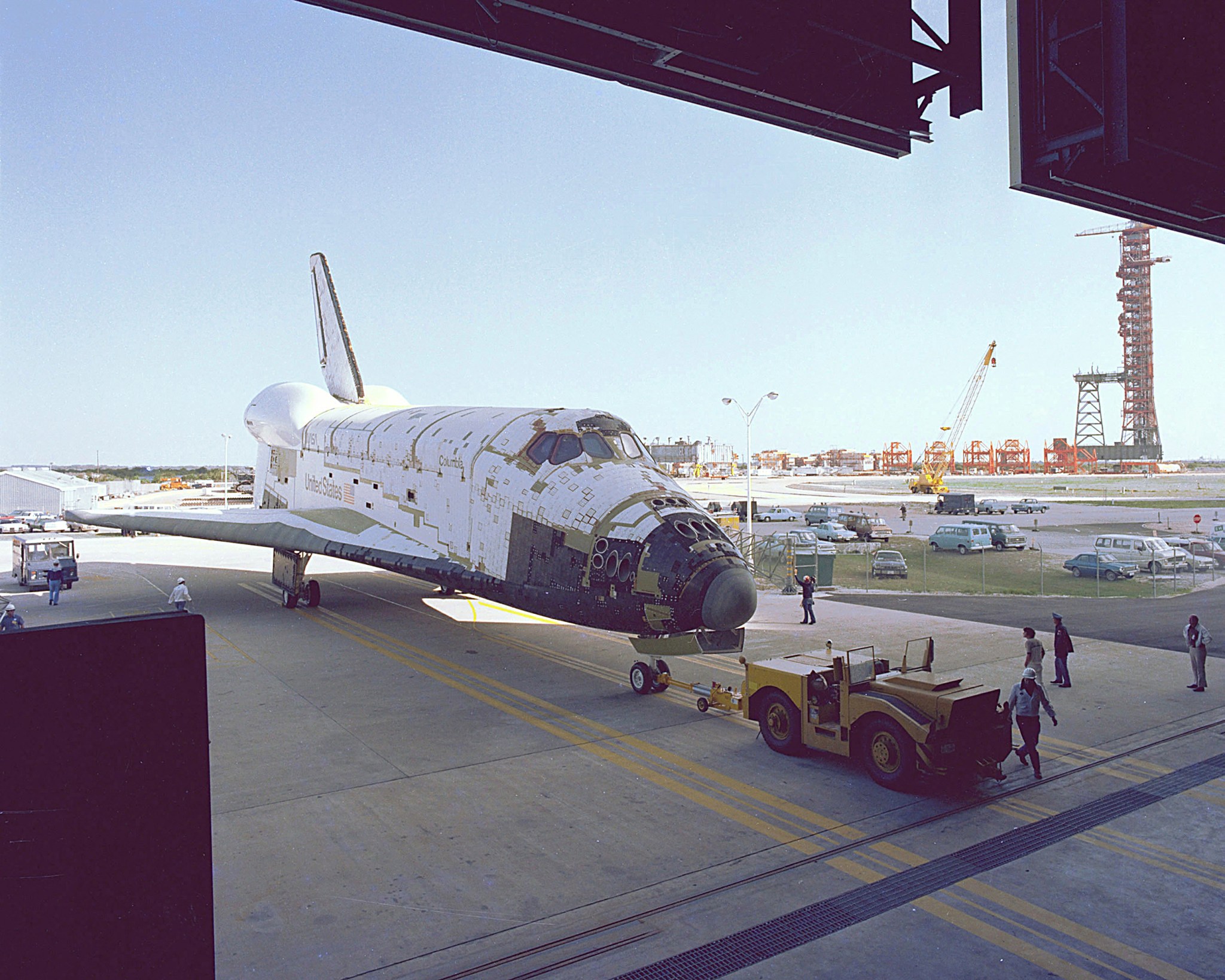
“The whole idea of processing the shuttle, nobody had any idea what that was about until the 1970s,” Launius said. “Somebody had to put in a process whereby you take an orbiter and you prepare it for flight and you do all the checkouts and you stack it and you take it out and launch it, and all that is done at Kennedy and can be done nowhere else.”
Explore More
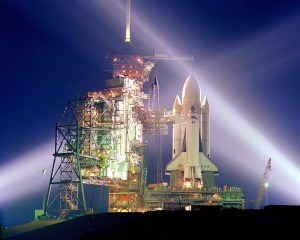
The 1980s: All Eyes Focus on Space Shuttle
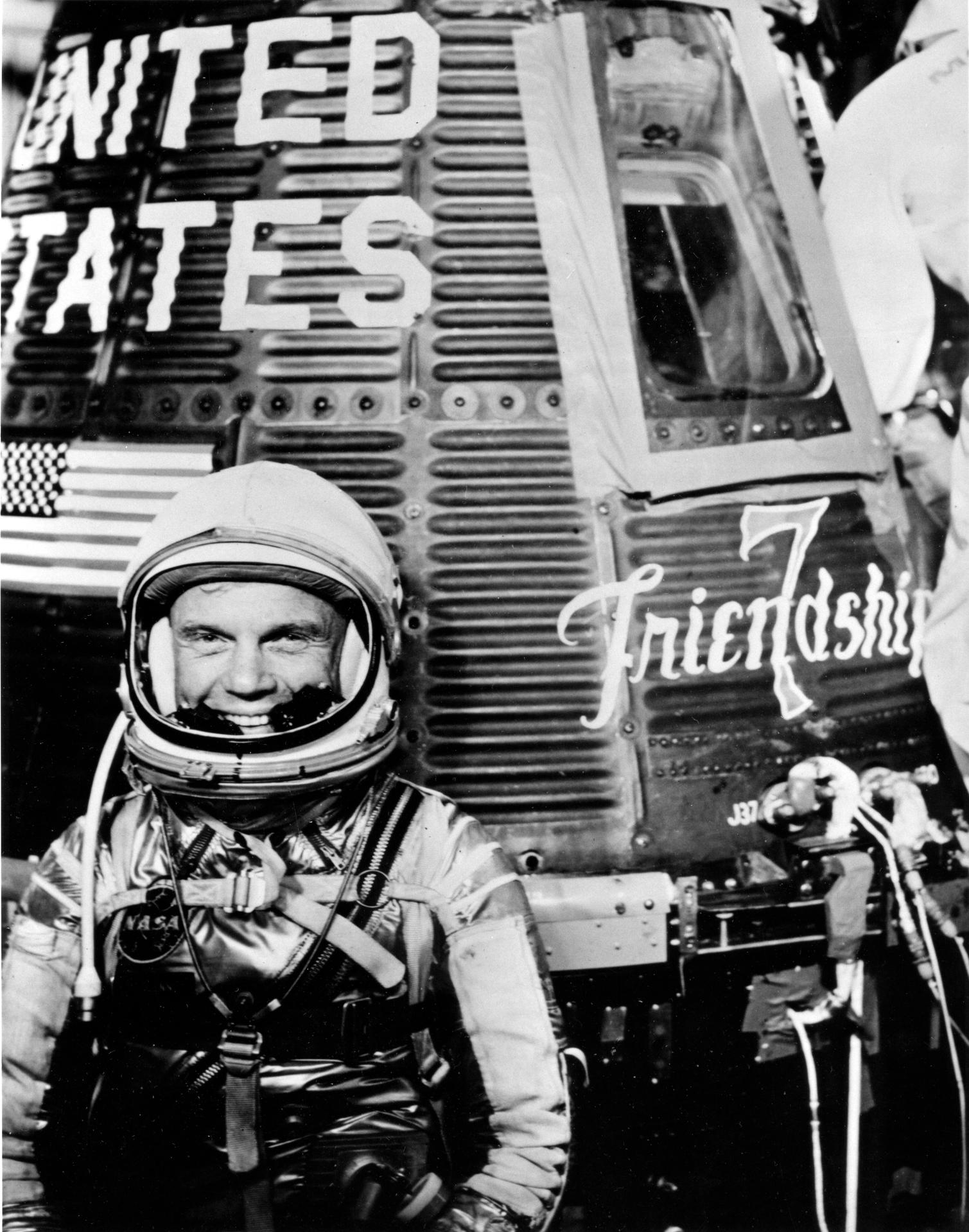
The 1960s: From Dream to Reality in 10 Years
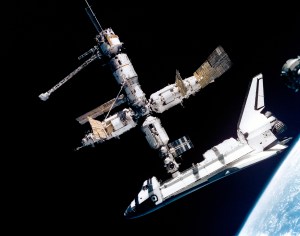
The 1990s: International Flair and Understanding the Solar System
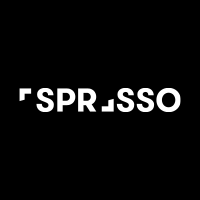
Everything you need to know about space tourism
Posted: October 12, 2023 | Last updated: October 12, 2023

Between floating in weightlessness, witnessing 16 sunrises a day and gazing into the infinite void, space travel sure sounds like an out-of-this-world experience. And now, it’s no longer a thing of the future.
That’s right, soon interstellar awe will be open to (almost) anyone, as billionaires Richard Branson, Jeff Bezos, and Elon Musk are pushing the space tourism industry to a higher orbit.
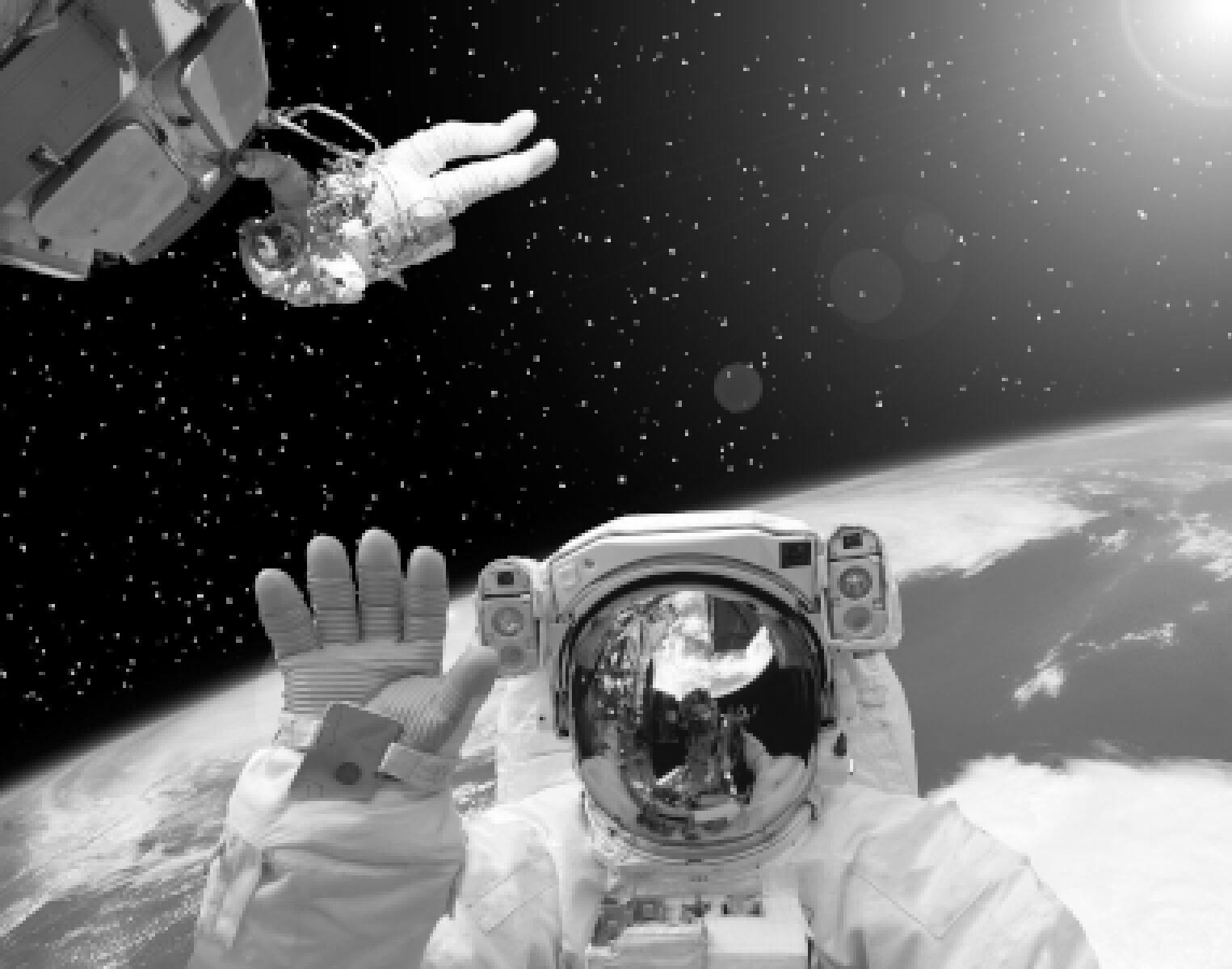
What is space tourism?
Well, it’s almost like regular tourism: travel for recreational and leisure purposes… but in outer space. Some organizations like the Commercial Spaceflight Federation and the Citizens in Space project prefer to use the terms “personal spaceflight” or “citizen space exploration,” though.
In a nutshell, it’s space travel for non-astronauts.
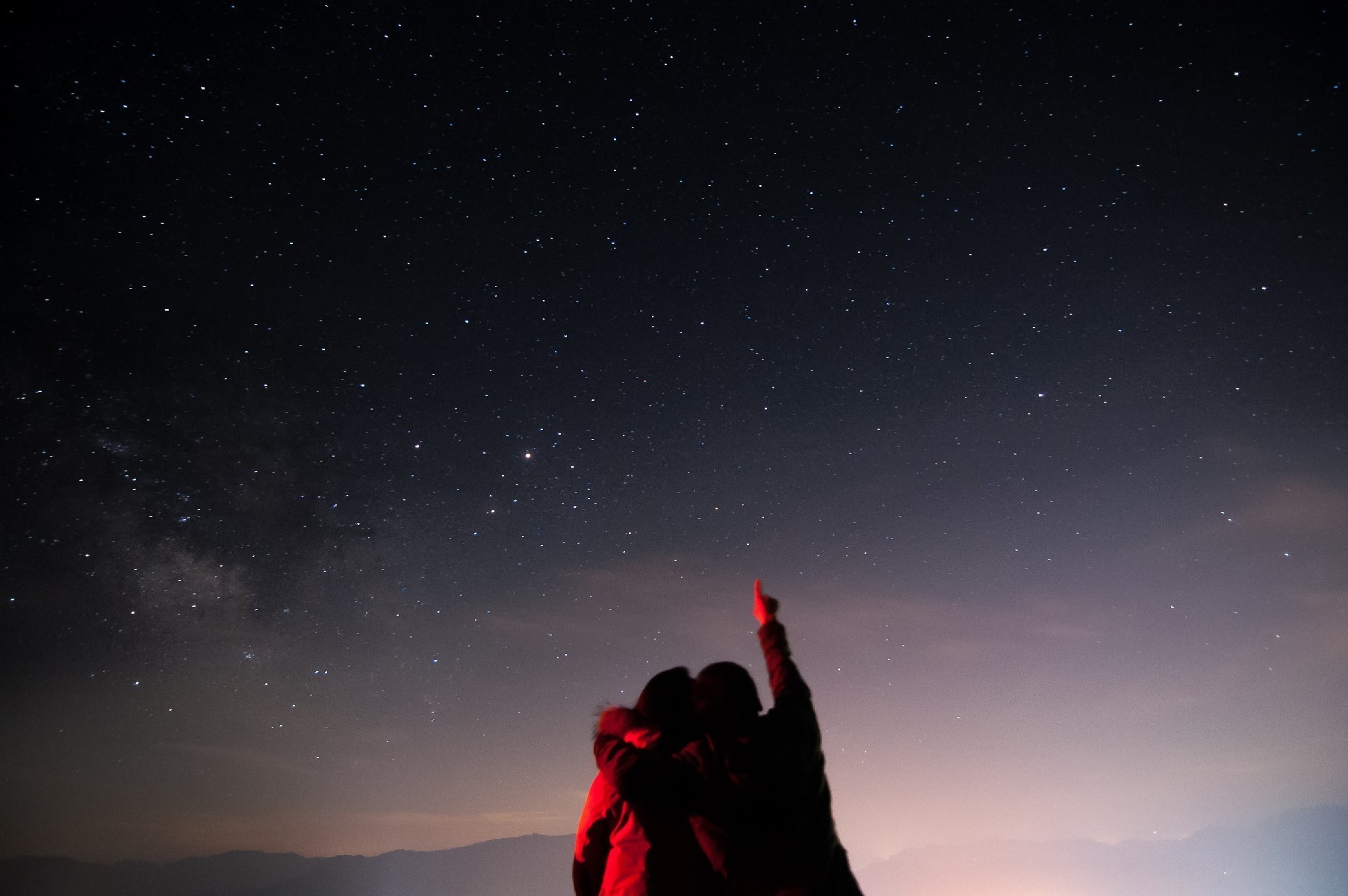
Who can travel to space?
Anyone ! Well, that is, anyone with enough money. No need to have any previous science qualifications or NASA training, especially since a trained crew will escort tourists on their galactic journey.
According to Virgin Galactic, future space tourists will be between 10 and 90 years old, and come from diverse professional and cultural backgrounds.
The only thing you need? The desire to explore the universe!
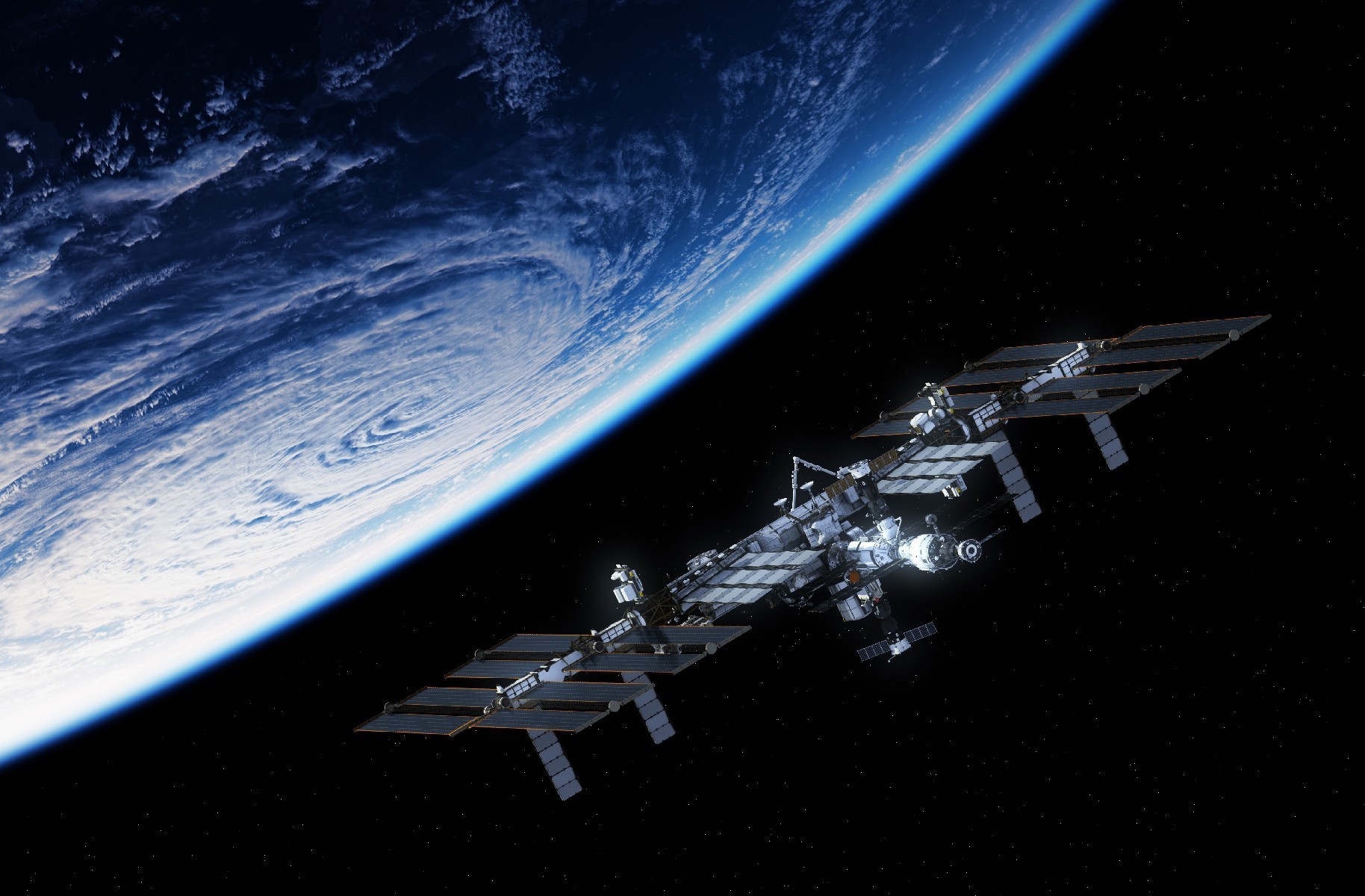
What is orbital travel?
The main difference between orbital and suborbital flights lies in the trajectory and speed of the vessels.
To go into orbit, a rocket or spaceship needs to follow a path that goes around the Earth at the very fast minimum speed of 7.7 kilometres (4.8 miles) per second, in order to keep circling and never fall back down.
It allows astronauts and travellers to stay in space for extended periods of time, hence it is for now the preferred type of flight.
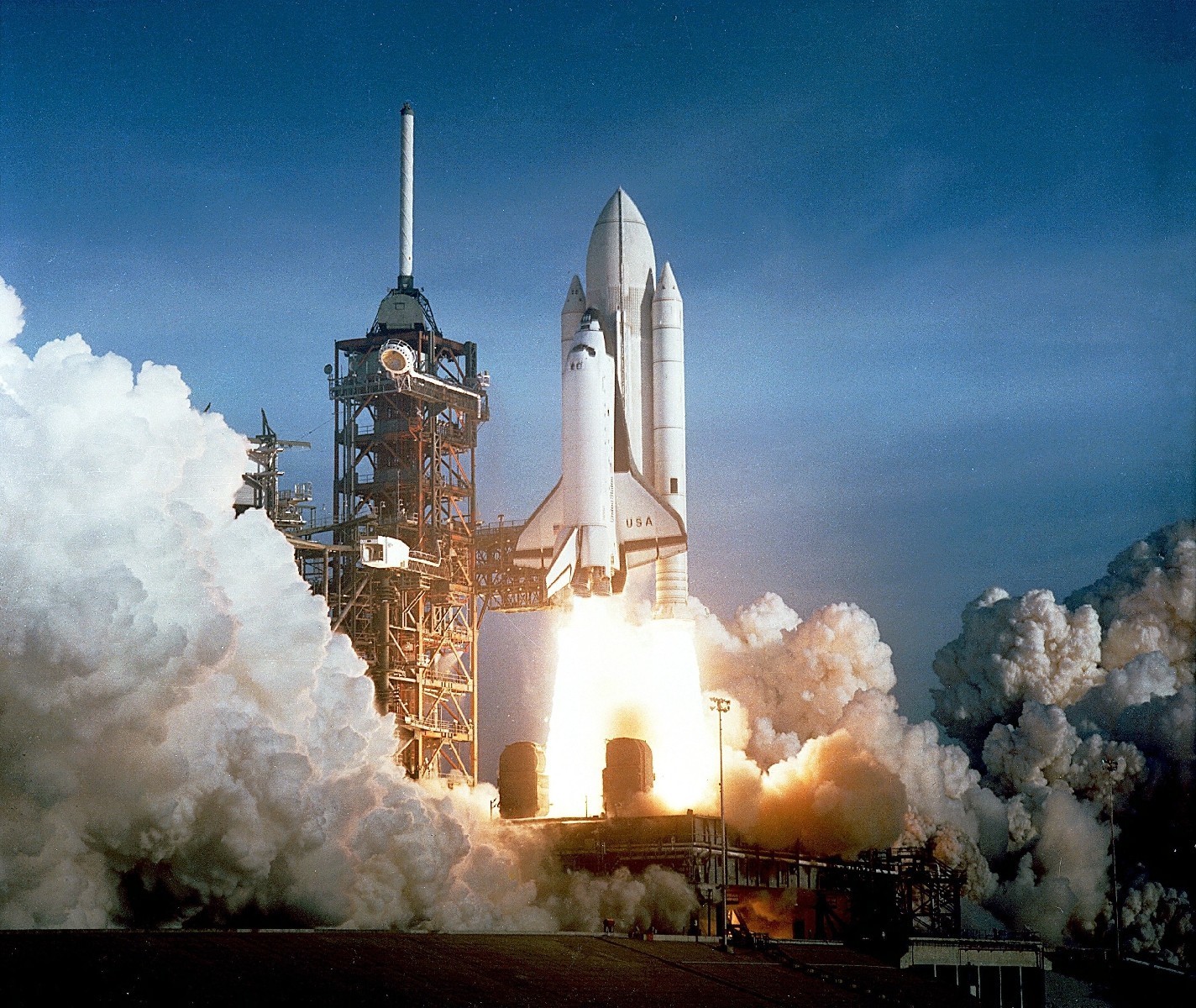
What is suborbital travel?
A suborbital flight , which is what Branson and Bezos did, “just” requires enough energy to blast off to space and then naturally fall back to Earth, making a huge arc.
It requires less energy and is less costly than orbital flights, thus opening doors for relatively affordable space tourism in the future.
Passengers would experience up to six minutes of weightlessness and a grandiose view.

How do you prepare?
Although Virgin Galactic doesn’t explicitly list its physical requirements, they did say astronauts would have to pass certain medical checkups and training programs. Blue Origin, on the other hand, has said that training for suborbital trips will only take a day.
And of course, any space tourist will also have to pass a series of thorough tests to determine whether they’re fit to fly up there.
Once in space, you may have to perform small bouts of exercise to prevent muscle wasting , which takes place after just seven days.

What is lunar tourism?
As its name hints, lunar tourism is the project of sending paying travellers to the moon. The first one could happen as soon as 2023, and would consist of a loop flight.
But three types of lunar tourism could be available in the near future: circumlunar trajectory, lunar orbit, and even lunar landing.
How cool would it be to say to someone, upon returning from a lunar vacation, “I’ve literally loved you to the moon and back”?
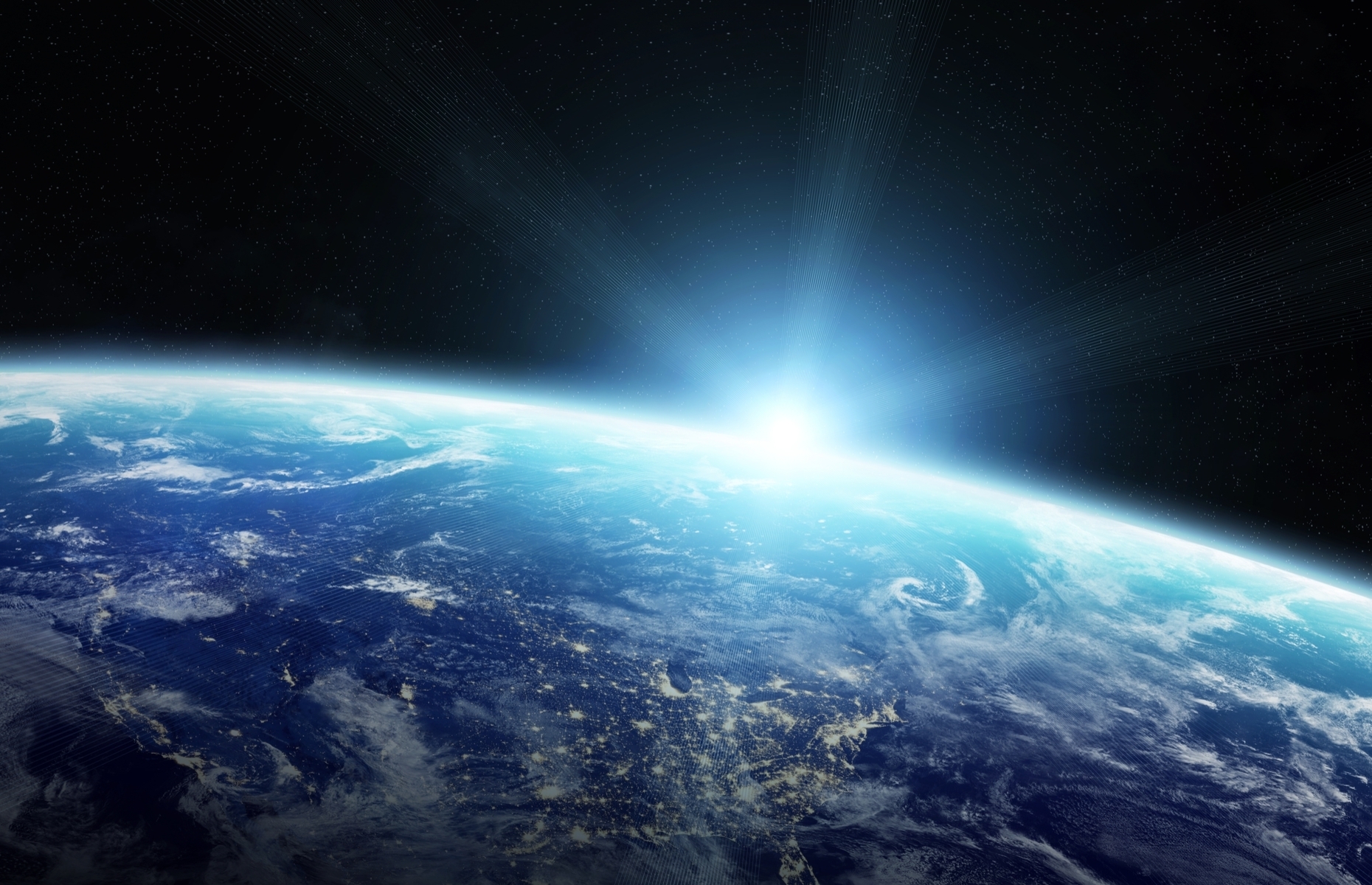
Where does space tourism take place?
Admittedly, space is a vast place. So where exactly would tourists go ?
First, any space travel begins with the Kármán line , which lies at 100 kilometres (62 miles) above sea level and is commonly accepted as the limit between Earth’s atmosphere and outer space.
Then, there are several options: orbital, suborbital, and lunar space tourism.
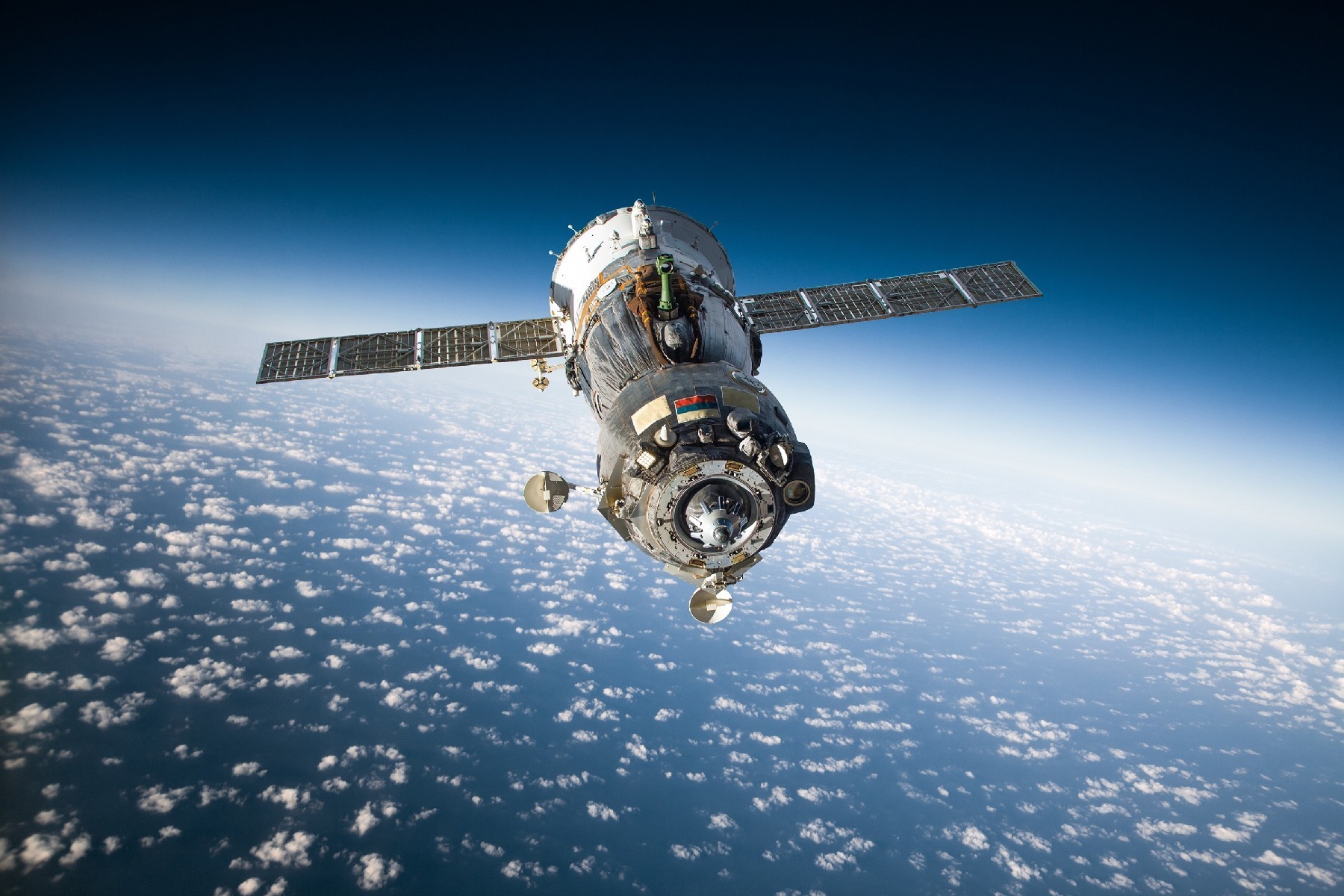
Have touristic space travels already occurred?
Yes! From 2001 to 2009, the Russian space agency and the U.S.-based space tourism company Space Adventures took seven (very wealthy) members of the public for several orbital space travels to the International Space Station.
The flights took place aboard the famous spacecraft Soyuz but stopped in 2010, since the crew of actual astronauts grew bigger and left no more seats available for paying space tourists.
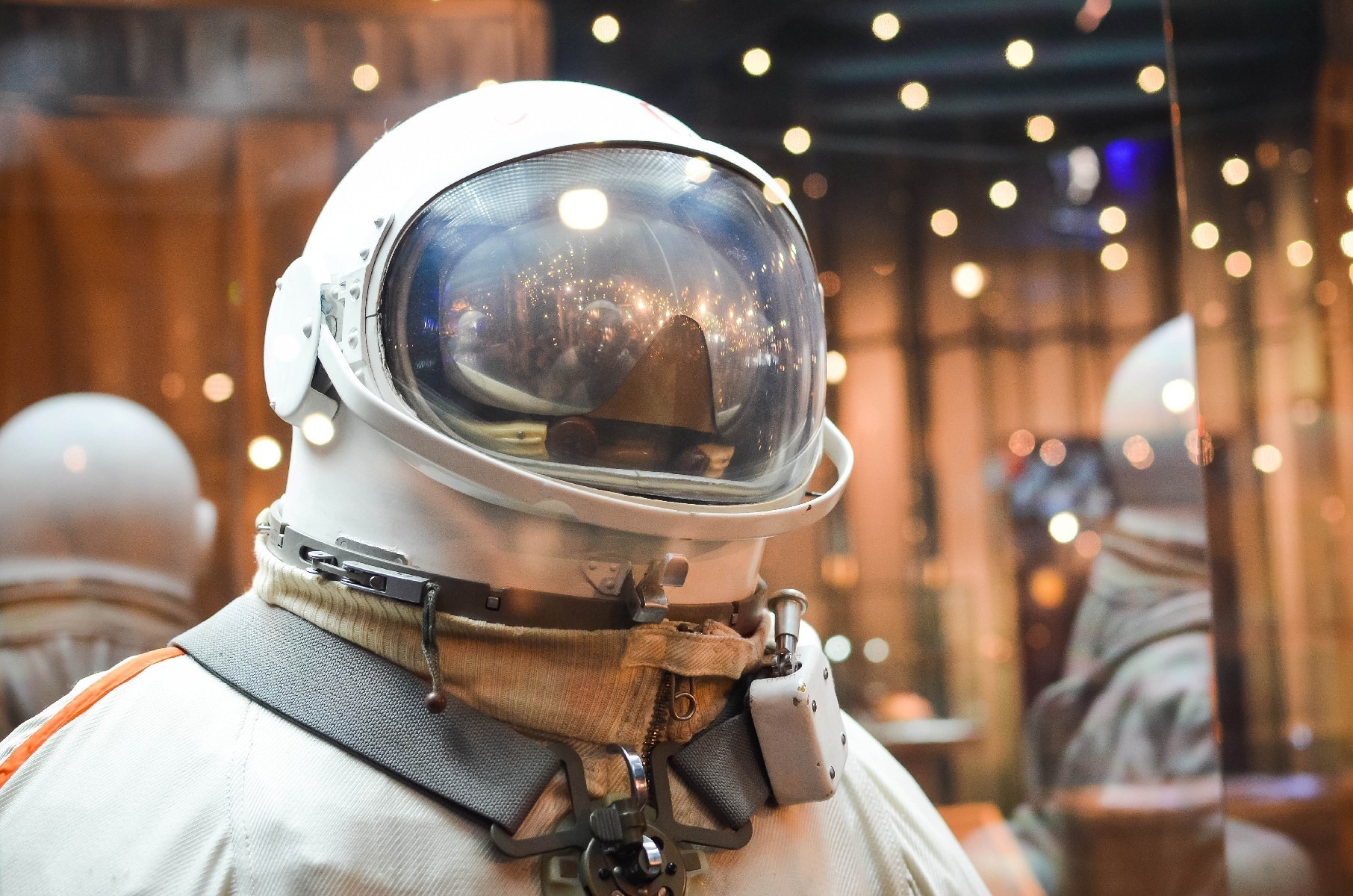
Who were the first space tourists?
The American businessman Dennis Tito became officially the first space tourist in April 2001, when he stayed for seven days on the International Space Station.
He was followed by six multimillionaire fellows from various countries: South African entrepreneur Mark Shuttleworth, American scientist Gregory Olsen, Iranian engineer Anousheh Ansari (the first female space tourist), Hungarian-American computer programmer Charles Simonyi, British video game mogul Richard Garriott, and Canadian businessman Guy Laliberté.
On July 11, 2021, billionaire Richard Branson, along with three Virgin Galactic employees and two pilots, reached an altitude of 85 kilometres (53 miles) above Earth aboard his Virgin Galactic rocket plane, the Unity. Less than 10 days later, on July 20, the world’s richest man, Amazon’s Jeff Bezos, briefly entered space on Blue Origin , his private space company’s reusable rocket. He was joined by his younger brother Mark, Dutch teenager Oliver Daemen, and Wally Funk, who, at 82 years old, became the oldest astronaut.
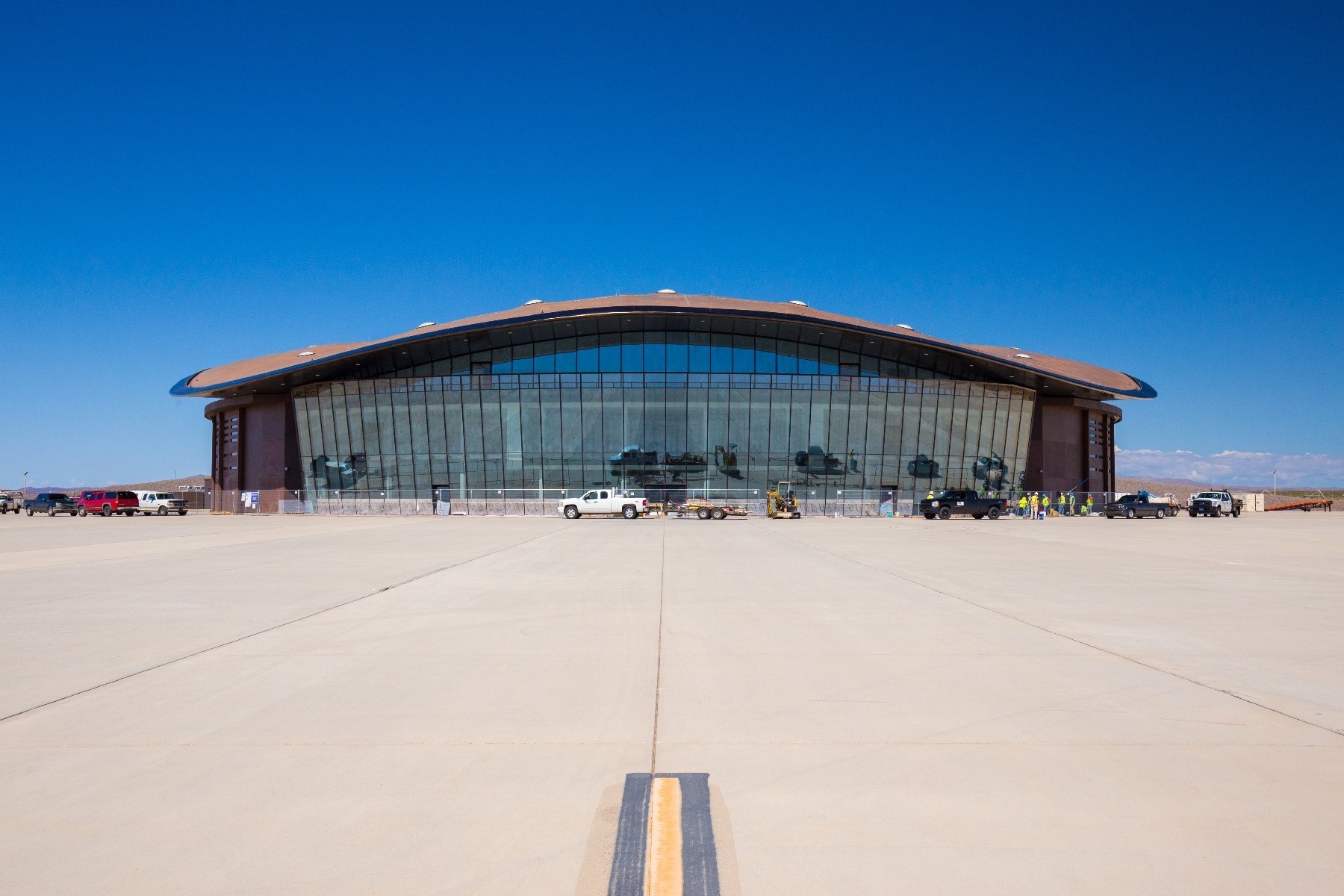
Who would be the space tourism “agencies”?
Unlike past tourism experiments, which took place aboard vessels sent off for scientific purposes, future travels will happen on private companies’ flights set up solely for space tourism.
Those pioneering aerospace companies are Richard Branson’s Virgin Galactic ; SpaceX, founded by Tesla co-founder Elon Musk ; and Blue Origin , created by Amazon founder Jeff Bezos.
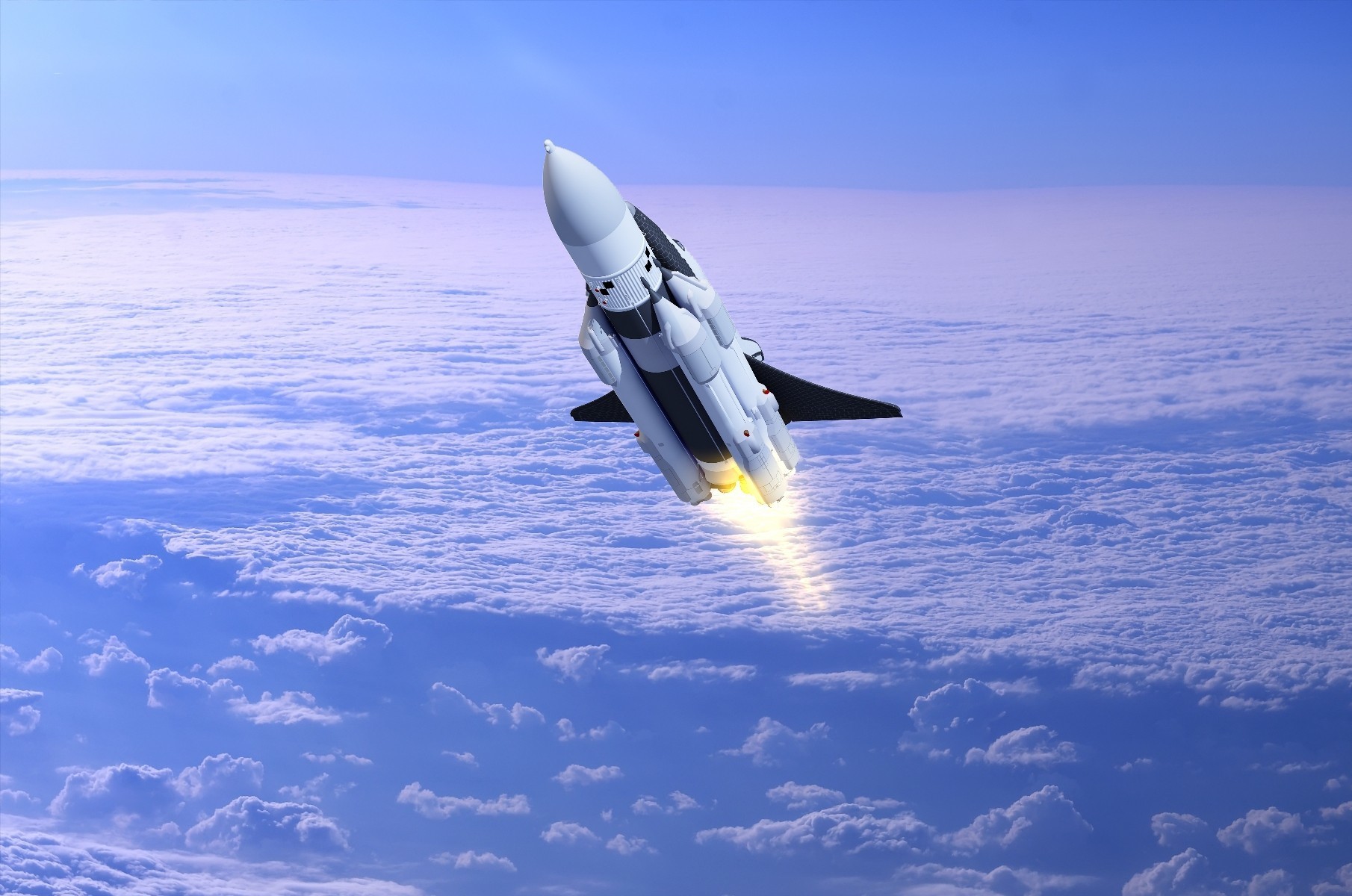
When will space tourism happen?
Sooner than you think. According to Forbes , Virgin Galactic’s successful trip means the company could start sending civilians up into space as soon as early 2022. Likewise, Blue Origin, which has a Federal Aviation Administration licence for human space travel through August 2021, could officially enter the space tourism game by early 2022.

How much will it cost?
It’s not exactly clear at the moment, but there have been some indications. For example, Virgin Galactic began selling ticket reservations for US$250,000 and sold roughly 600, before a test crash in 2014 brought sales to a halt. They’re expected to start selling tickets again in 2022, but at a much higher price.
It was reported in 2018 that seats on Bezos’s Blue Origin would also cost in the ballpark of US$200,000 to US$300,000, but that could change given how high demand is. At a recent auction, the winning bid for a seat aboard the company’s first spaceflight was a whopping US$28 million .
The bottom line is, those hoping to take a trip around the stars will either need to know someone or have hundreds of thousands (likely even millions) of dollars to spare.
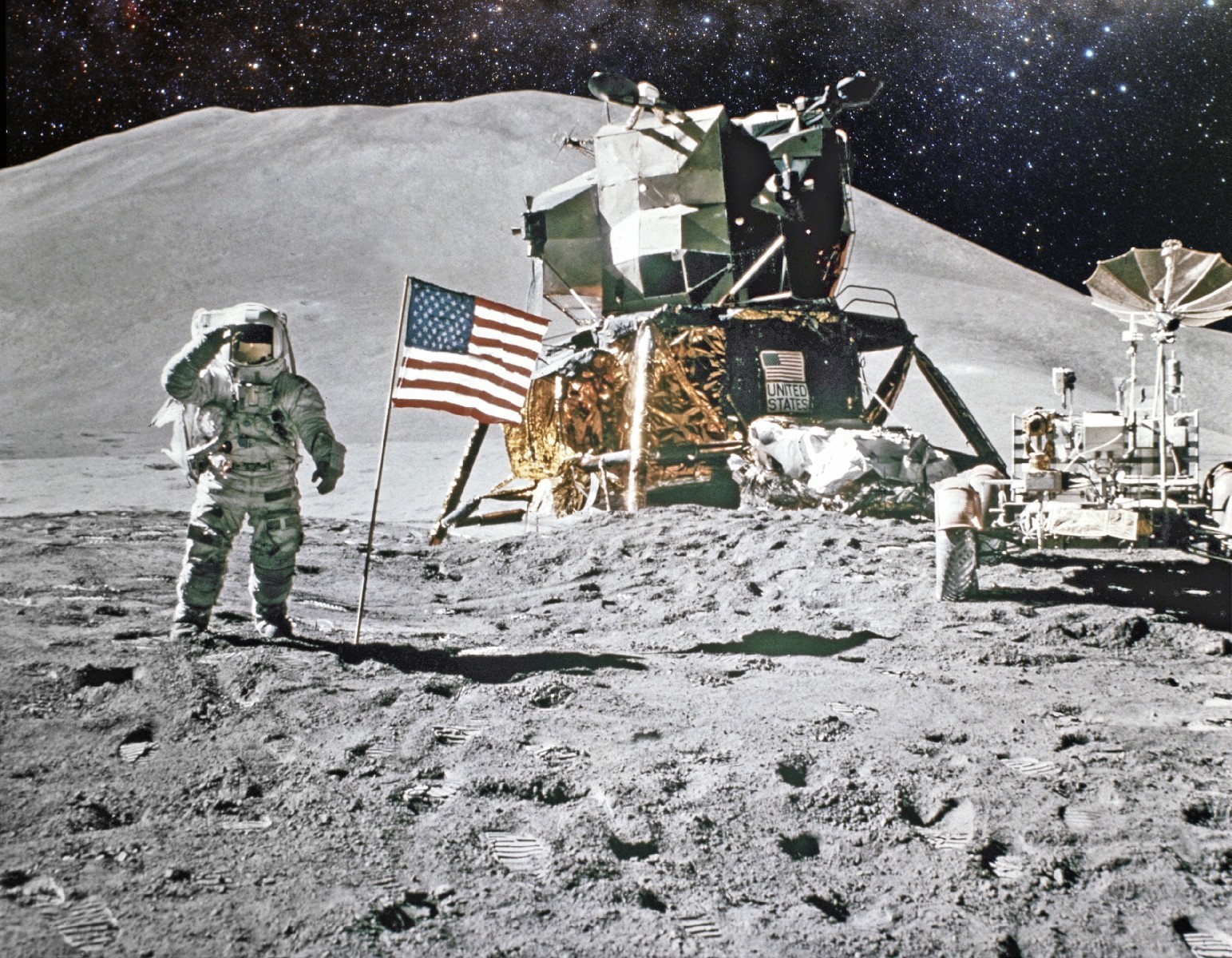
How do we get there?
The development of space tourism vehicles is still an ongoing project.
But a few options already exist, like Virgin Galactic’s spaceplanes that can carry up to eight people, or SpaceX’s Dragon spacecraft , launched by the Falcon Heavy rocket.
Blue Origin’s New Shepard looks more like a regular rocket that takes off and lands vertically, but also claims to offer the biggest windows of any spacecraft—a good selling point. It comfortably sits six people and is fully autonomous, meaning no pilot onboard.
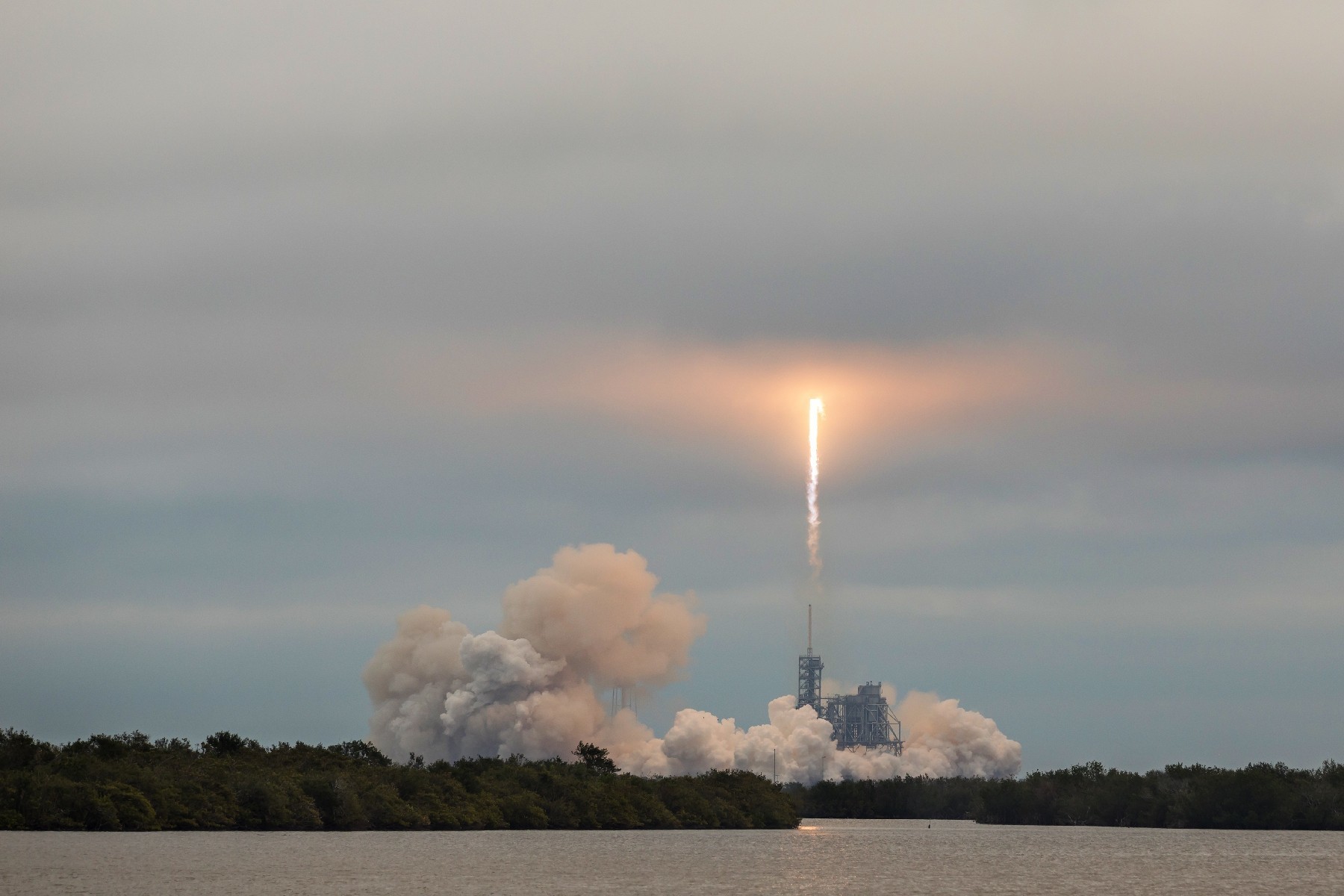
What does it feel like?
Needless to say, travelling to space is no walk in the park.
You’re eager to experience the joys of floating in microgravity? You better also get prepared to endure several physical discomforts: nausea and sea sickness, dizziness, headache, disorientation, puffy face, and bloodshot eyes.
But astronauts and previous space tourists agree that the body adjusts fairly quickly, getting used to its spatial environment in about three days.
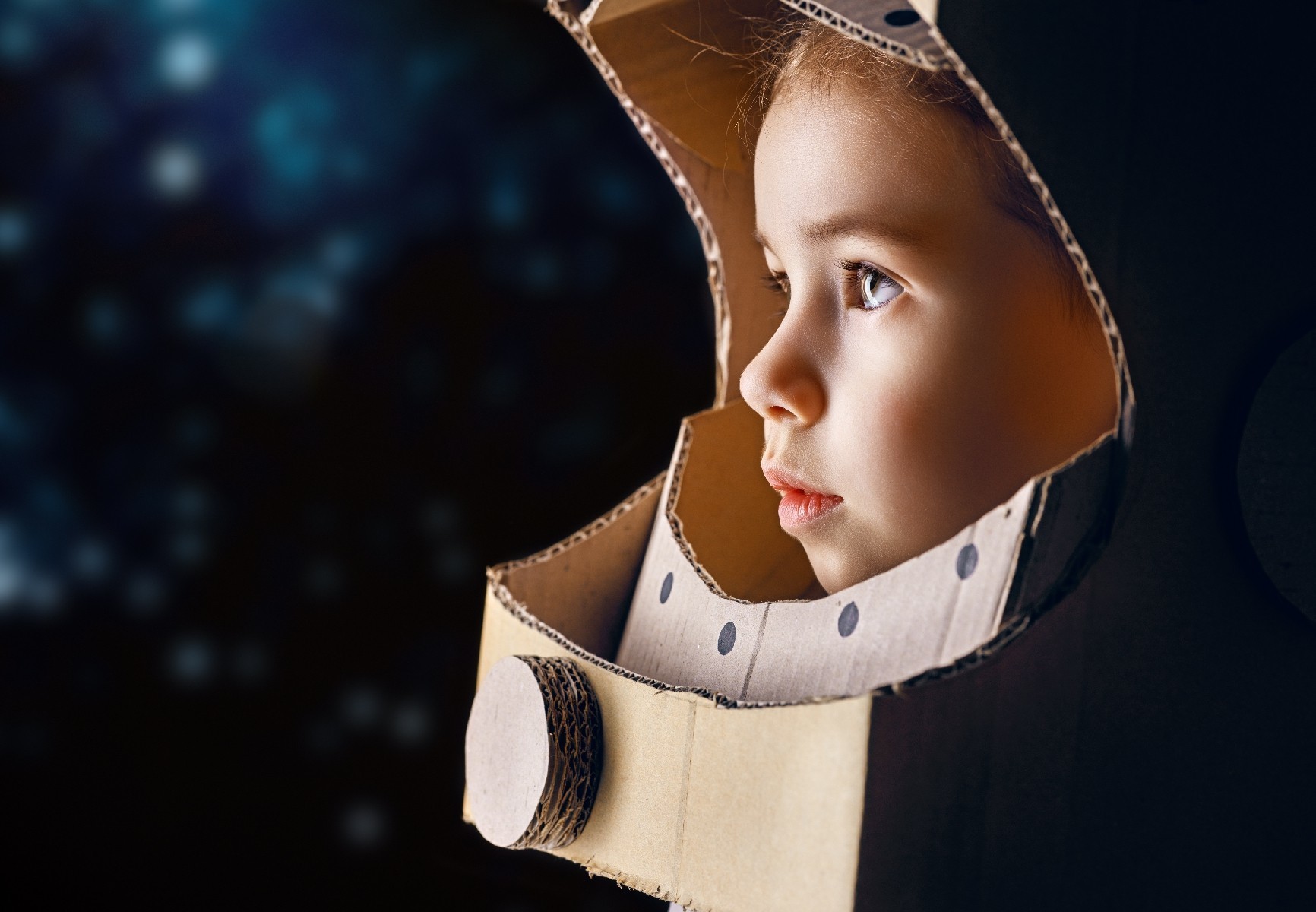
Is it safe?
Safety is a reasonable concern , considering the many hazards involved in space travel: the probability of a crash, exposure to cosmic radiation, and even unknown dangers that could emerge with this new industry. But here is the real question for any adventurer: is the thrill worth the risk?

What is the food like?
For many tourists, food is a crucial criterion for a successful vacation. But outer space is no place for gourmets, at least not yet. Interstellar tourists can expect to enjoy mostly canned, modified, and pre-packaged meals (such as space burritos and freeze-dried ice cream). But soon, thanks to NASA’s veggie farm , space tourists might be able to savour space-grown salads.
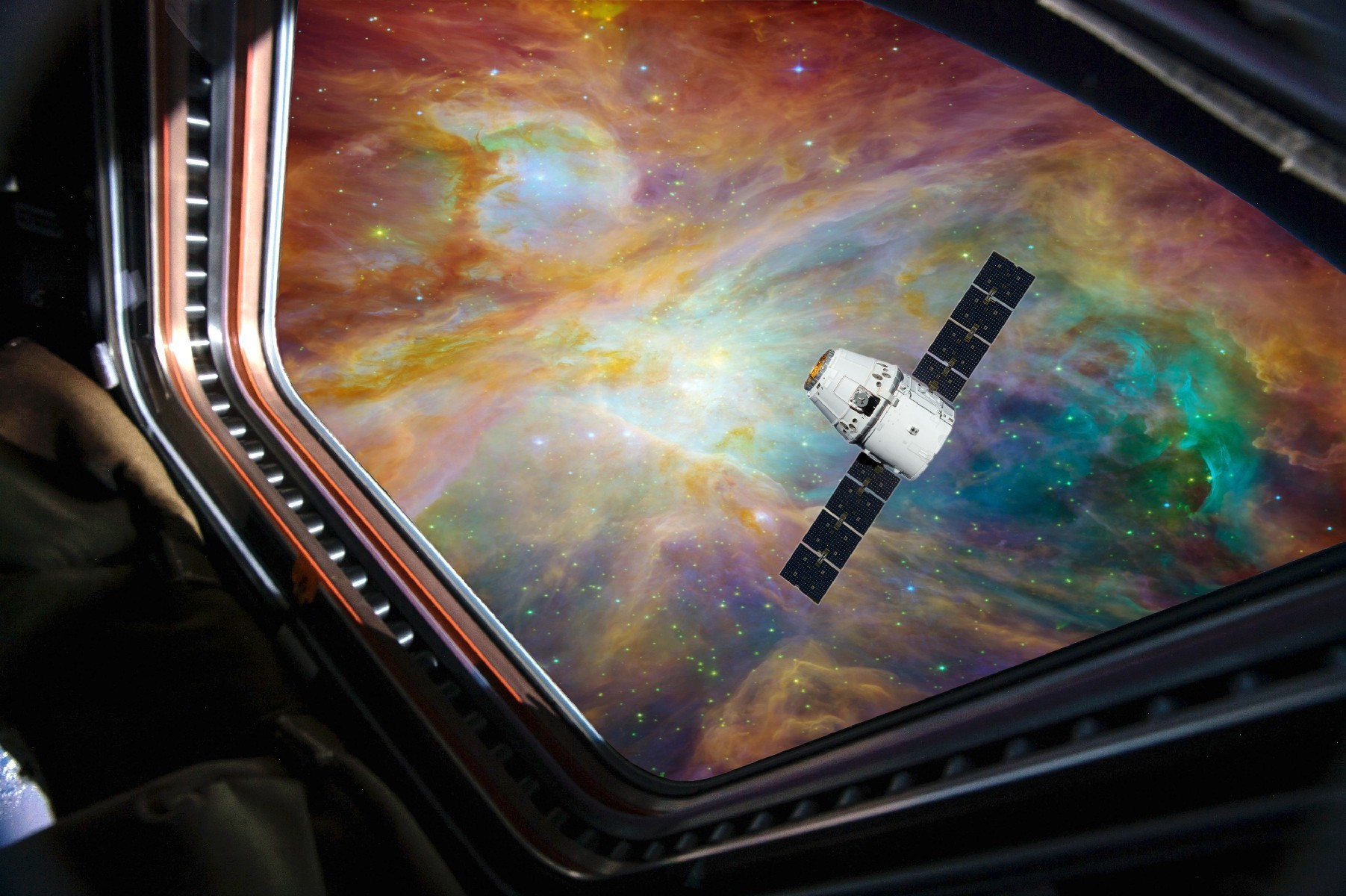
What about the accommodations?
Orbital space travel allows you to stay up there for a few days or even weeks. At that point, you might want to stretch your legs outside of the spacecraft, right? Well, in the future, space stations could be used as hotels: the Genesis inflatable habitats by Bigelow Aerospace and the Space Island Project are existing examples. Make sure to book a room with a view of planet Earth!
How to pack a space suitcase?
Packing a suitcase for a trip through the cosmos is actually less of a headache than doing so for a weekend vacation on Earth. Just keep in mind that it’s impossible to do laundry in space, so pack clothes accordingly : stock up on underwear, light clothing (space station temperature is controlled at about 22 degrees Celsius, or 72 degrees Fahrenheit), and exercise outfits. Outerwear will be provided: an orange suit for takeoff and re-entry, and a white one for potential space strolls.
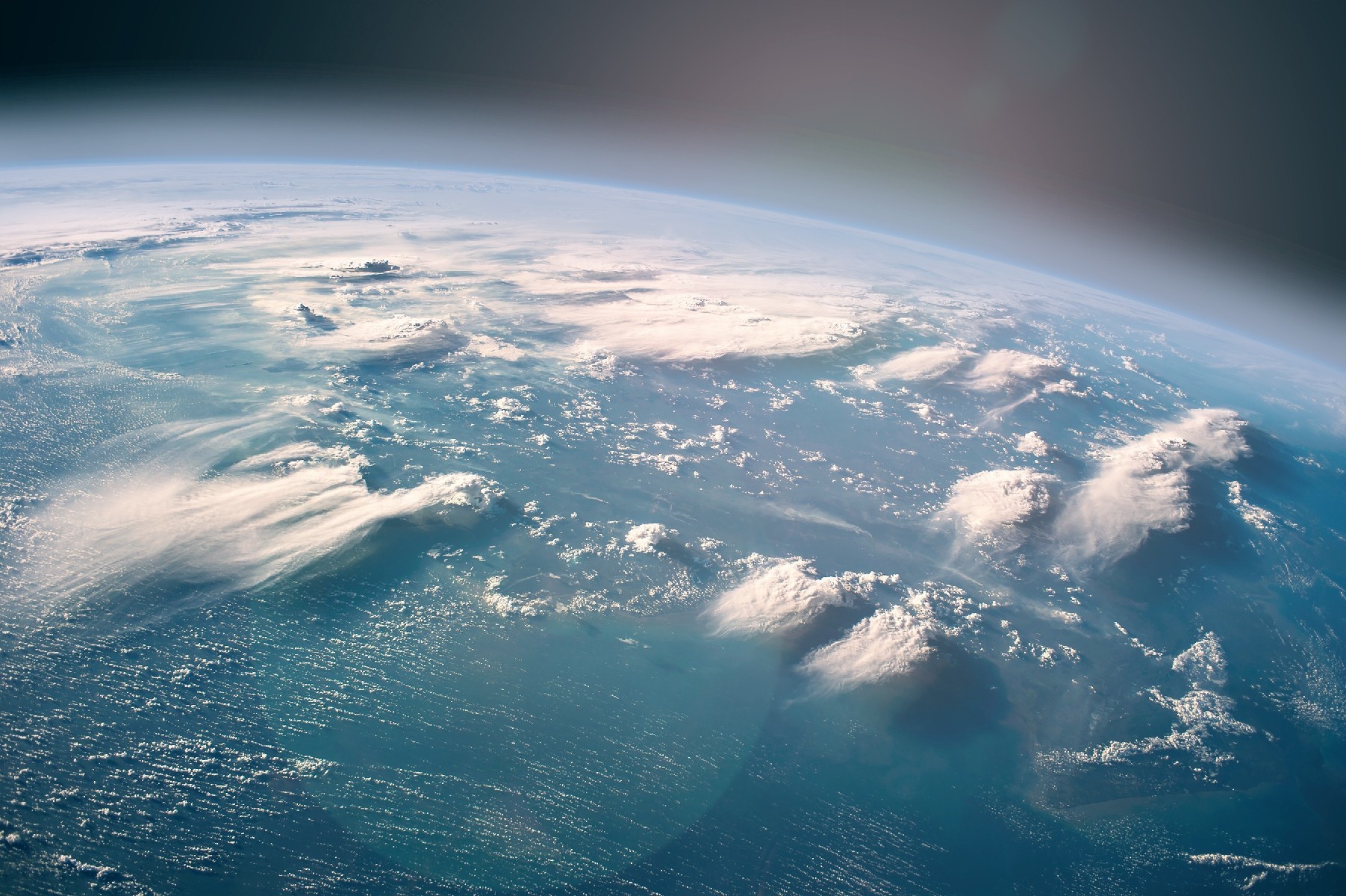
Is it eco-friendly?
With ecotourism being a growing trend and concern over the last few years, the question is legitimate. Well, bad news: space travel could have a negative impact by accelerating global warming . This would be caused by the black carbon released into the stratosphere after suborbital launches. But of course, entrepreneurs in the industry claim that the carbon footprint of space tourism would be minimal. The truth is, rockets emit 50 to 100 times more CO₂ per passenger than a regular flight. Considering that Virgin Galactic plans to do 400 trips per year, that’s a lot of CO₂ entering the atmosphere.
More for You
Actor Chance Perdomo dies in motorcycle accident
This is the easiest way to peel hard-boiled eggs
10 Hiding Spots Burglars Always Look First
Patriots special teams ace announces retirement
MoD admits rocket launchers and machine guns are among arsenal of missing weapons
All Couples That Last Do These 5 Things, According to a Relationship Coach
Putin Friend Predicts Nuclear Strike 'Most Likely' Coming
The Clever Toothpick Hack That'll Keep Your Dishwasher Working Like New
25 legendary musicians you might not know were LGBTQ+
13 Polite Habits That Fast-Food Employees Secretly Dislike
Farewell — and good riddance — to the 'typical American family'
'Sanford and Son': The Cast Through The Years
Michael Cohen Says Donald Trump Has 'Goal' When Attacking Judges
Two federal bank advisers resign over approval of financing $500 million for controversial project: 'We cannot afford [this]'
16 Coolest Small Towns in the U.S. You’ve Never Heard Of
If you and your partner use any of these 5 phrases regularly, your relationship is stronger than most
10 Things You Should Never Clean with a Mr. Clean Magic Eraser
I Tried the 9 Most Popular Pop-Tarts Flavors—This 1 Is Hands Down the Best
19 Things Parents Did in the ‘50s & ‘60s That They Could Never Do Today
Dramatic video appearing to show a flaming Russian Su-27 jet crashing into the Black Sea shot down by own side, Ukraine says

VIDEO
COMMENTS
This timeline of spaceflight may require cleanup to ensure consistency with other timeline of spaceflight articles. See Wikipedia:WikiProject Spaceflight/Timeline of spaceflight working group for guidelines on how to improve the article. Details. 1979 in spaceflight. The Skylab space station, which decayed from orbit on 11 July. Orbital launches.
Timeline of space exploration. This is a timeline of space exploration which includes notable achievements, first accomplishments and milestones in humanity's exploration of outer space . This timeline generally does not distinguish achievements by a specific country or private company, as it considers humanity as a whole.
Mar 21, 2024. Article. On March 24, 1979, space shuttle Columbia arrived at NASA's Kennedy Space Center (KSC) for the very first time. Following Presidential direction to build the space shuttle in 1972, Congress quickly approved and funded the program later that year. Construction of the first orbital vehicle, later named Columbia, began in ...
Here's how it works. Timeline: 50 Years of Spaceflight. On Oct. 4, 2007, the Space Age celebrated the 50th anniversary of the historic launch of Sputnik, the first artificial satellite, by the ...
The Solar Maximum Mission, or "SolarMax," was lofted into space by a Delta rocket Feb. 14, 1980, embarking on a flight to study our sun during the peak of the solar cycle. The first launch of the space shuttle on April 12, 1981, became an iconic moment for NASA and for the nation. Columbia's launch plume was a welcome sight to the Kennedy ...
On July 9, 1979, Voyager 2 made its closest approach to Jupiter, flying within 350,000 miles of the planet's cloud tops. On the outbound leg of its encounter, it imaged the satellite Io (closest approach of 702,200 miles), and conducted a 10-hour volcano watch of the moon, confirming Voyager 1's finding that it harbored active volcanoes.
Discover the dates and details for milestones in space exploration from the years 1971 through 1980, including the first space station, the Apollo-Soyuz project, and the Voyager encounters with Jupiter and Staurn ... September 1, 1979. First Images of Saturn. The U.S. space probe Pioneer 11 reaches Saturn, flying within 13,000 miles (21,000 ...
The first manned mission of the Space Transportation System (STS-1), Columbia, is launched. This first flight carries a crew of two. They are mission commander John W. Young and pilot Robert L. Crippen. This mission, as well as the next three, will be a test flight to try out the spacecraft's systems. Columbia successfully orbits the Earth 36 ...
April 9-Oct. 11, 1980. new space endurance record (184 days 20 hours) Valery Ryumin. Soyuz 36/Salyut 6/Soyuz 35. U.S.S.R. Valery Kubasov. May 26-June 3, 1980. first Hungarian astronaut (Farkas) Bertalan Farkas.
new space endurance record (175 days 1 hour) Valery Ryumin. Soyuz 33. U.S.S.R. Nikolay Rukavishnikov. April 10-12, 1979. first Bulgarian astronaut (Ivanov) Georgy Ivanov. Space exploration - Apollo, Skylab, Salyut: Crewed spaceflights during the 1970s are listed chronologically in the table.
The docking unit was scheduled to be delivered to the Kennedy Space Center by August, 1979 for a Space Shuttle flight scheduled for September, 1979. Due to development delays, the September, 1979 Space Shuttle flight would be the third, not the fifth as envisioned. ... (AOA), in which the Orbiter could travel once around the Earth before making ...
Voyager 1 is the first spacecraft to travel beyond the solar system and reach interstellar space . The probe launched on Sept. 5, 1977 — about two weeks after its twin Voyager 2 — and as of ...
Information about the United States space flight programs, including NASA missions and the astronauts who participate in the efforts to explore Earth s galaxy. Contents: NARA Resources Finding Aids ... 1979. March and August - Voyagers 1 and 2 began transmitting images of Jupiter and her moons. September - The U.S. probe Pioneer 11 reached ...
The strong hold that space travel has always had on the imagination may well explain why professional astronauts and laypeople alike consent at their great peril, in the words of Tom Wolfe in The Right Stuff (1979), to sit "on top of an enormous Roman candle, such as a Redstone, Atlas, Titan or Saturn rocket, and wait for someone to light the ...
The Evolution of Space Travel: Then and Now. Replicas of the Apollo 11 Space Suit and the Apollo 16 EMU Space Suit. ... Richard Nixon Presidential Library and Museum, National Archives and Records Administration, 1979.12. Four days later, the President welcomed home the Apollo 11 crew in person aboard the USS Hornet in the Pacific Ocean. The ...
13 February 2023. How NASA's breakthrough 'class of '78' changed the face of space travel. The inclusion of women and people of colour in NASA's astronaut cadet programme was ...
Title: "Alien" (1979) Showing: July 30, 7 p.m., Phipps IMAX Theater. Accuracy of science: Reasonable. Scientist reviewer: Paula Cushing, curator of invertebrate zoology. Discipline ...
The Space Movie: Directed by Tony Palmer. With Buzz Aldrin, Neil Armstrong, Mike Collins, Yuri Gagarin. A musical journey through our solar system to the far reaches of the universe.
Carter Burke makes the comment during Ripley's dream that her escape shuttle drifted outside of the space lanes, implying that there are normal travel routes through space in the Alien universe. This again would require FTL (faster than light) travel to even be possible. Burke tells Ripley that contact was lost the colonists on LV-426.
In real life, however, she finds the time commitment of space travel, especially the intergalactic type, quite off-putting. ... (who also directed the original 1979 "Alien" and the 2015 smash hit ...
Origins of 21st Century Space Travel: A History of NASA's Decadal Planning Team and Vision for Space Exploration, 1999-2004: Asner, Glen and Stephen Garber: ... Nose Up: High Angle-of-Attack and Thrust Vectoring Research at NASA Dryden 1979-2001: Wallace, Lane and Christian Gelzer: 2009: Flight Research; Dryden/Armstrong Flight Research Center:
Fast-forward to 2024 and Ulam's nuclear daydreaming is enjoying a renaissance of sorts as the Netflix series The Three-Body Problem, based on a novel by Chinese sci-fi author Liu Cixin, cribs ...
Revolutionizing Space Travel. Musk's Starship represents the zenith of next-generation rocket systems, designed with the lofty goals of human orbit, lunar missions, and beyond. Its role in NASA ...
55 years later, Stanley Kubrick's vision of technology, space travel, and AI remains prescient. Stanley Kubrick's 2001: A Space Odyssey is free to own in 4K digital if you snag it through ...
JSC/NASA. The space shuttle Challenger disaster that occurred on January 28, 1986, marked one of the most devastating days in the history of space exploration. Just over a minute after the space shuttle lifted off, a malfunction in the spacecraft's O-rings—rubber seals that separated its rocket boosters—caused a fire to start that destabilized the boosters and spread up the rocket itself.
Former NASA astronaut and International Space Station Commander Terry Virts can definitely say he saw an eclipse from space in 2015—and according to him, it was a sight to behold.
Airlines are aware that access to bins is competitive and frequently tout improvements that mean more space for rollaboards. In fact, just on Tuesday, United Airlines announced it was installing ...
Kennedy Space Center spent the 1970s bridging the achievements of the 1960s and the expectations of the 1980s. The center emerged from the decade as a place of adaptation and innovation. The 10-year span saw Kennedy help NASA reach farther into space than ever before. The center launched men to the moon five times, rescued a crew during an ...
First, any space travel begins with the Kármán line, which lies at 100 kilometres (62 miles) above sea level and is commonly accepted as the limit between Earth's atmosphere and outer space.
Underscored's travel writer Kyle Olsen reveals the tenents of airline etiquette from arrival times to personal space to security protocols for a smooth journey.